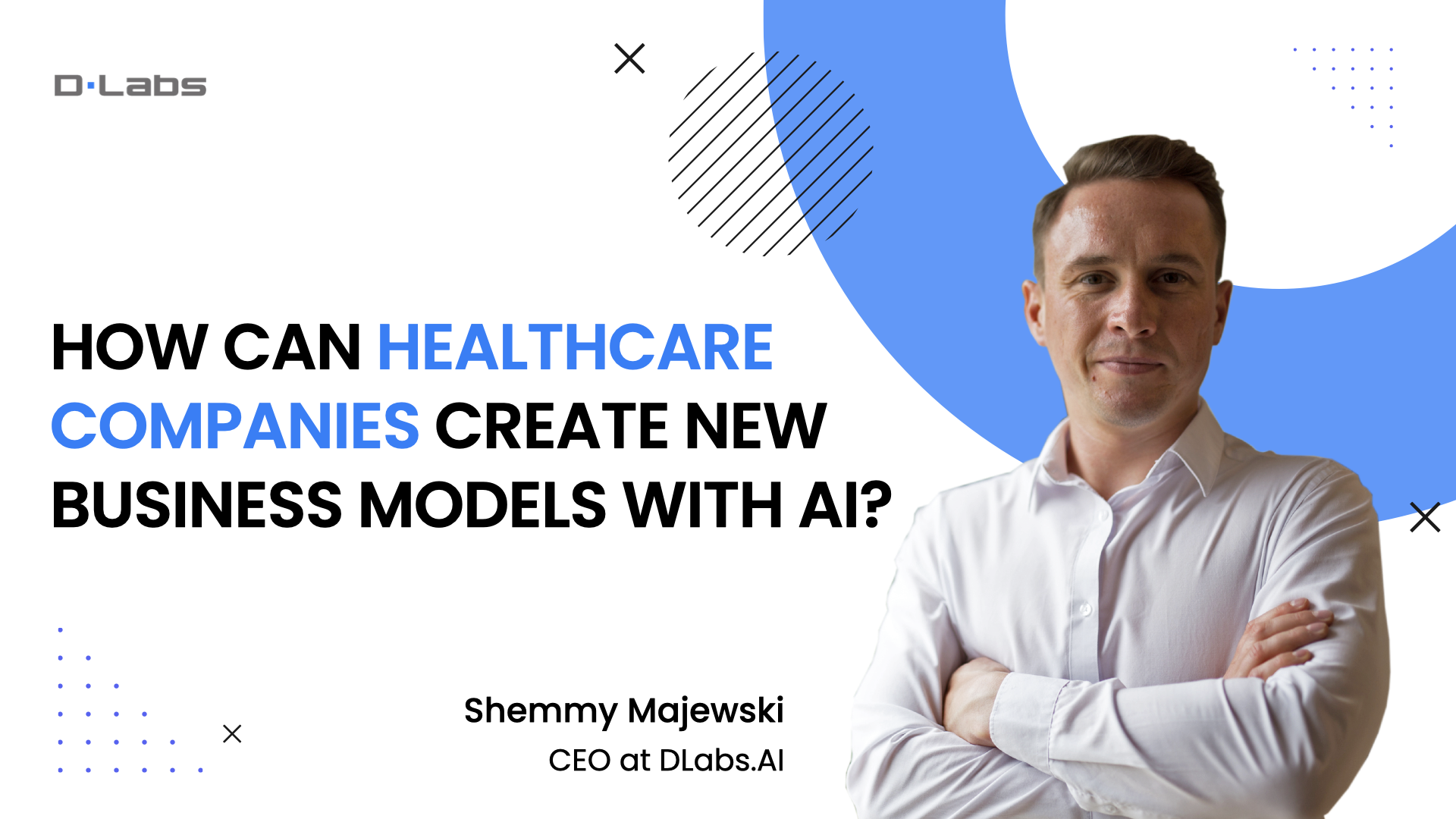
How can healthcare companies create new business models with AI?
Hello everyone!
Thanks for joining today’s webinar on how healthcare companies can create new business models with AI.
You can put on the chat where you are from and your name and meet with other people. I would like to emphasize that the webinar will be recorded, and I will send you a link to the recording. I will also share the presentation, where you’ll find the links to all sources I referred to during the presentation. And a couple of additional notes: my neighbor in the office decided to make some renovation today, so if there will be too much noise o your side, please let us know. We’ll try to act accordingly.
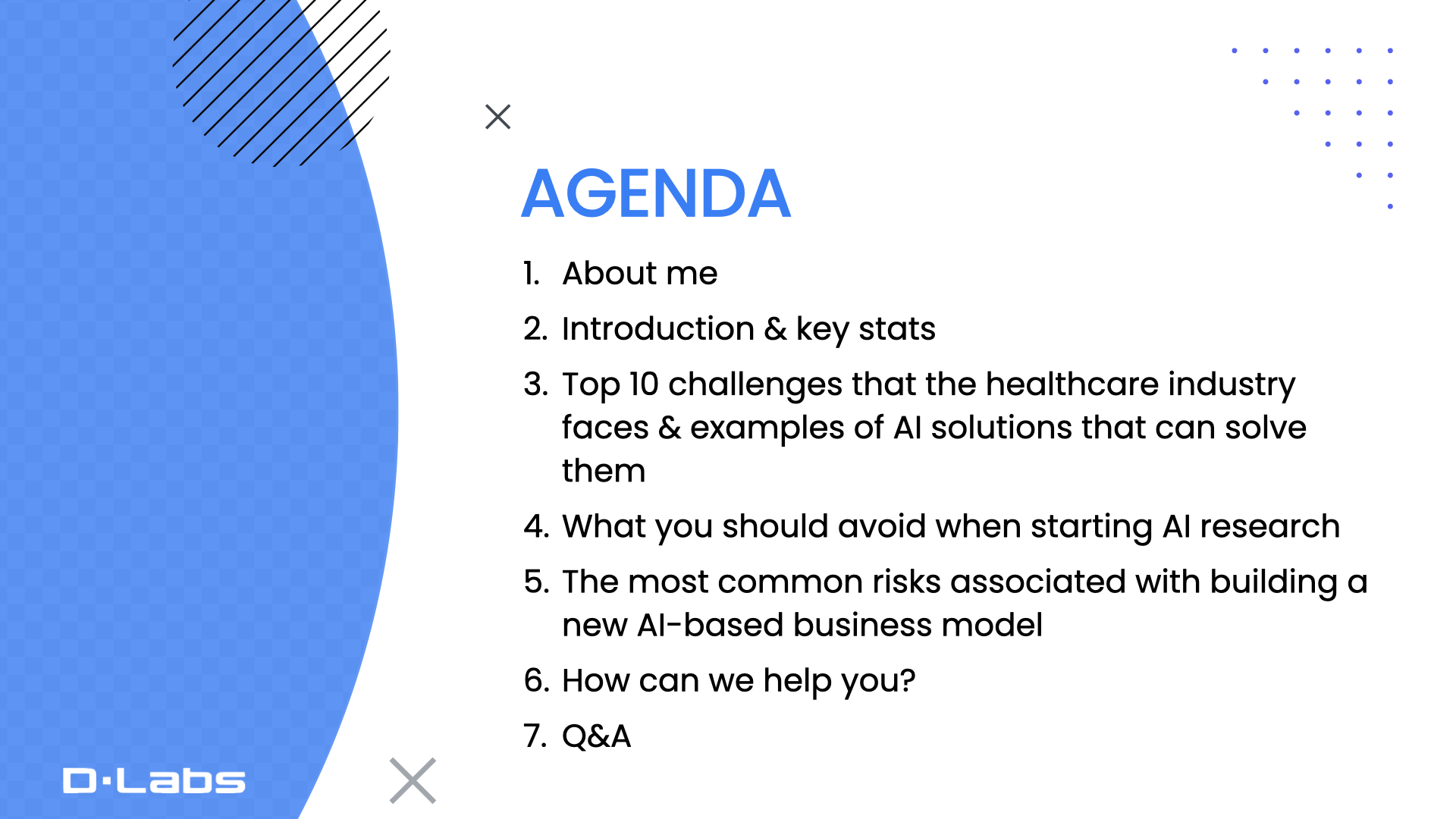
Agenda
Today’s agenda:
- I want to share with you some facts and key statistics about the healthcare industry from my research, along with the top challenges that the healthcare industry faces and examples of AI solutions that can solve them.
- What you should avoid when starting AI research.
- The most common risks associated with building a new AI-based business model in your company.
- And if we have some time and you have some questions, we will also take Q&A. If we cannot answer all of them on the webinar, we will send you follow-up emails sharing some additional notes and answers.
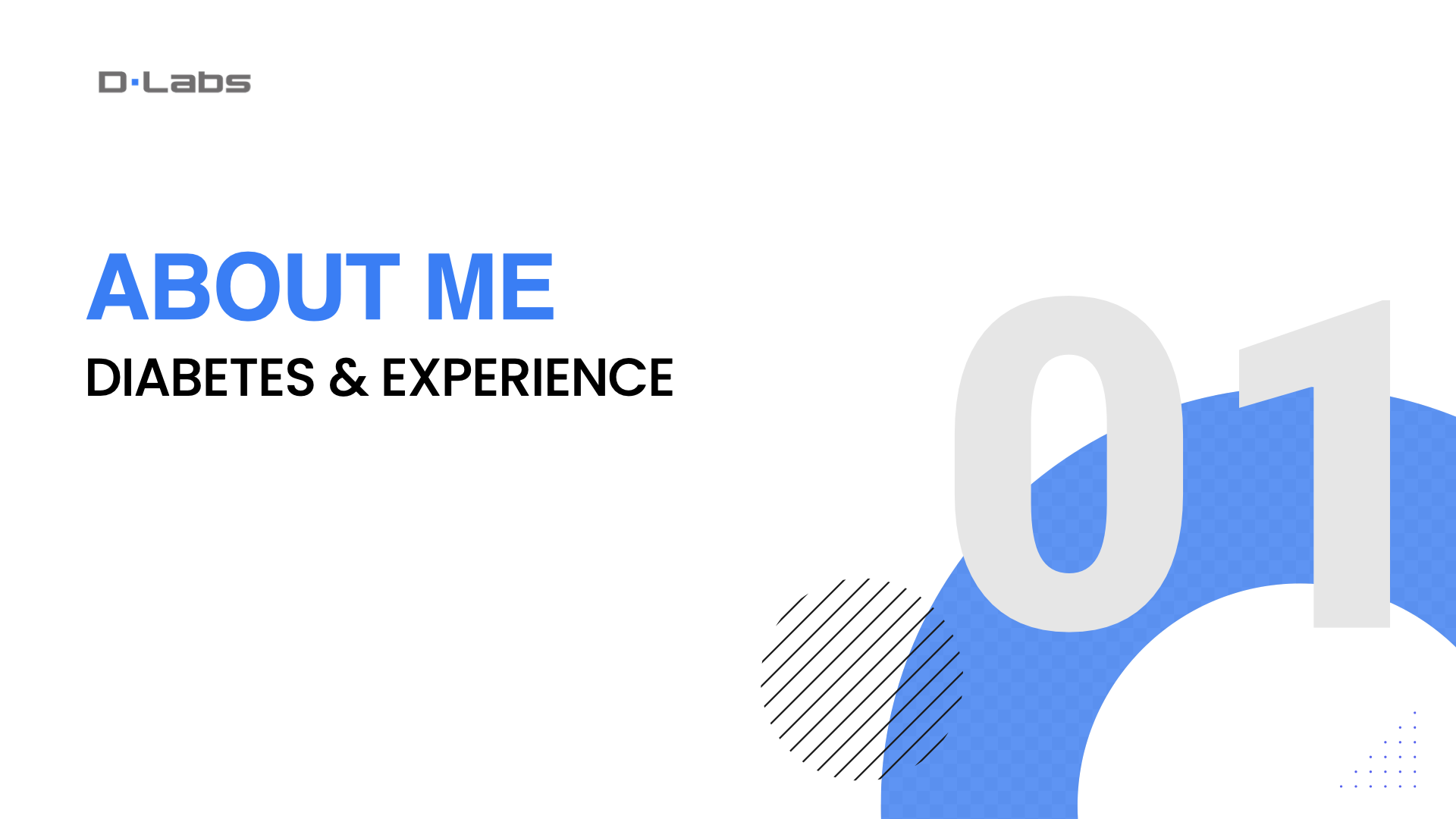
About me: diabetes & experience
Ok, let me start by introducing myself. My name is Shemmy which is a nickname I’m using because my polish name is Przemek/ Przemysław, which sounds similar to Shemmy. Still, the real name is hard to pronounce for people outside Poland, so I decided to use a nickname for easier conversation.
The topic of this webinar is very related to two factors that are very important in my life on a daily basis: first – the healthcare industry, and second – artificial intelligence.

Diabetes
At the age of ten, I was diagnosed with diabetes, and my life was turned upside down. How I experienced each day was based on continuous calculations. Data became the driver behind everything I ate, drank, and did.
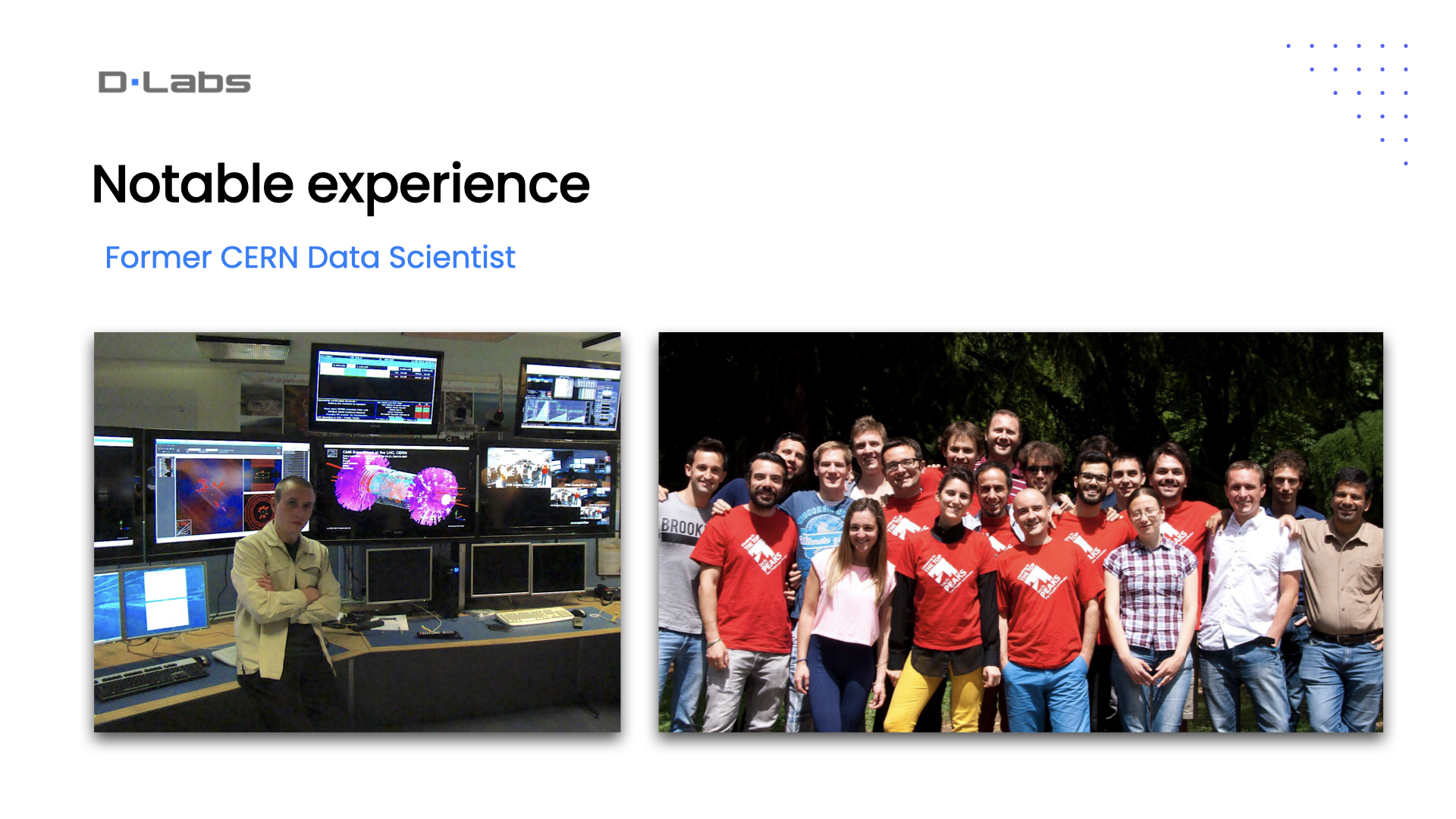
Notable experience
As I’ve grown older, I’ve only come to appreciate the power of data even more. I took on the role of Data Scientist at CERN to pursue my interest in the field.

I’ve since gone on to help found two companies: one is DiabetesLab Ltd. which works on the Suguard mobile application, using ML, AI, and Data Science to help those with diabetes.

And DLabs.AI – an AI company that uses AI and Machine Learning to help businesses improve workflows, drive efficiencies and discover new AI-based business models.
My team and I get to harness data to improve not only the lives of those with diabetes — but the lives and businesses of our global client base, as well. We use AI and ML to help businesses improve workflows, discover new business models, and drive efficiencies inside the internal processes if the company is more mature or built digital products in the case of startups.
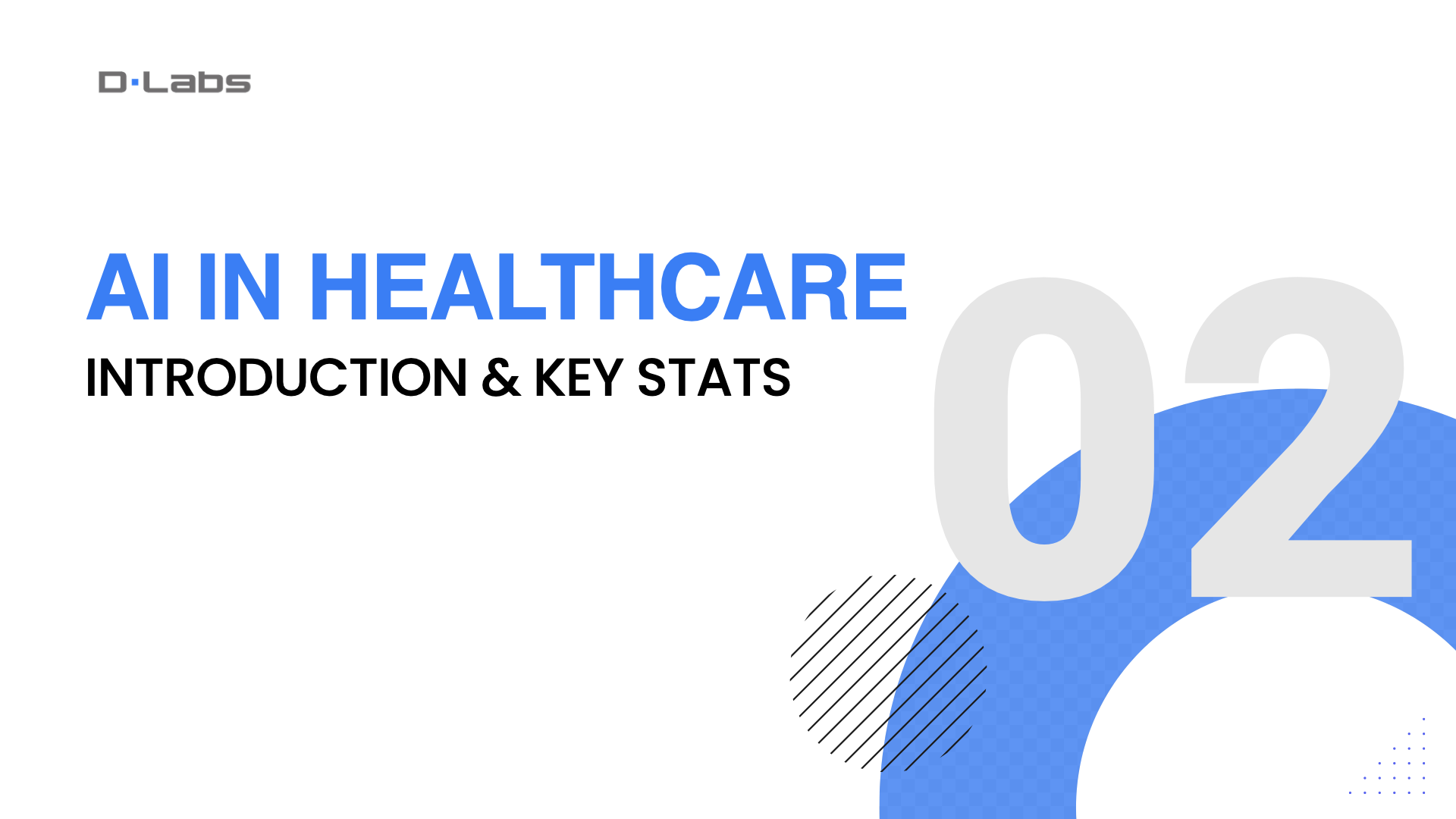
AI in healthcare: introduction & key statistics
Let’s start with some statistics which brilliantly demonstrate the importance of applying AI in the healthcare industry. I hope this will be helpful because I talked with some of you before the webinar, and I know that at least a couple of people are thinking about starting their new business in the space, so I hope this will also be helpful in terms of some inspiration.
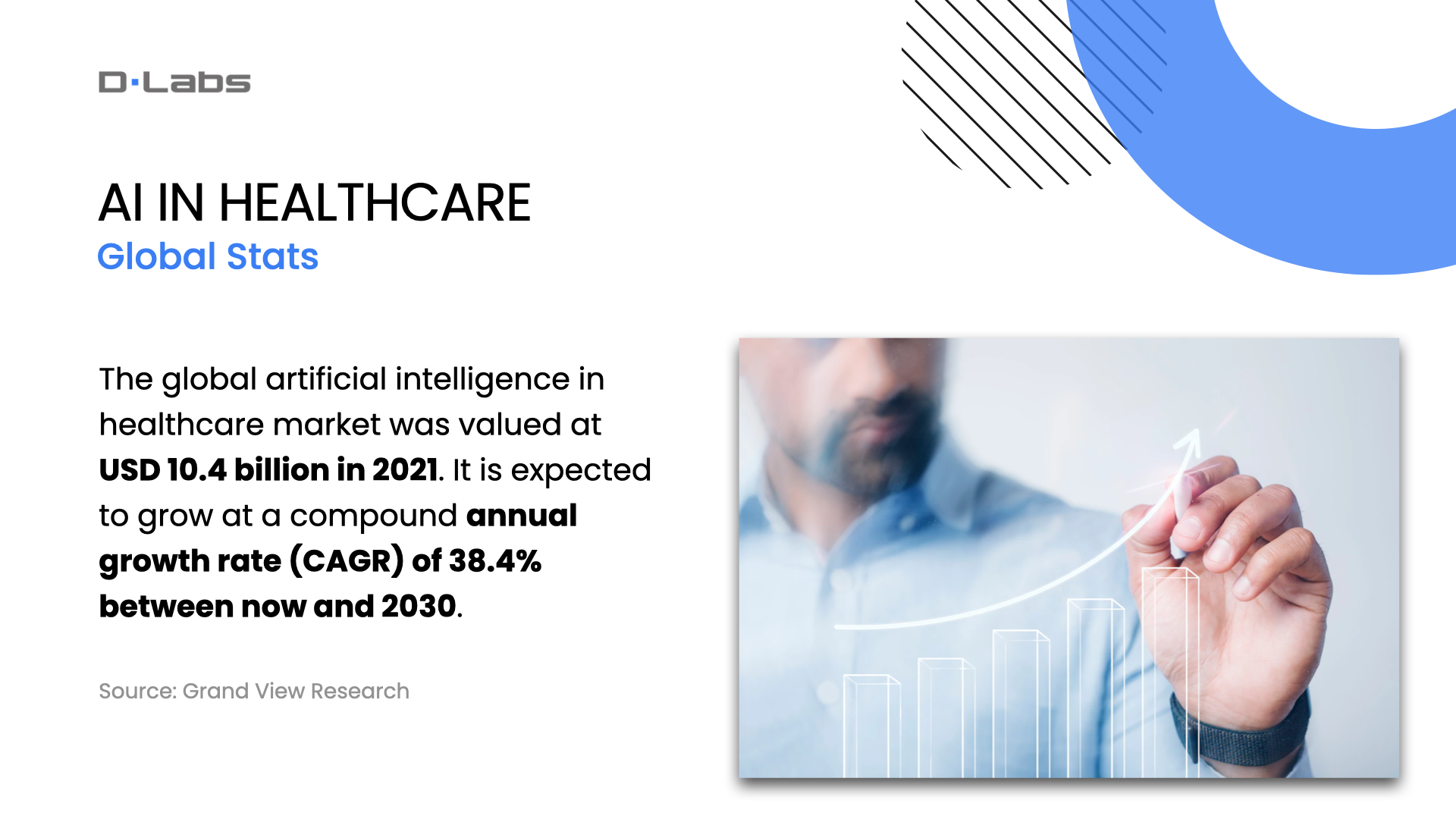
AI in healthcare: global stats
The global artificial intelligence in the healthcare market was valued at USD 10.4 billion in 2021 and is expected to grow at a compound annual growth rate (CAGR) of 38.4% from now to 2030.
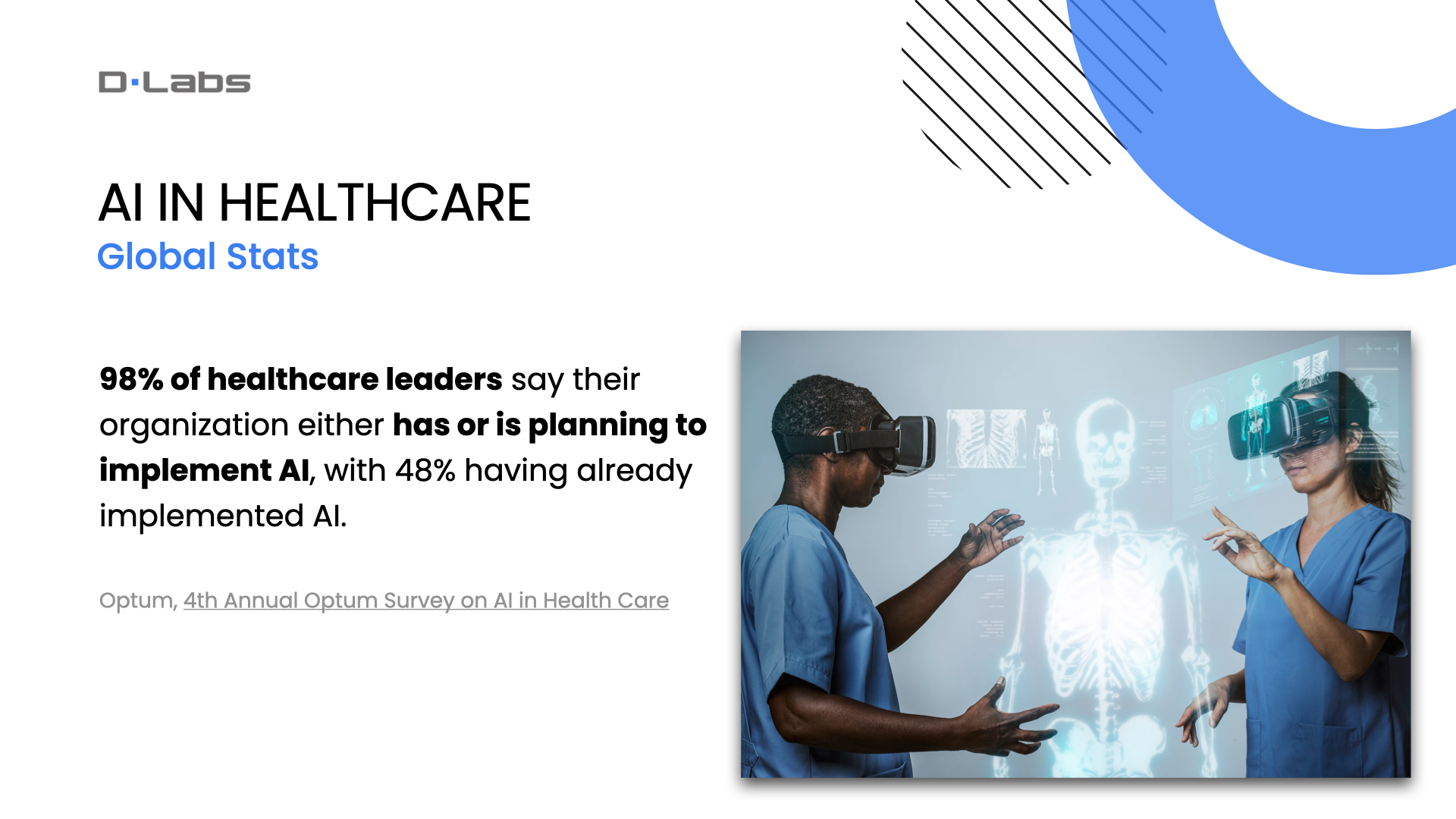
And what’s interesting is that 98% of healthcare leaders say their organization either has or is planning to implement AI, with 48% who have implemented AI in their space.
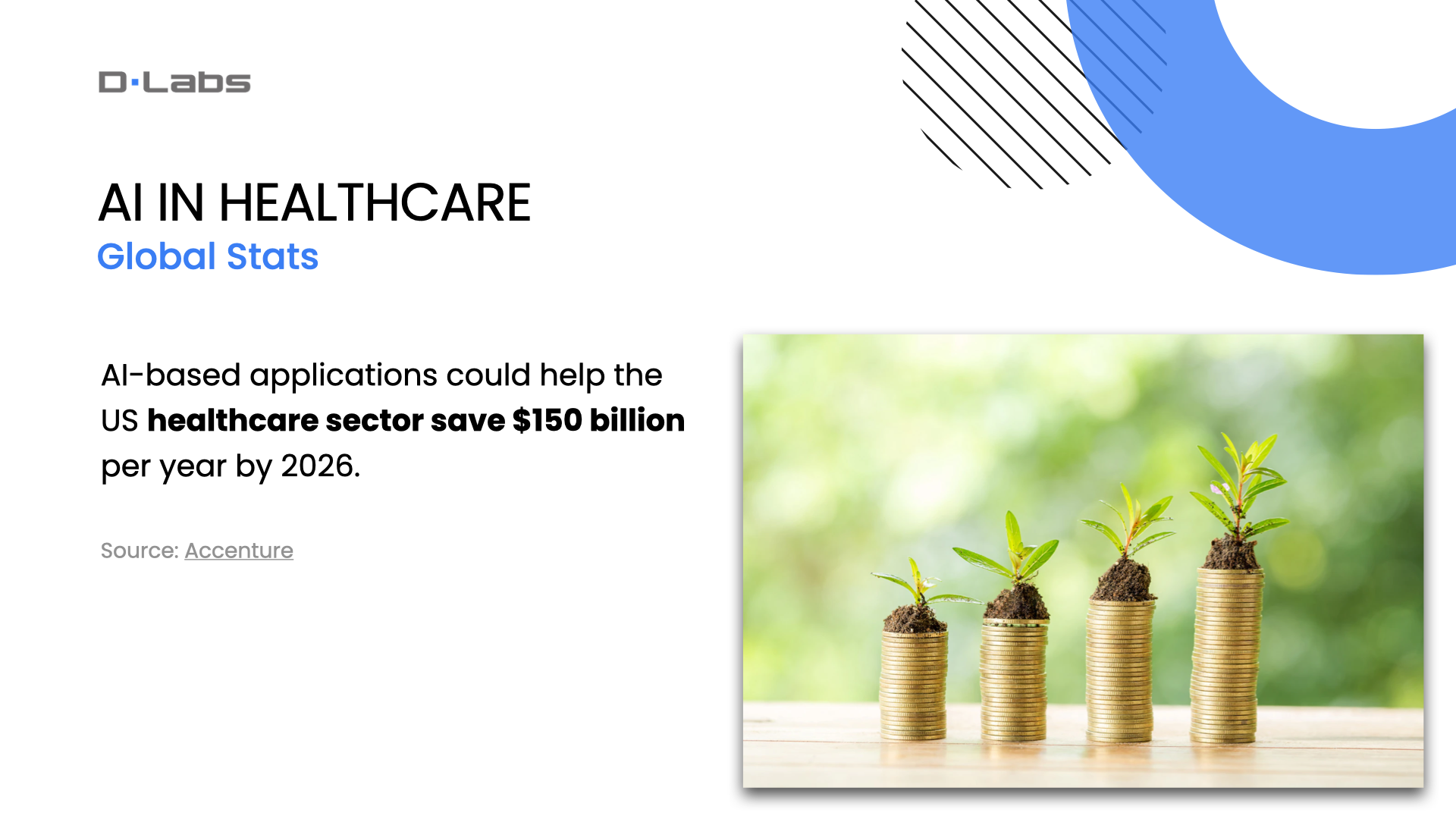
Ok, what about the money? Well, stats show that AI-based applications could help the healthcare sector save $150 billion per year by 2026. And I sided here data for the US only, but similar benefits are, of course, being known by other countries investing in AI.
As you can see, the development of AI in healthcare is not only necessary but inevitable.
If you’re wondering what value this technology can bring to your organization and what risks its implementation entails – I hope this webinar will answer your questions.

10 challenges in healthcare & how AI can solve them
First, I’d like to share with you my industry research and point out the most common problems or challenges facing the healthcare industry today. But it won’t be complaining! On the contrary, I will present an example of an AI-based solution that can deal with particular issues for each of these points.
Ok. Let’s get started!
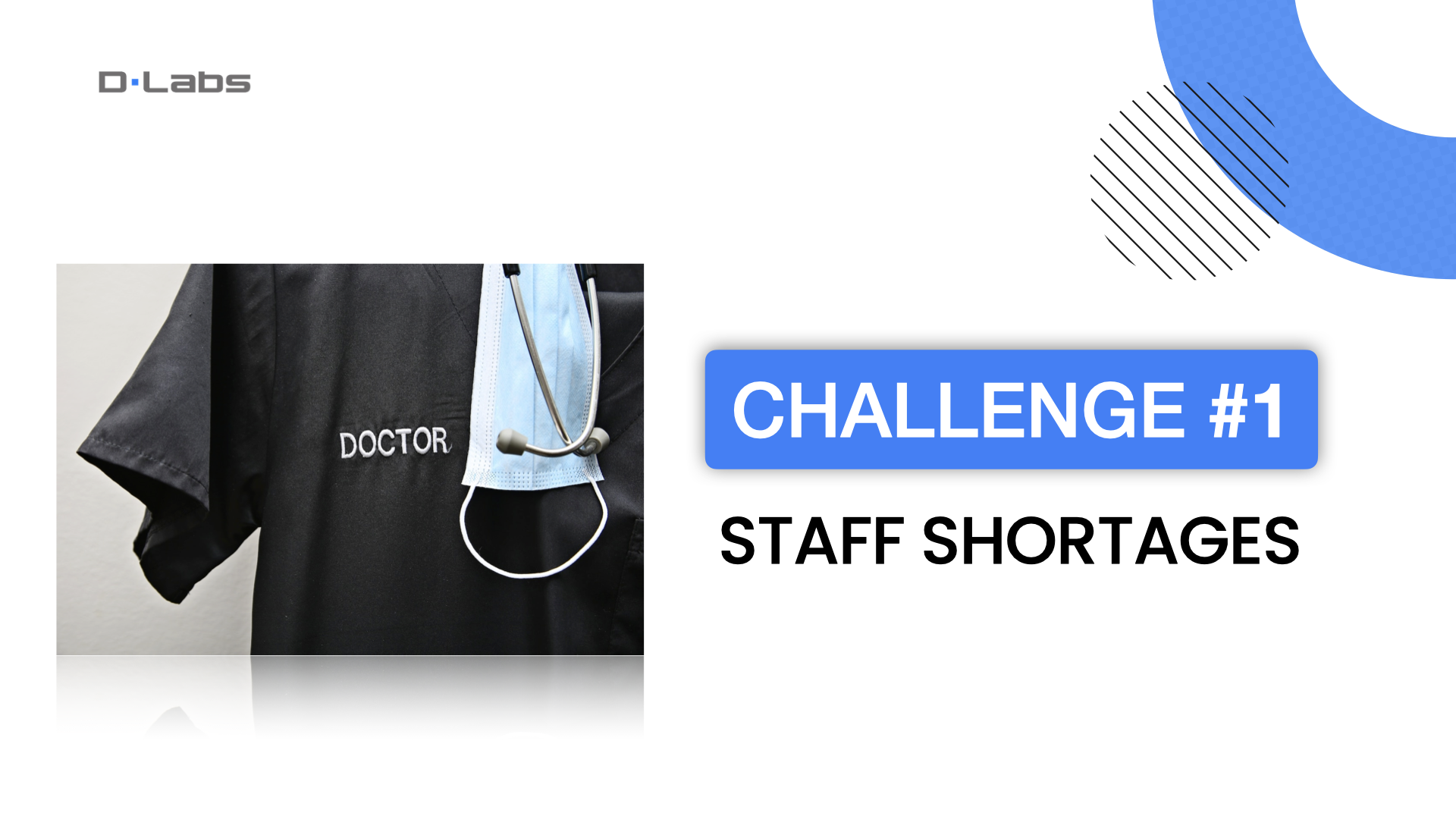
Challenge 1: Staff shortages
The first problem facing the health industry is staff shortages. You probably expected that I experienced that also with my diabetes.
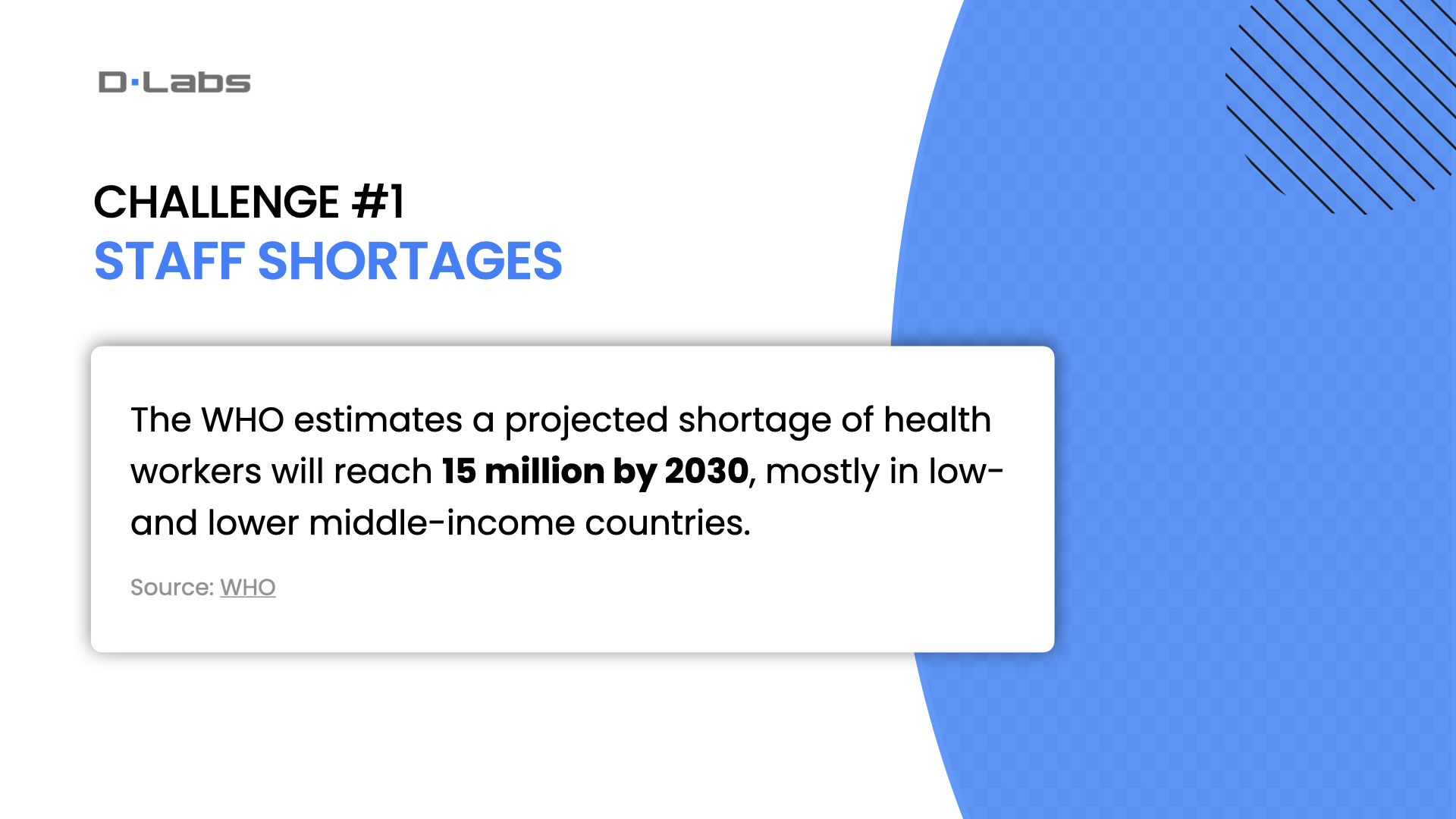
WHO estimates a projected shortfall of 15 million health workers by 2030, mostly in low- and lower-middle income countries.

And the challenge will continue to grow more urgent as the world’s population rapidly ages. The number of people aged 65 and older will more than double from about 700 million today to 1.5 billion by 2050.

Challenge 2: Employee burnout
The aforementioned staff shortages result in longer shifts for those currently employed in the industry. Despite additional funds being offered for longer shifts, healthcare employees have to face a mental strain, making this industry harder and harder to work in.
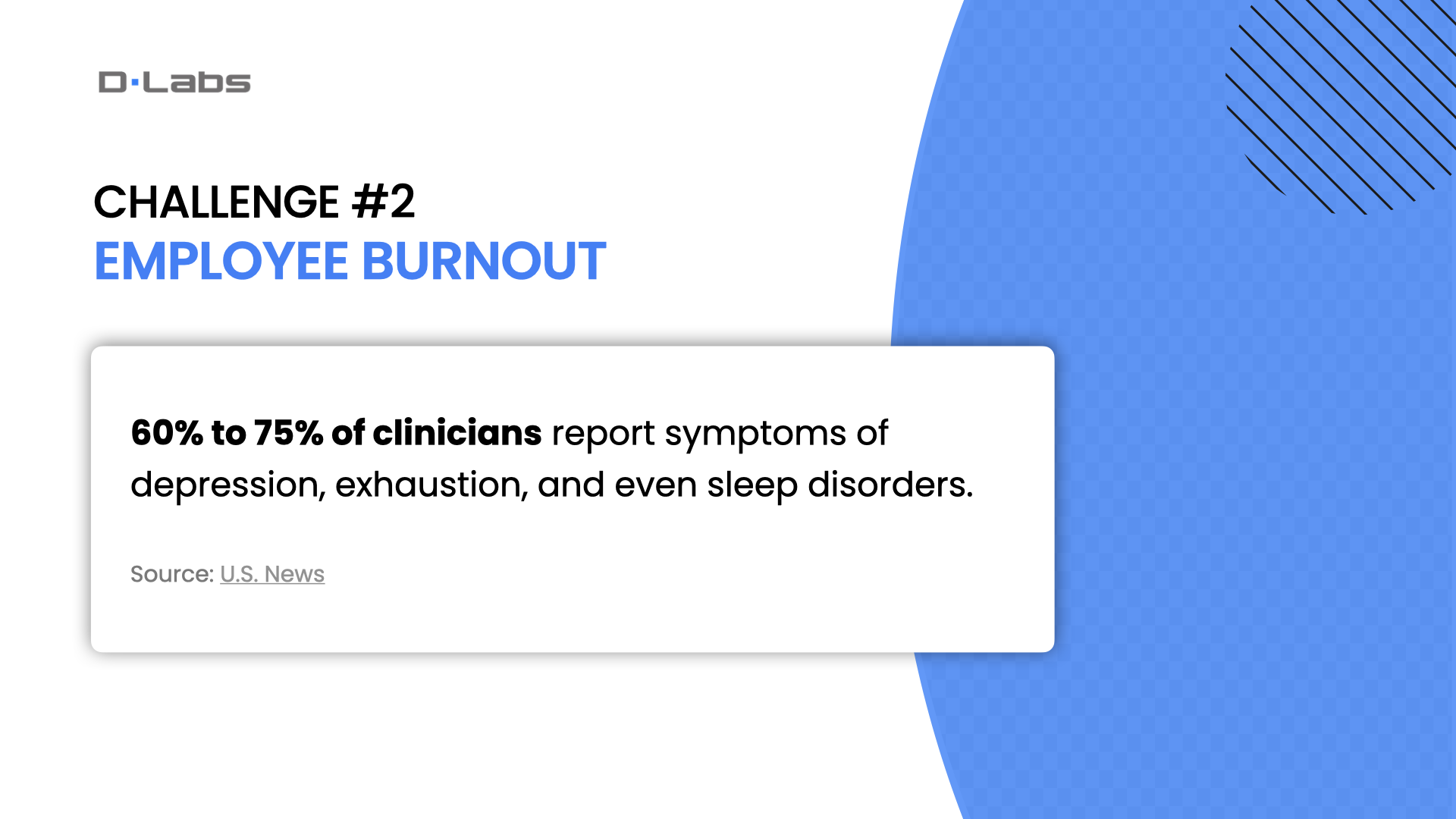
How serious is this challenge? Stats show that people in the healthcare industry—including physicians, nurses, nurses’ aides, and other employees—experience burnout more so than those in many other industries. According to U.S. News, 60% to 75% of clinicians report symptoms of depression, exhaustion, and even sleep disorders, so this is serious.
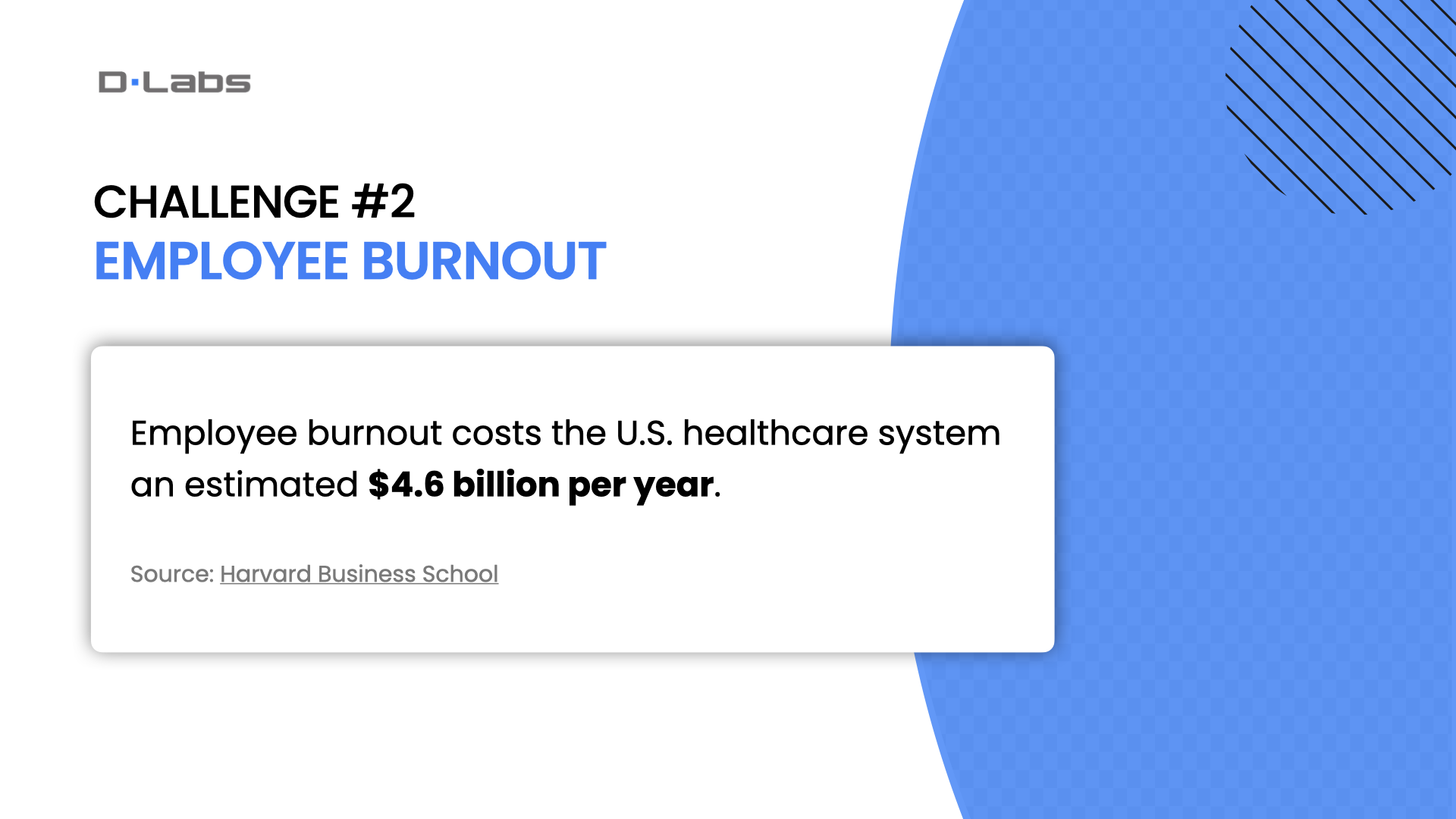
Further statistics prove that worker burnout costs this country a lot of money each year—the figure is a staggering $4.6 billion.
Clearly, finding a work-life balance is a great obstacle in such a demanding line of work, and hospitals and clinics need to find a solution that helps them to find the balance.
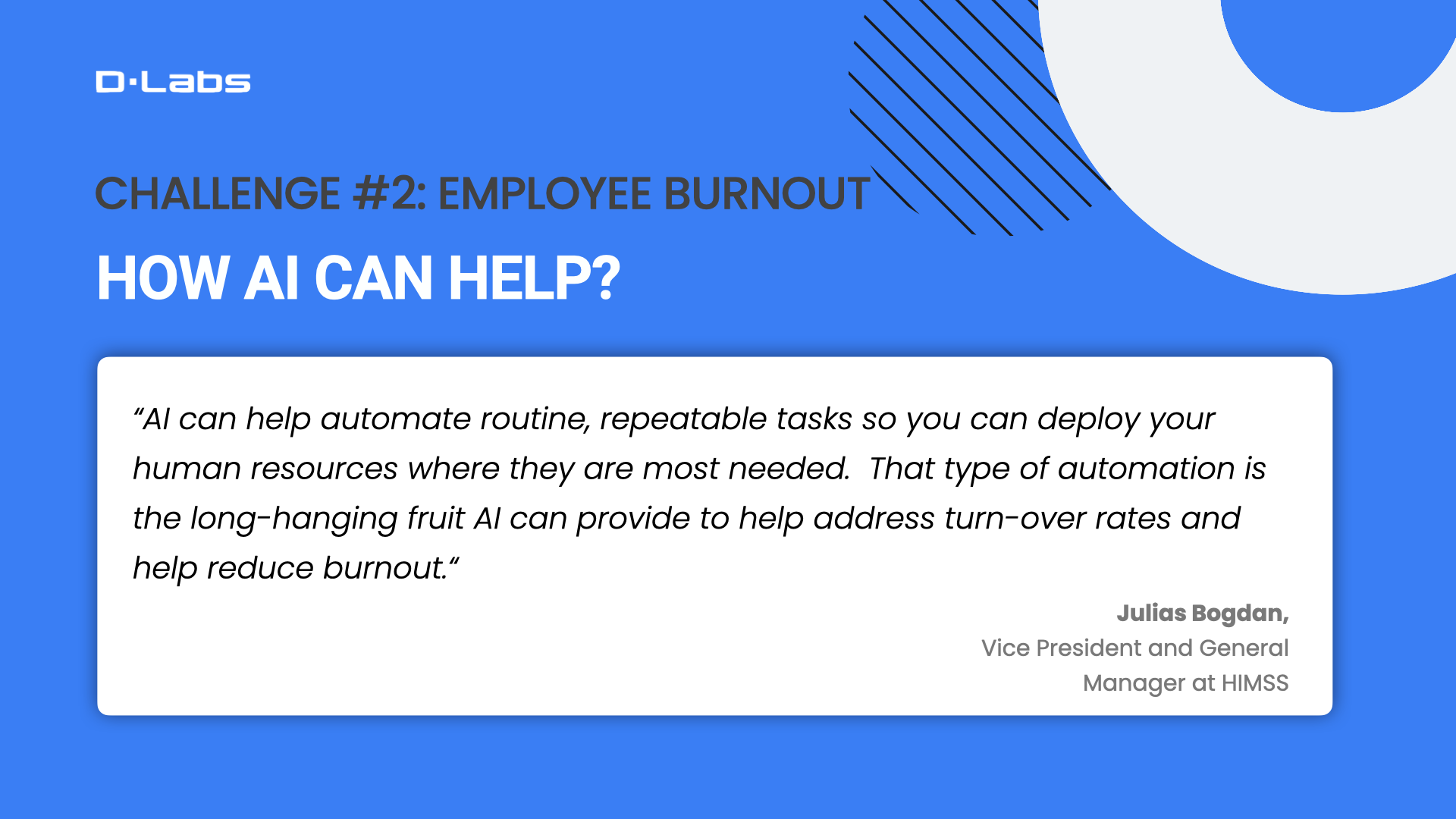
And the solution may be AI, of course. And according to Julias Bogdan from HIMSS: AI can help automate routine, repeatable tasks so you can deploy your human resources where they are most needed. That type of automation is the long-hanging fruit AI can provide to help address turnover rates and help reduce burnout.

Challenge 3: Huge volume of back-office tasks
Another challenge, which at the same time is very much related to the previous two, is too many repetitive back-office tasks that leave doctors and nurses without enough time to interact with patients.
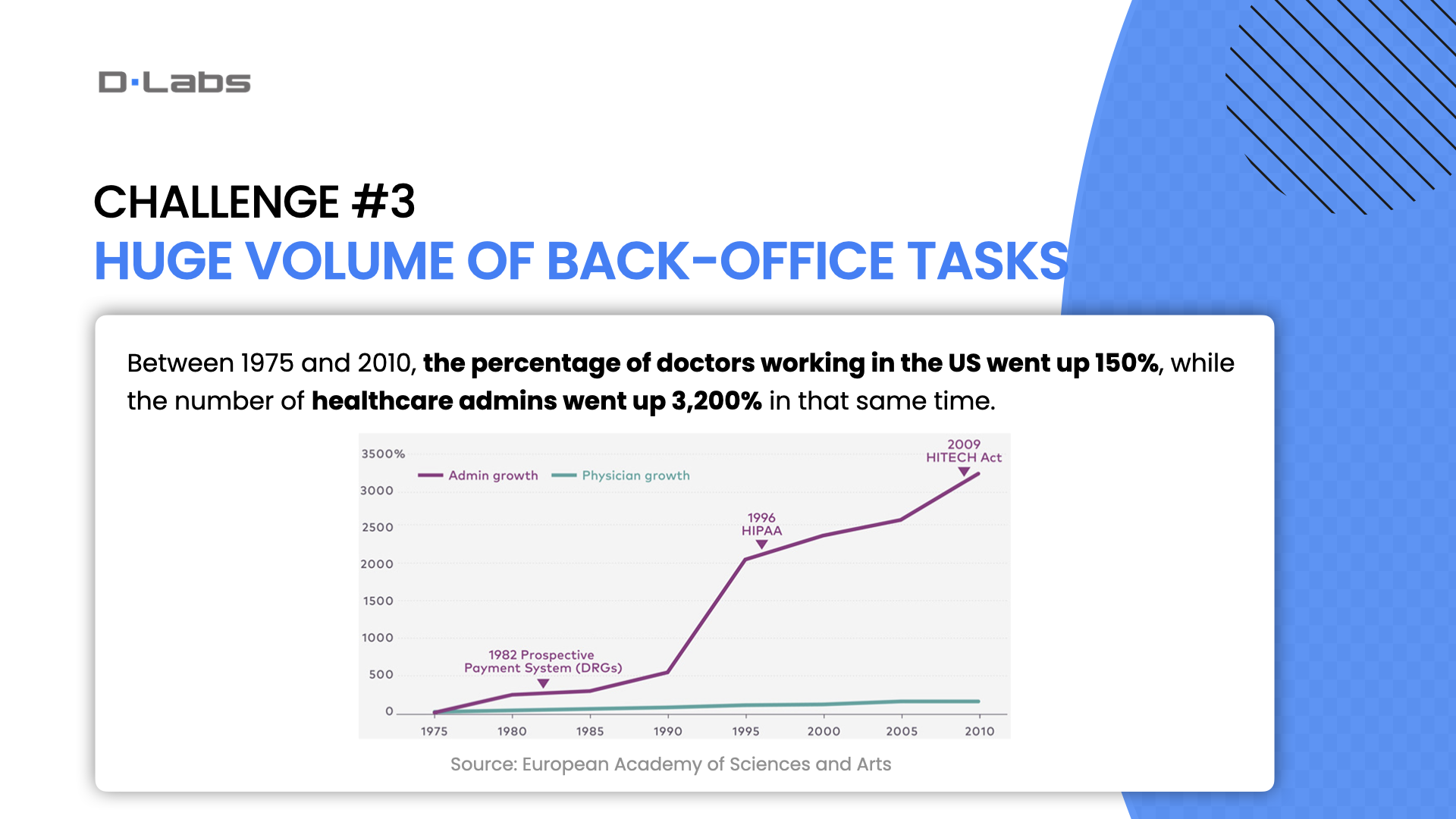
As you can see, between 1975 and 2010, the percentage of doctors working in the US went up 150%, while the number of healthcare admins went up 3,200% in that same time.
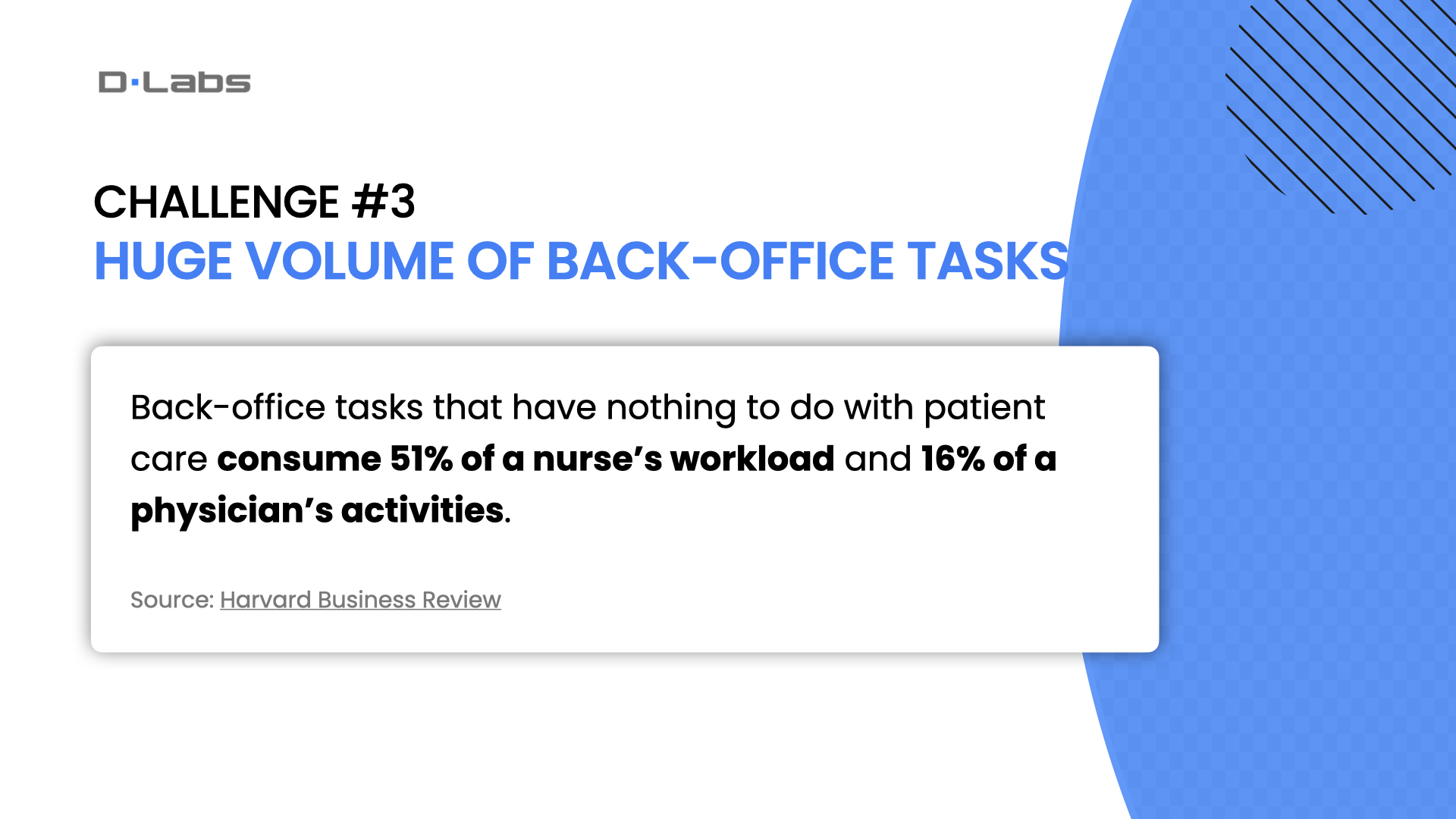
Back-office tasks that have nothing to do with patient care consume 51% of a nurse’s workload and 60% of a physician’s activities.

Challenge 4: A lack if patient-doctor time
This is related to another important problem, which is the fact that most primary care doctors don’t have enough time for their patients.
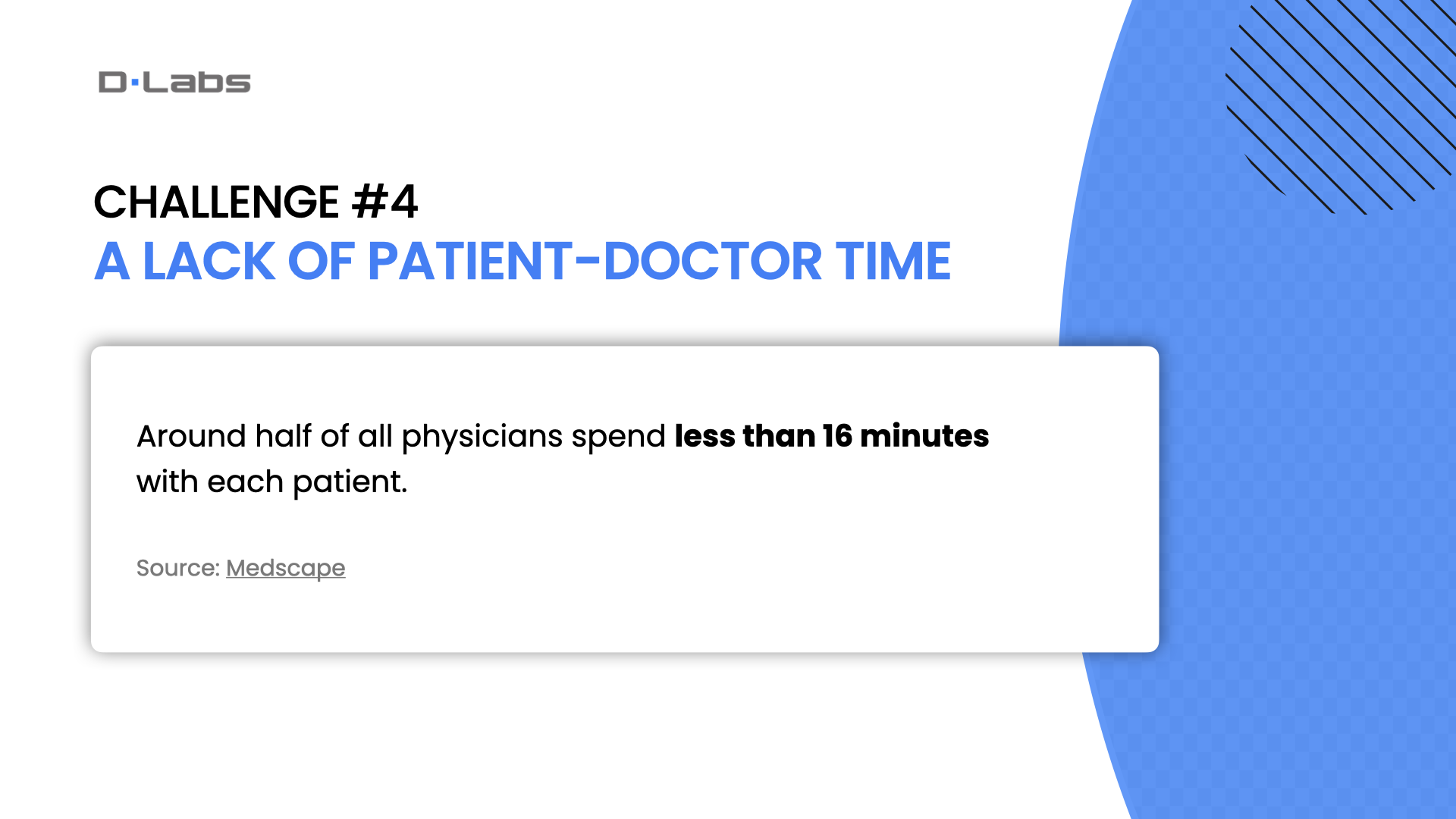
The need for rushed interactions between doctors and patients has been a problem for years, and it’s only getting worse. As I mentioned before, doctors are forced to deal with administrative issues for up to 20 hours a week, meaning their time with patients is shrinking. Naturally, patients do not feel listened to, and doctors feel stretched too thin.
Stats show that around half of all physicians spend less than 16 minutes with each patient. It’s not enough.
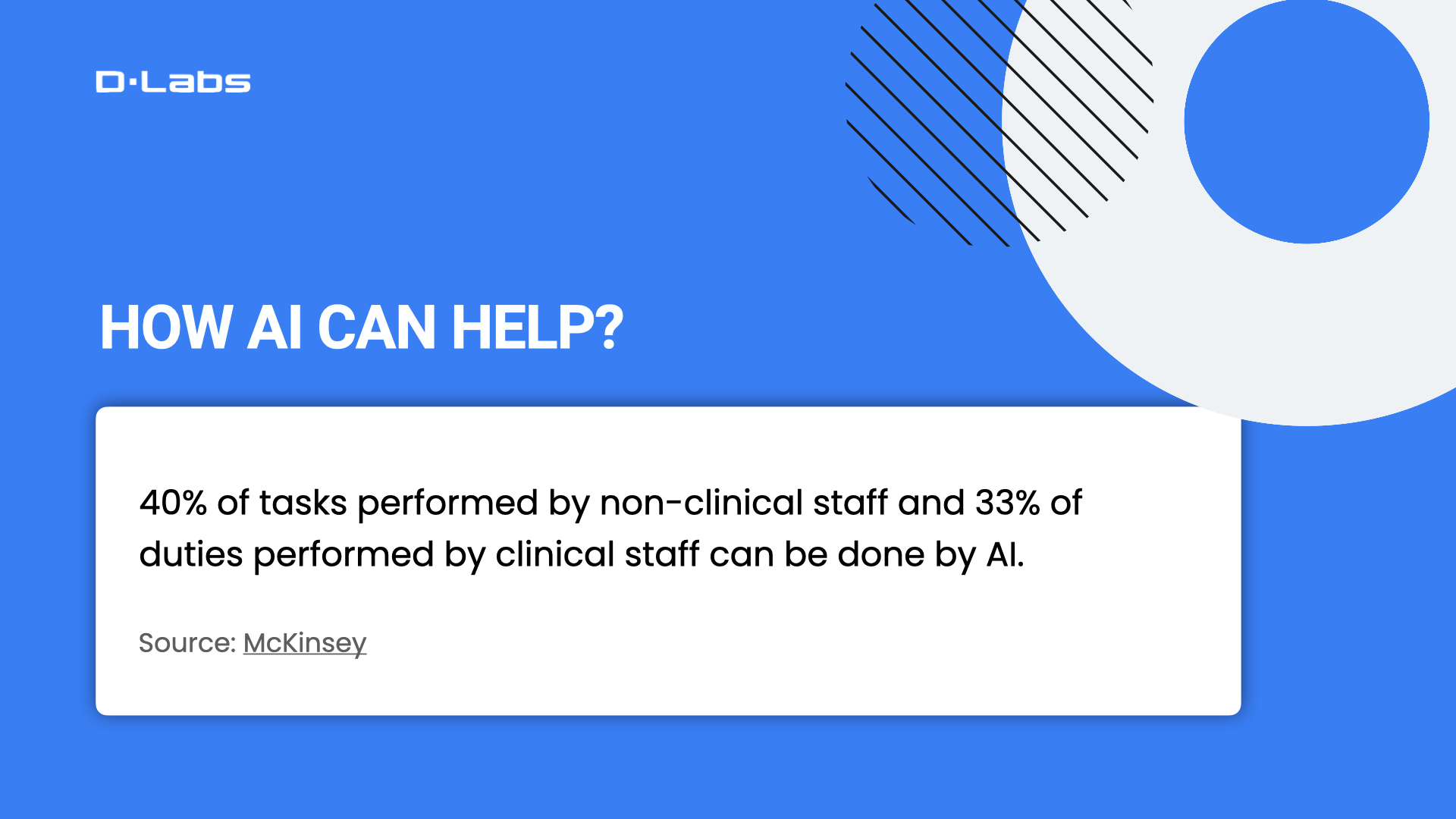
The lack of automation to support administrative workflows means that much of the work of experienced medical professionals is “wasted” by tasks that can be done by AI.
And according to the McKinsey report, 40% of tasks performed by non-clinical staff and 33% of duties performed by clinical staff can be done by AI.
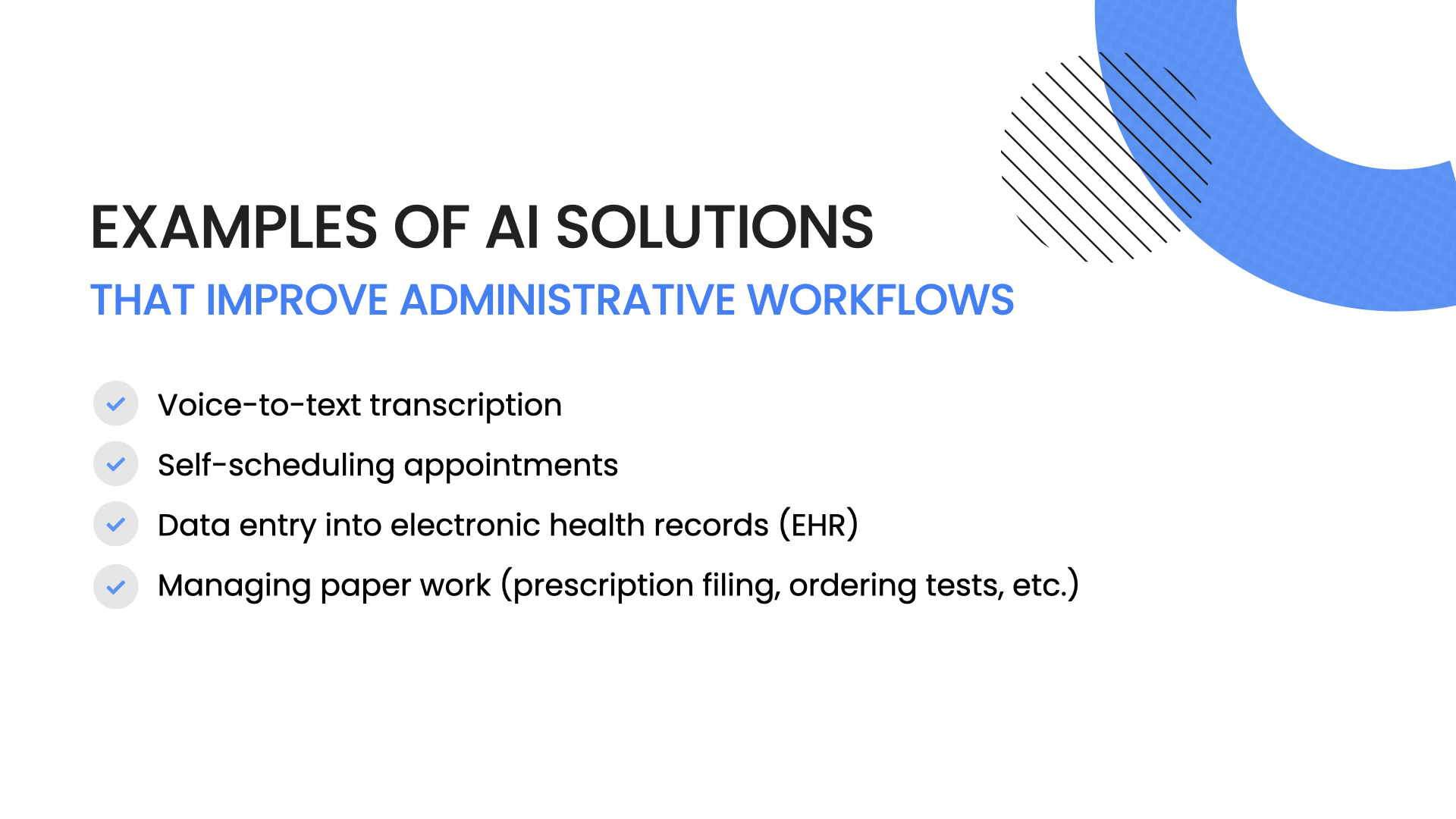
Examples of AI solutions that improve administrative workflow
AI-based technologies like voice-to-text transcription, self-scheduling appointments, inputting data into the electronic health record, managing paperwork like filling prescriptions, ordering tests, and of them can improve administrative workflows and eliminate many time-consuming activities. They allow personnel to save time, focus on more important responsibilities, and avoid worker burnout.
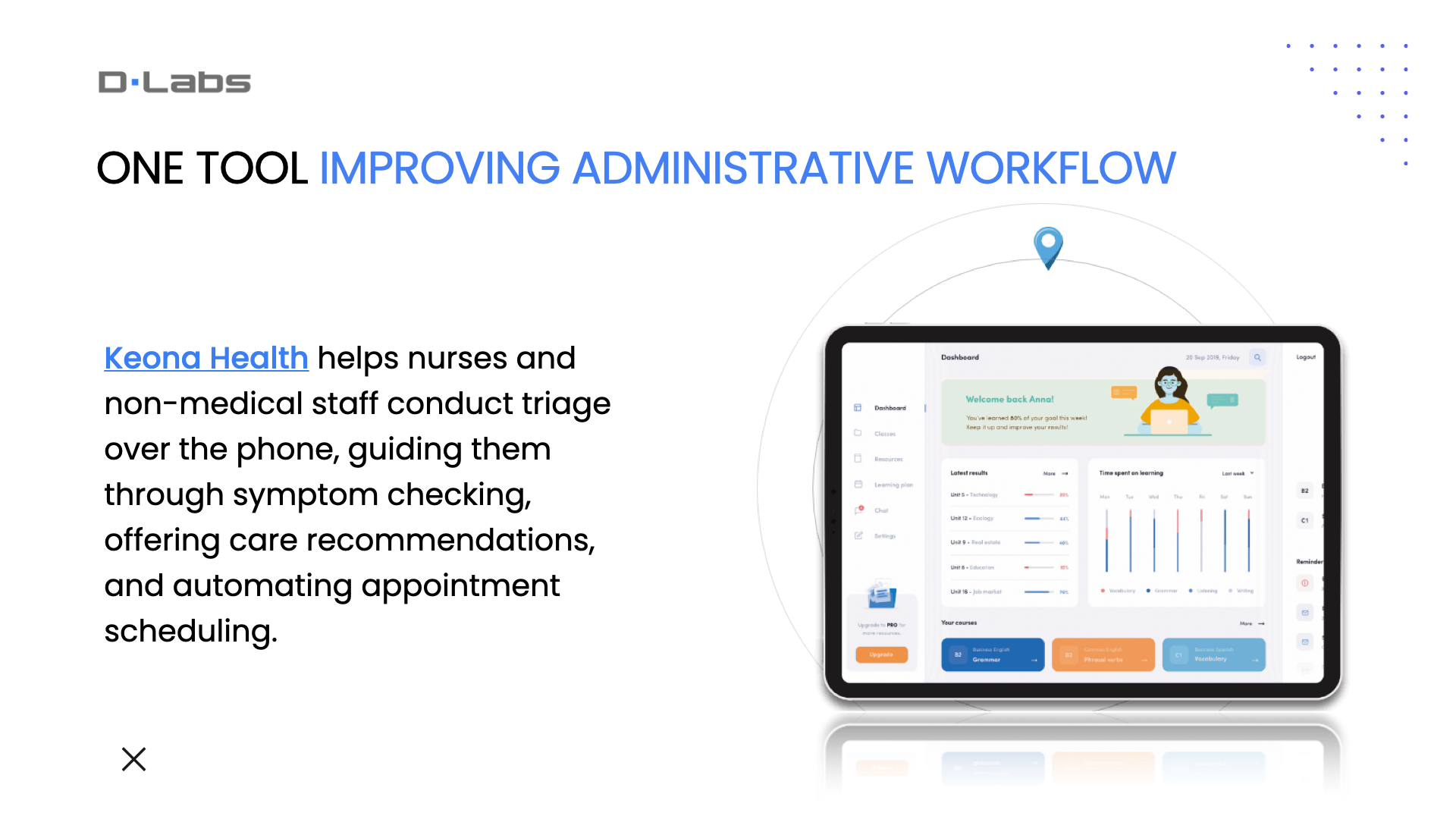
One tool improving administrative workflow
And there are a number of-the-shelf AI-based solutions that can help overcome the problem and outline the above. One of them is Keona Health which focuses on helping nurses and non-medical staff conduct triage over the phone, guiding them through symptom checking, offering care recommendations, and automating appointment scheduling.

Challenge 5: Low patient engagement
Ok, another problem – low patient engagement.
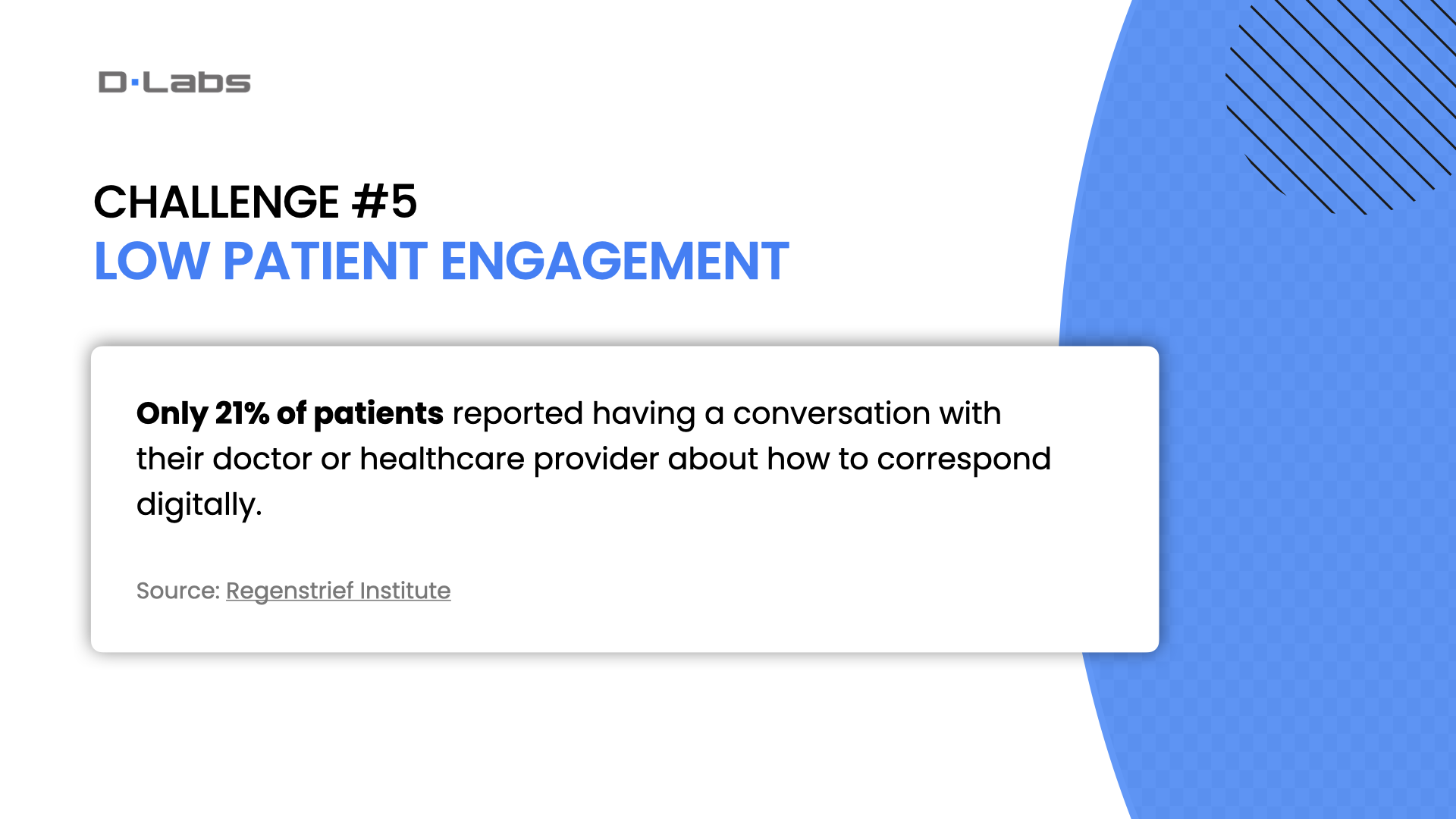
In the health industry, low patient engagement has been a challenge for years. And according to statistics, only 1 in 5 patients say their providers told them about the digital communication methods available to them.
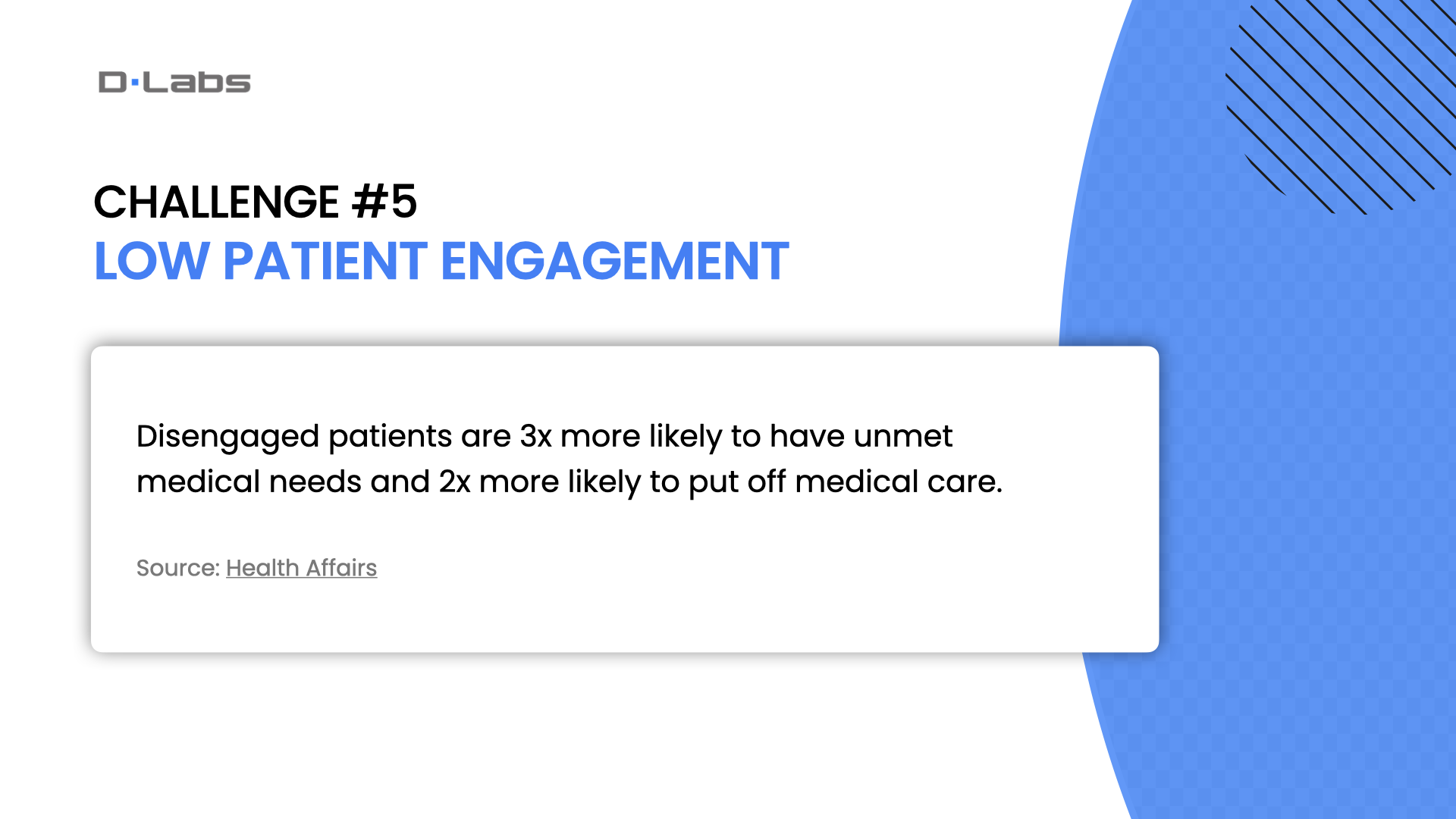
It is a big complex problem because patients who feel disengaged from their care plans and providers run an increased risk of poor health outcomes than their engaged counterparts. Stats show that disengaged patients are 3x more likely to have unmet medical needs and 2x more likely to put off medical care.
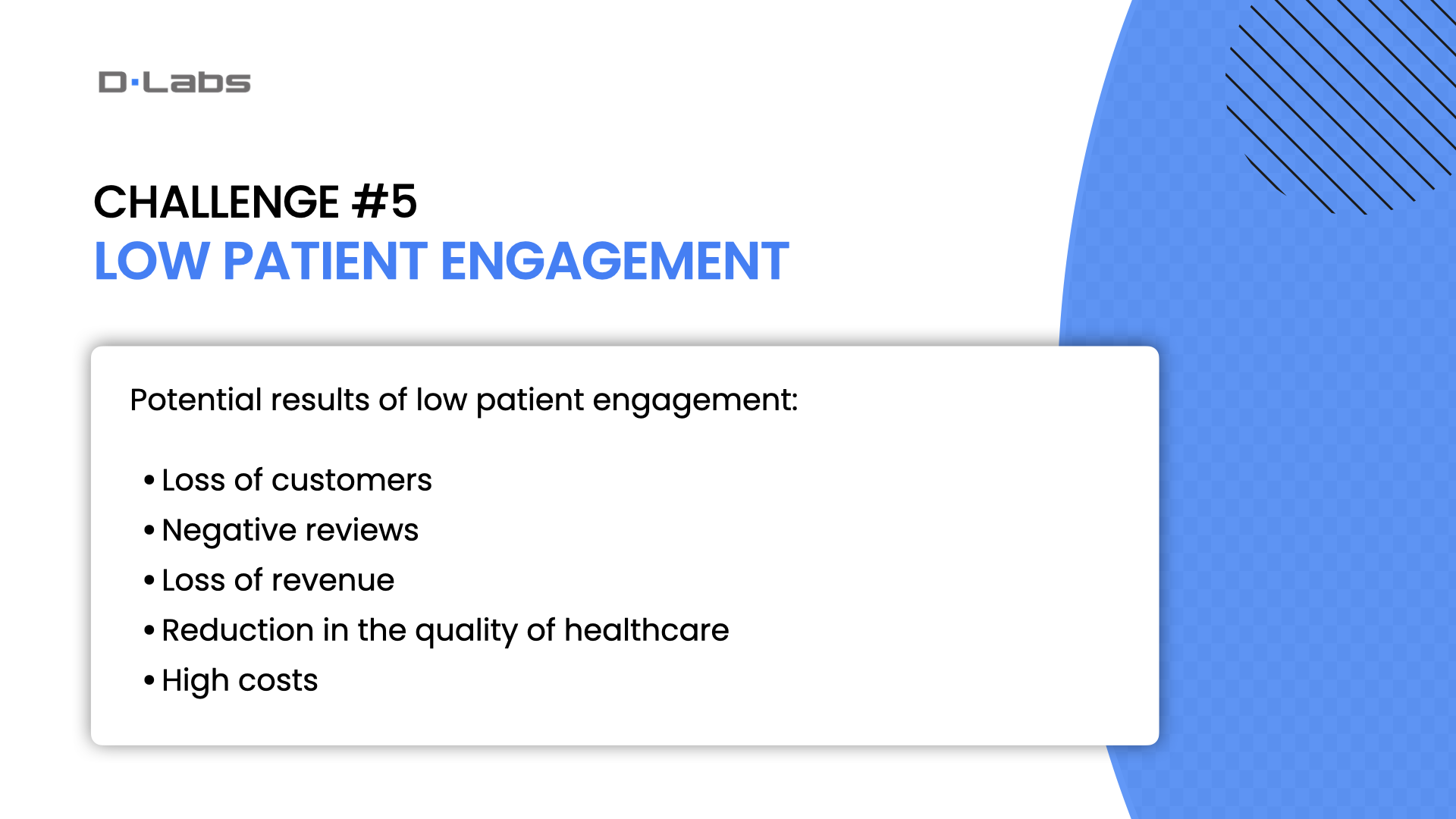
Moreover, from the business perspective – patients who remain disengaged are likely to find other providers for their healthcare needs—not to mention they might leave you negative reviews, which can damage your practice’s reputation and cause you to lose revenue in the process. However, low patient engagement has the potential to affect much more than just your practice. It can also drastically decrease the quality of healthcare throughout the country. Plus, poor patient engagement comes at a price—and it can be costly in more ways than one.

Solution
A big part of driving increased patient engagement is adapting to the ever-evolving needs of the modern healthcare consumer. According to a Deloitte survey, today’s healthcare consumers want access to digital tools that are convenient, flexible, and user-friendly. To meet this growing demand, healthcare practices need to adapt and engage with patients via the same communication channels they’re already familiar with. Doing so can go a long way in engaging, satisfying, and ultimately retaining your patients. With easy access to tools for scheduling appointments, messaging providers, accessing test results, requesting prescription refills, and more, patients are much more likely to take ownership of their healthcare. The tools that have the greatest impact on patient engagement can include patient portals, automated appointment reminders, check-in technologies, telehealth visits, digital payment options, and, last but not least, data analytics.
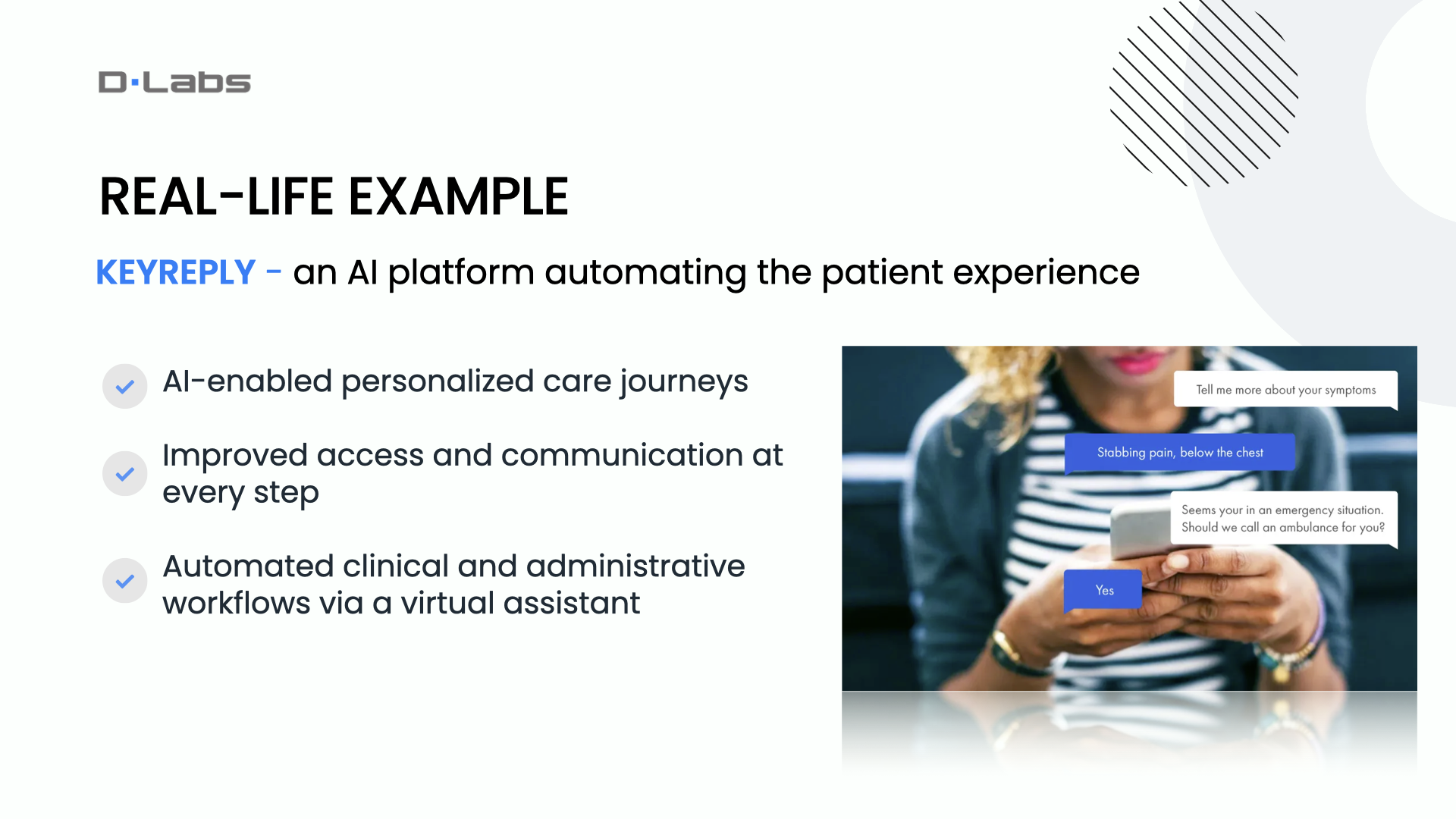
Real-life example
A real-life example of an AI solution is KeyReply’s – healthcare platform which uses AI to be a patient’s personal guide in their healthcare journey. It leverages an (AI) driven personalized care journey to transform fragmented, manual processes into connected, personalized digital healthcare experiences, improve access and communication at every step of the healthcare journey, and automate any clinical or administrative healthcare workflow with a virtual assistant platform that unifies AI, human communication, and no-code reconfigurability.
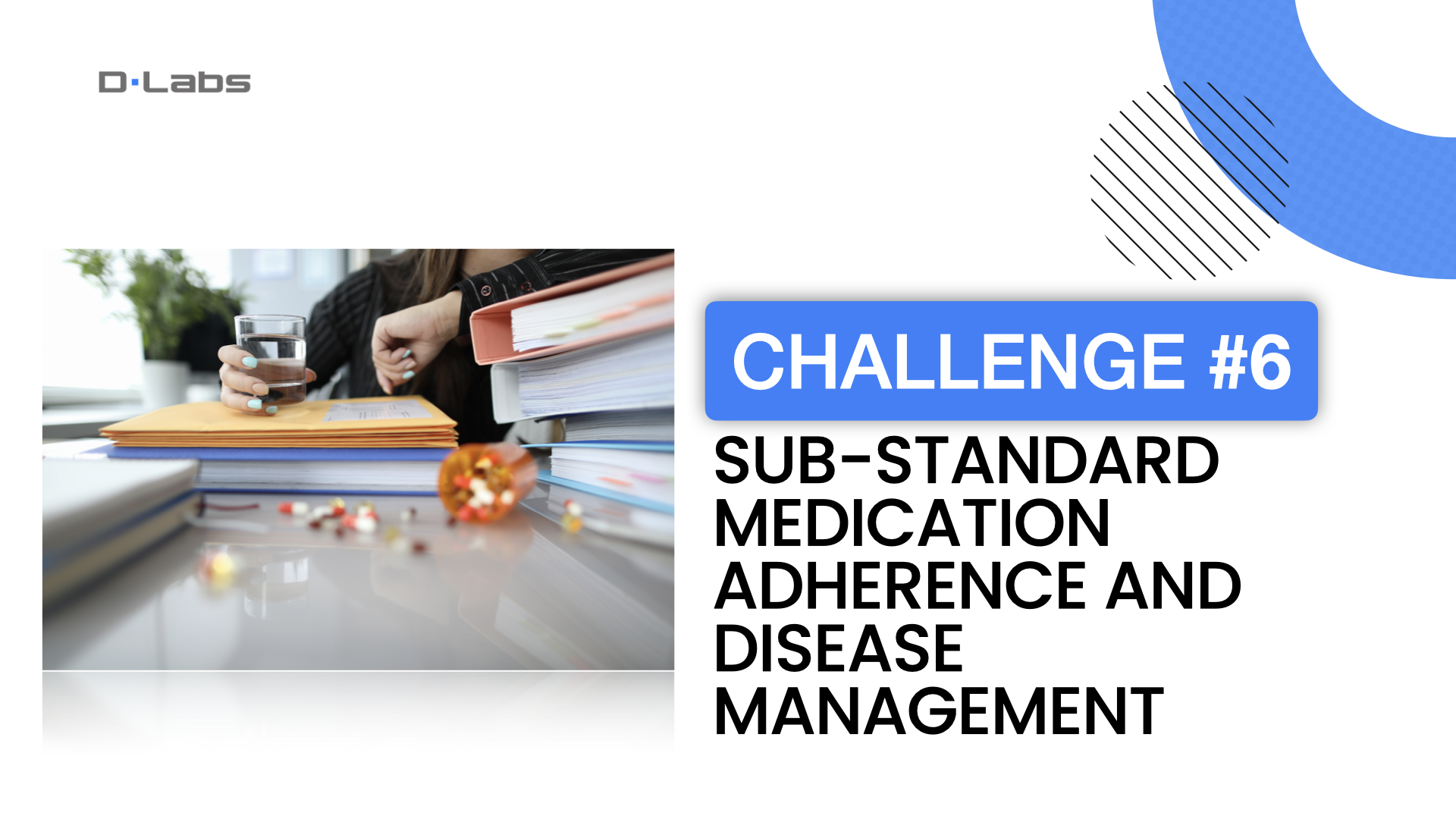
Challenge 6: Sub-standard medication adherence and disease management
The next challenge – is sub-standard medication adherence and disease management.
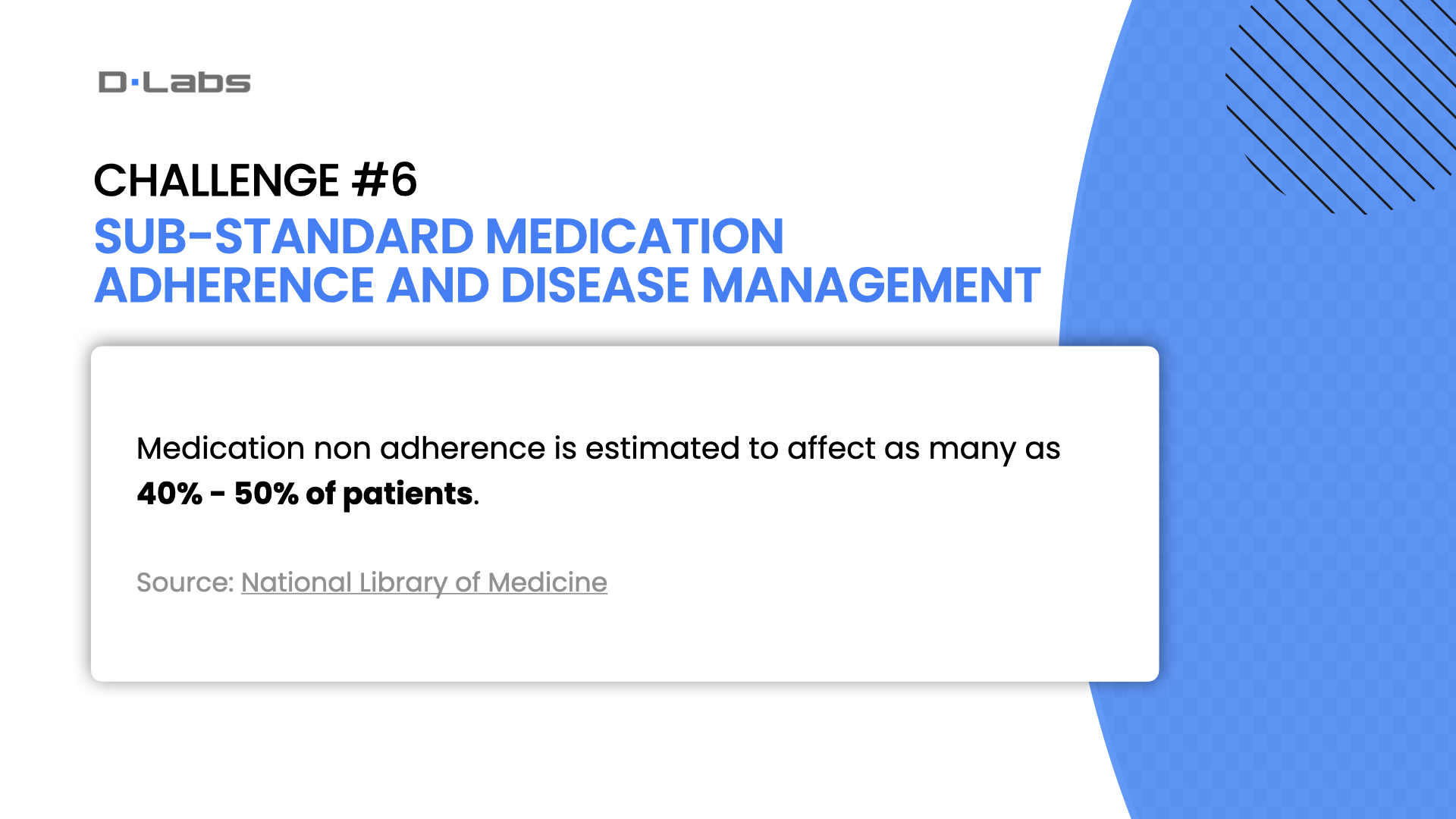
Medication nonadherence is estimated to affect as many as 40-50% of patients who are prescribed medications for the management of chronic conditions like diabetes, heart disease, and hypertension.
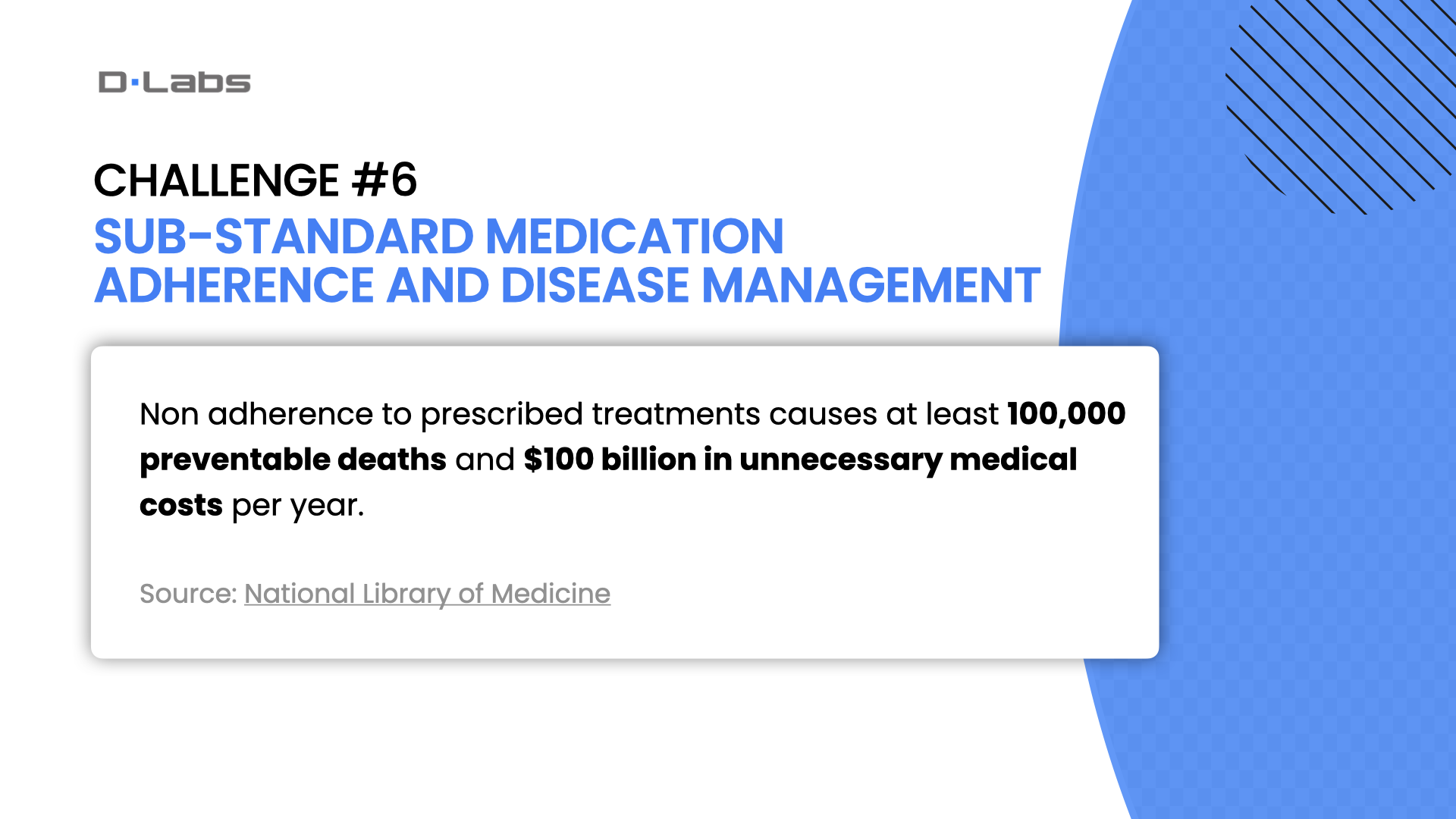
And not surprisingly, this comes at a high cost. Nonadherence to prescribed treatments causes at least 100,000 preventable deaths and $100 billion in unnecessary medical costs per year.
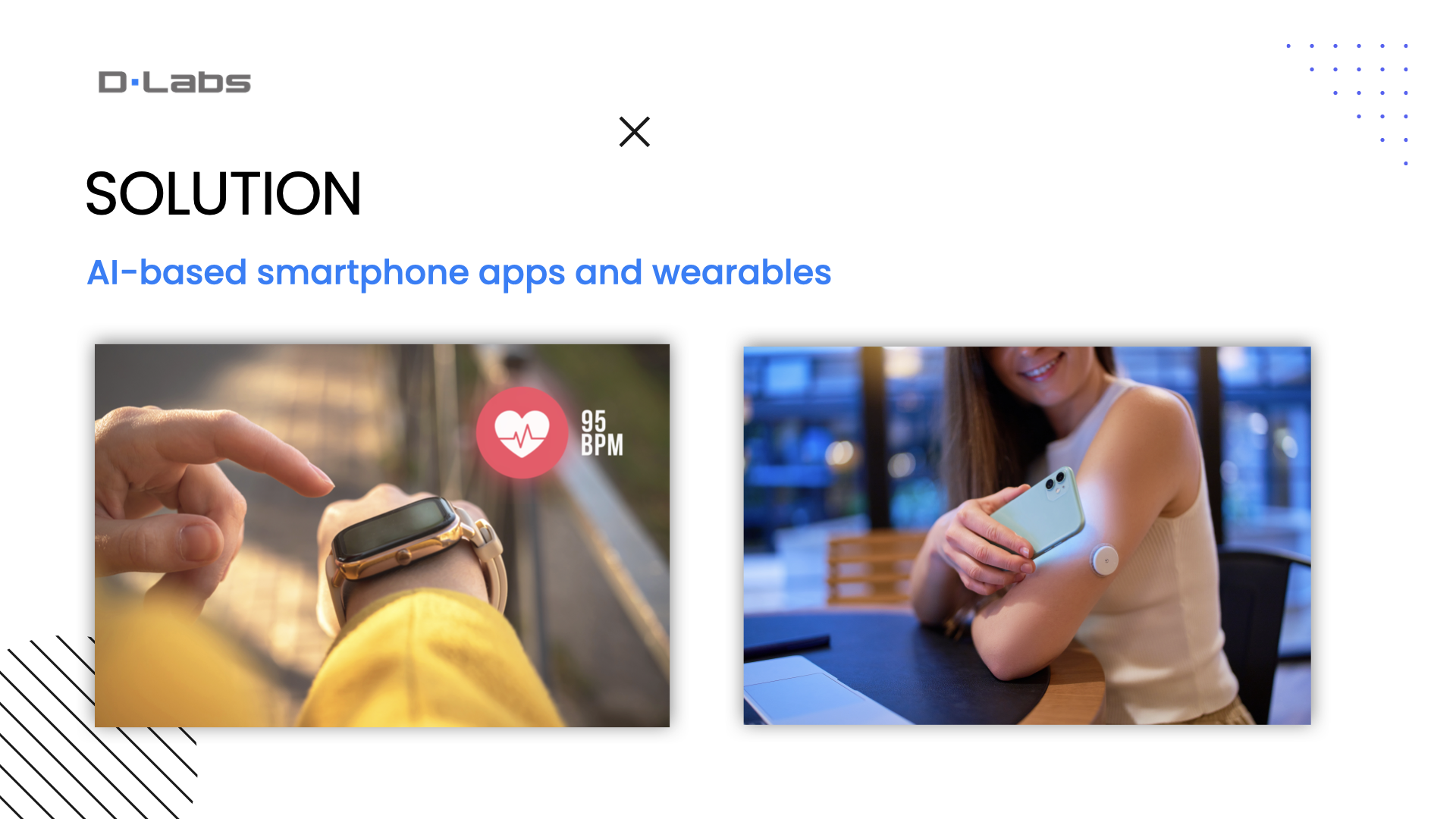
Solution
Here comes artificial intelligence and machine learning into the picture because, using AI, you can develop user-aware apps in the form of mobile or wearable apps that learn about their users over time. They do not leave any information about users untapped. For instance, they may want to know if you are waking up, driving to work, lifting weights at the gym, taking a nap at home, and so on. Knowing about your habits, activities, and context would enable the app to respond to you at key moments of the day. For instance, once you complete 7 hours of sleep, it would send a notification and motivate you to continue this habit. It would also pop accurate reminders based on its knowledge of your daily routine and make sure you don’t miss your medication despite your busy schedule or forgetful nature. And this could be applied to diabetes as well.
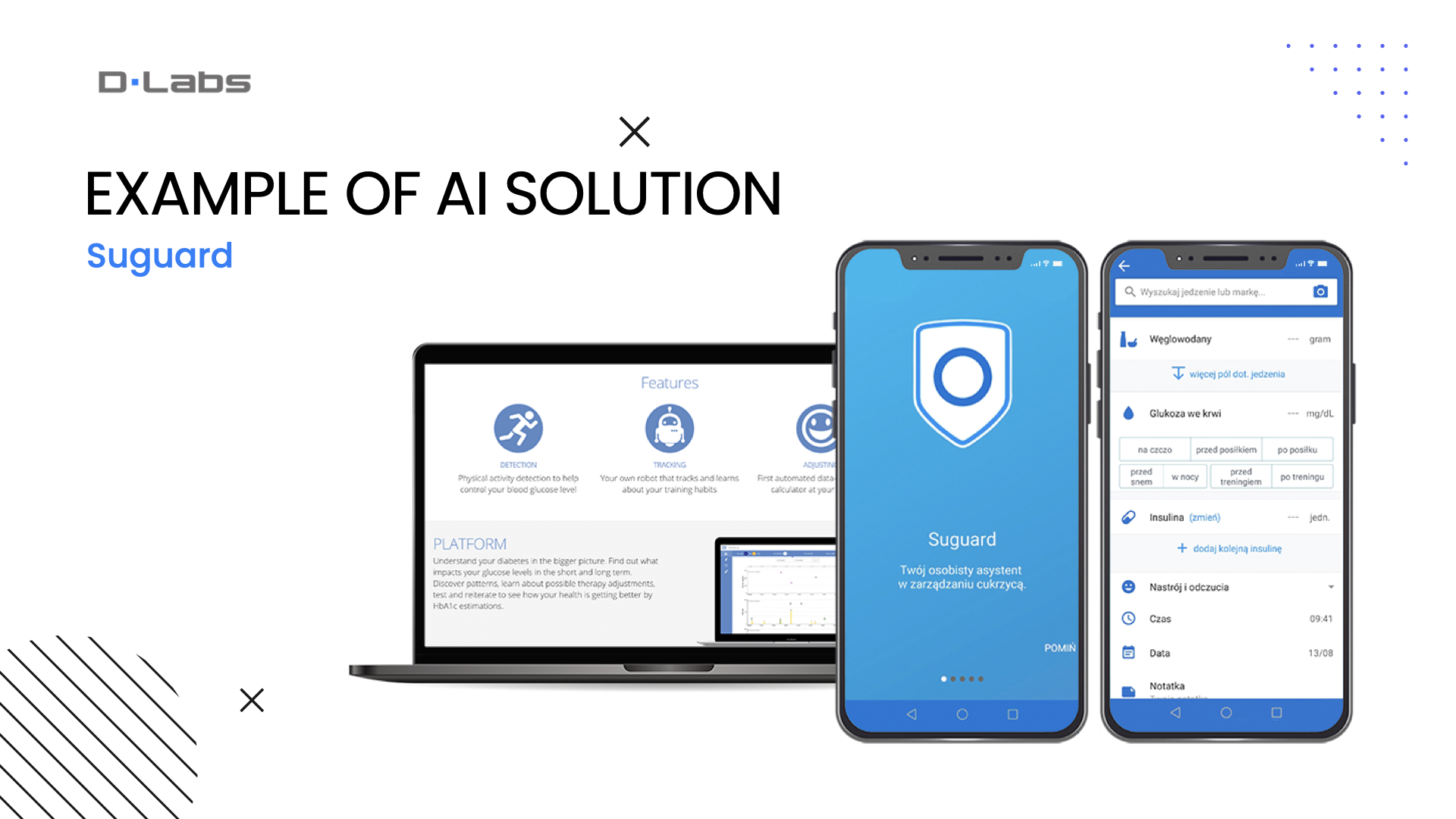
Example of AI solution: Suguard
As a person who struggles with type 1 diabetes, at this point, I would like to give an example of my case. The care regimen of diabetics varies from person to person and is filled with complexity. They have to check their blood sugar level regularly, take pills and/or inject insulin and follow a stringent diet and exercise plan. An AI-powered or user-aware app would know the habits, sleeping, and historical health patterns of the user and engage them at optimal moments. Suppose the patient is heading to the gym. The app would sense it and prompt the user to check their blood sugar. It would also ask the user to eat an apple before starting exercise so that they don’t suffer from a hypoglycemic reaction while doing exercise. The app is aware of the user’s average work hours, sleeping patterns, and exercise habits, which would coordinate the care regimen with near perfection. It would tell the user to take pills or insulin at appropriate times without fail.
What more? The app can also create a report of daily activities and share tailored insights with the patient and their caregiver. And this is how Suguard is supposed to work: an AI-based smartphone app that makes everyday life easier for people with the condition. Suguard is an internal project we’ve been developing since 2014, which is when we founded DiabetesLab: our second company focused on creating advanced software that helps people manage an illness using AI. Suguard is both my idea and my dream. As someone struggling with the condition, I see a great need for such a personalized application. And my experience has driven me forward as I look for a solution to help me stay active and enjoy sports. Because people with diabetes typically require intensive treatment and exceptional care, especially during sporting activities. But that doesn’t make them impossible. And I believe I’m a shining example that you can still play sports to a good level with the condition. The reason I’m talking about it is that my ambition to play sports drove me to create a solution that would help me. And I hope that soon, it will be something that can also help a broader audience.
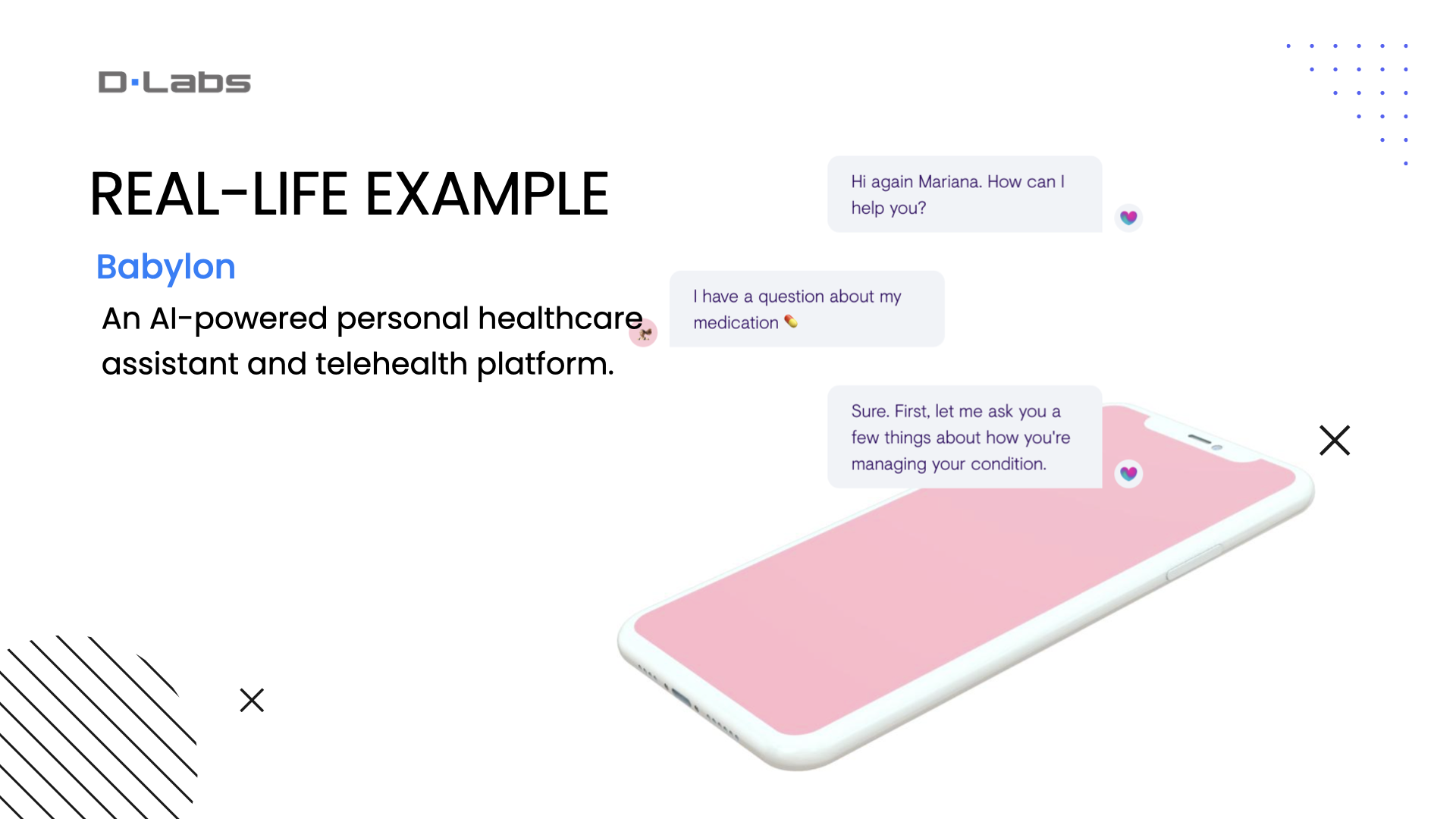
Real-life example: Babylon
Another example is Babylon — an AI-powered personal healthcare assistant and telehealth platform. It helps you stay on top of your health by providing a secure archive of your symptoms, conditions, and health assessments, all in one place. It also uses advanced AI and a chatbot to help you track all of your symptoms and their severity and duration.
You can plug all that information into the Healthcheck feature to get an overview of your current and future health risks based on your lifestyle practices. Then, you’ll receive suggestions to make changes based on your assessments and health profile. That way, if anything changes or gets worse, you’ll be more equipped to talk to a doctor about it.

Challenge 7: High drop rates
Challenge number 7 – high drop rates.
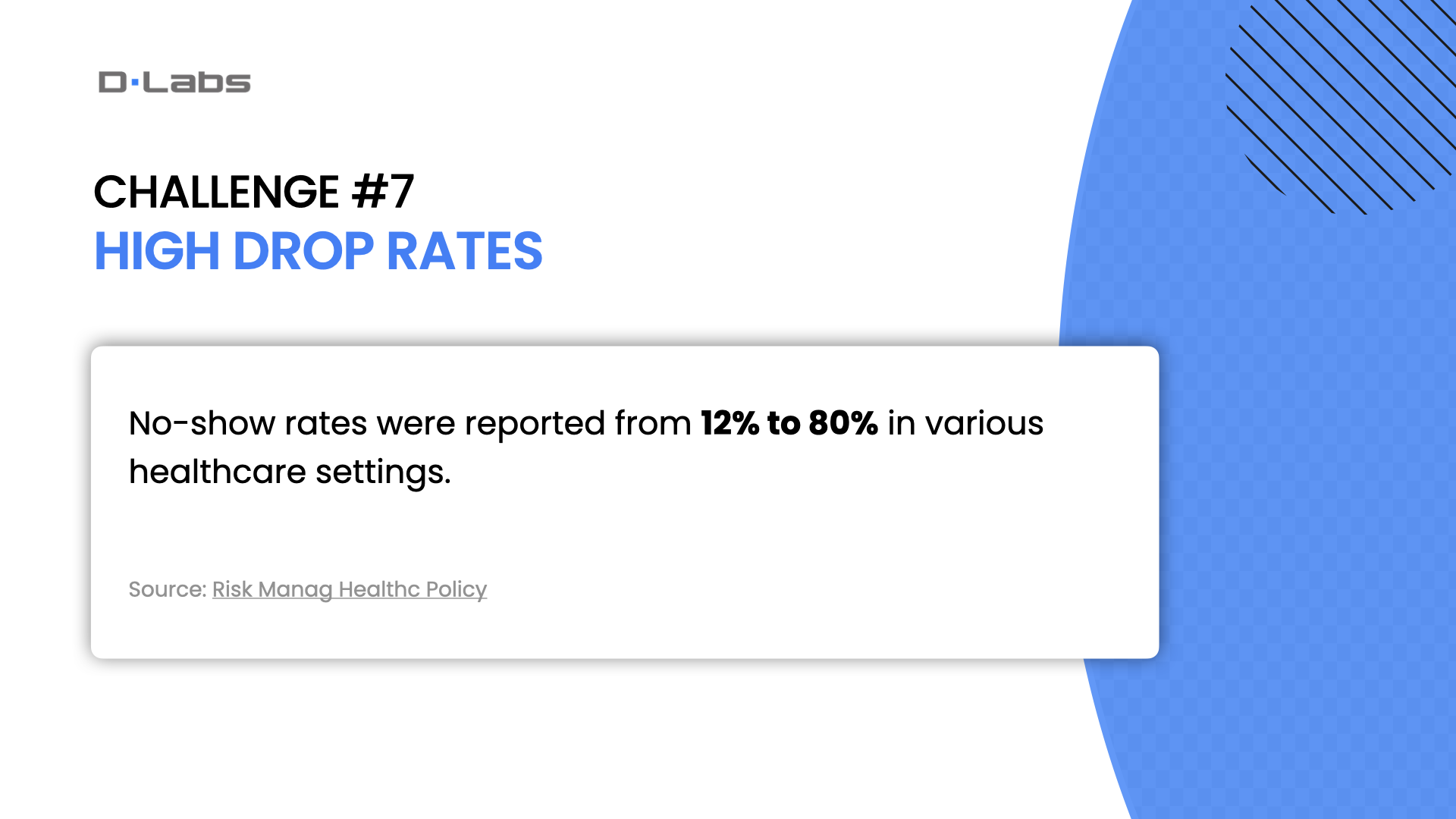
Patient no-shows are long-standing issues affecting resource utilization and posing risks to the quality of healthcare services. They also lead to a loss of anticipated revenue, particularly in services where resources are expensive and in great demand. Stats show that the no-show rates were reported from 12% to 80% in various healthcare settings.
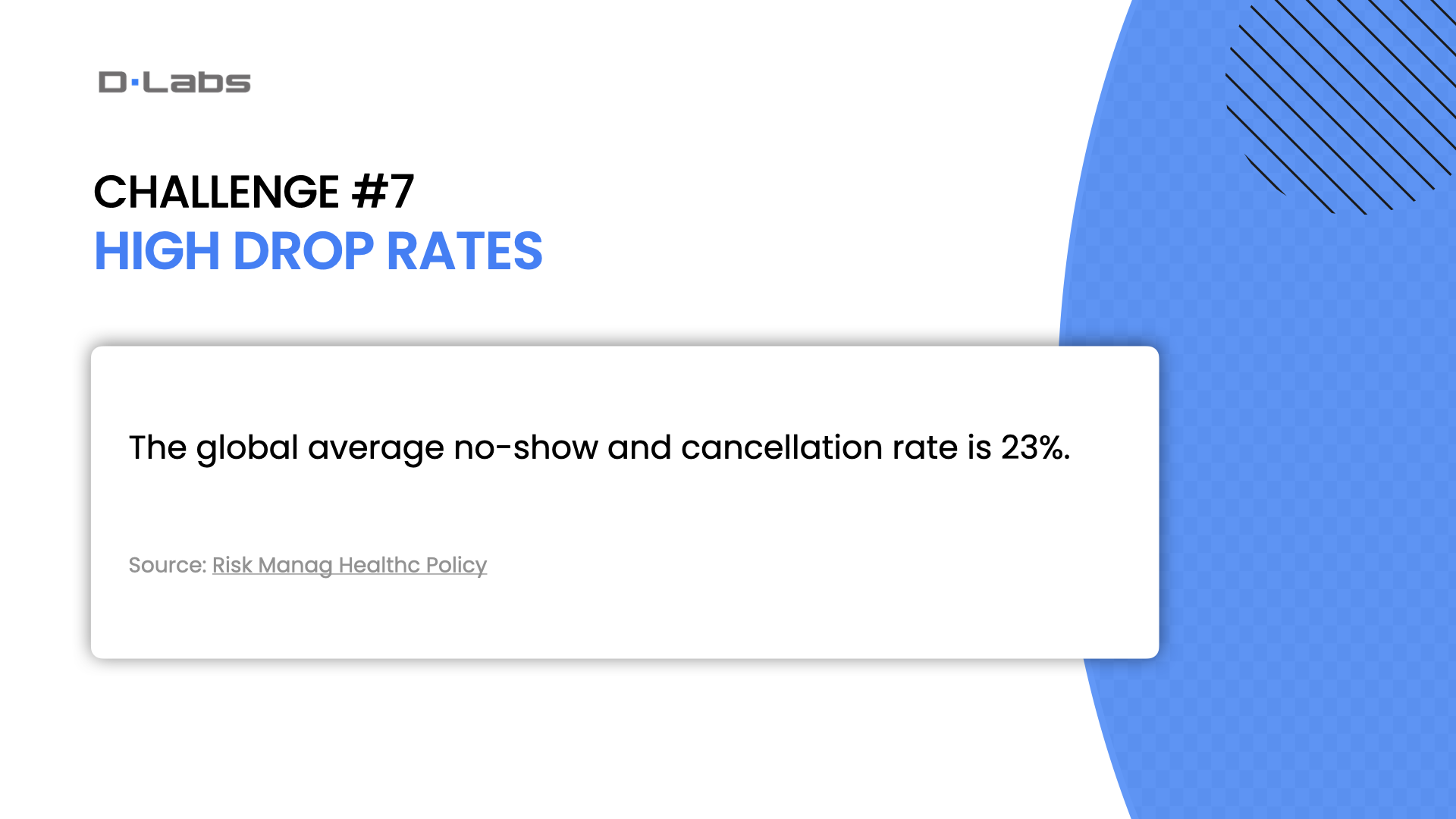
The combined average no-show and cancellation rate in the U.S. and globally is 23%. No-shows occur when a patient fails to attend a scheduled appointment with no prior notification to the healthcare provider. They are missed healthcare utilized time slots and resources that can negatively affect the utilization of space and human resources. Further, they can affect the patient’s health condition due to the delay in diagnosis or treatment. Prospective patients can also be impacted and less satisfied due to their inability to schedule timely appointments.

Furthermore, generated revenue also decreases due to the reduction in the system’s operational efficiency. For instance, in a recent study, it was estimated that 67,000 no-shows can cost the healthcare system approximately $7 million. Such costs may be even much higher in some settings, such as radiology departments, where resources, such as X-Ray and MRI machines, are very expensive, and underutilization may cause huge financial constraints to healthcare organizations.
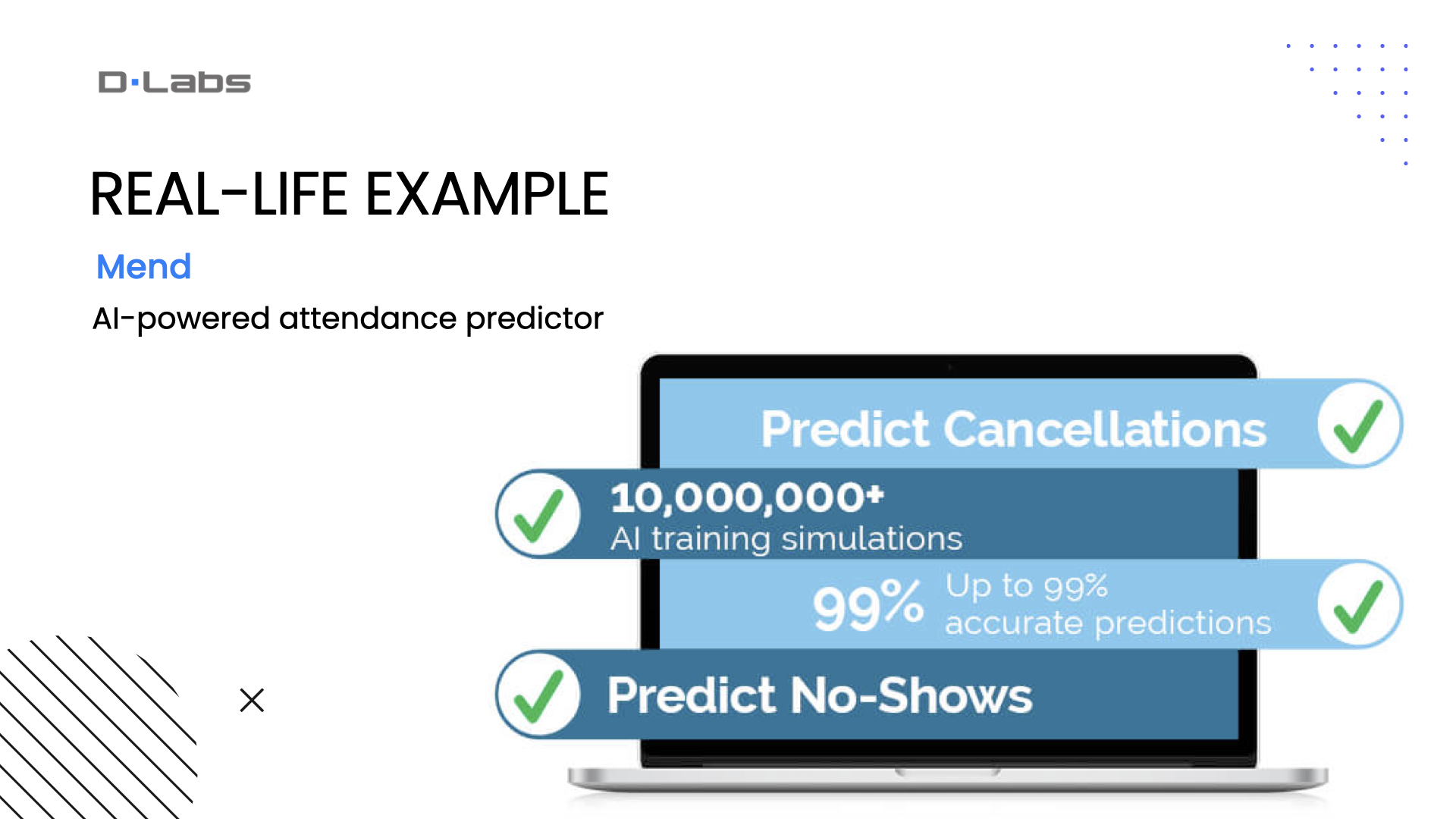
Real-life example: Mend
This problem can also be solved by AI. Apps like Mend can predict which patients are at high risk for a no-show or cancellation. And as you can see, this type of solution achieves really good results.
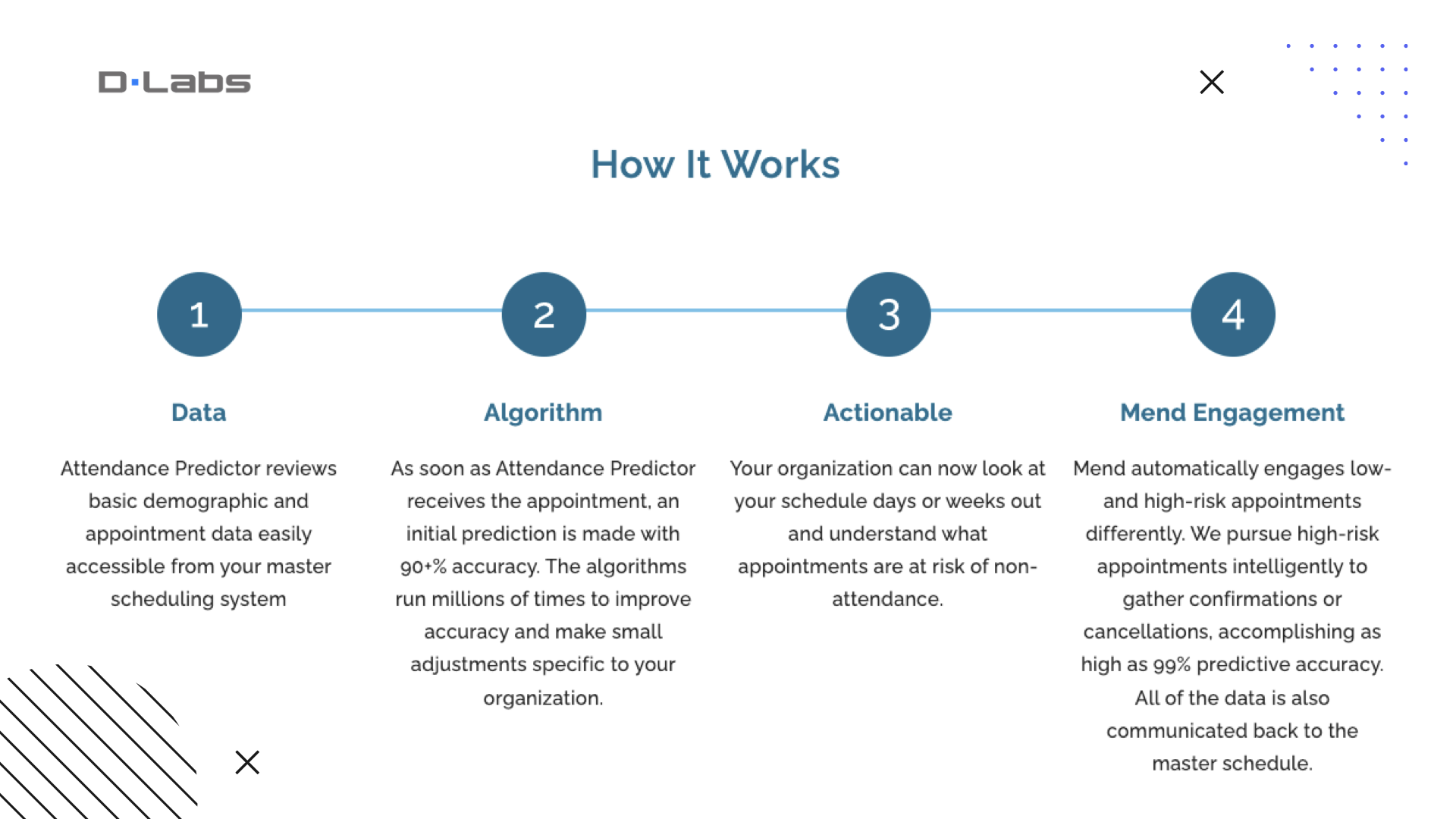
How it works
How does it work? First, with just a click, a link creates a connection to share a video, files, photo, messages, data, and scheduled appointments or collect forms. Then, the AI algorithm first predicts when a patient may not show. Then, the system automatically sends an appointment reminder sequence that encourages them to confirm or reschedule. When you enable Mend telehealth in your practice, the no-show rate is in the single digits. According to its creators, the tool predicts no-shows and cancellations before they happen with up to 99% accuracy.

Challenge 8: Tight budgets
Challenge number 8 – is related to the thigh budgets.

Roughly 4 out of 5 healthcare executives said costs tied to poor budgeting and planning are passed onto their patients, according to a new report released by Syntellis Performance Solutions and Wakefield Research. The study included responses from 200 hospital and health system executives.
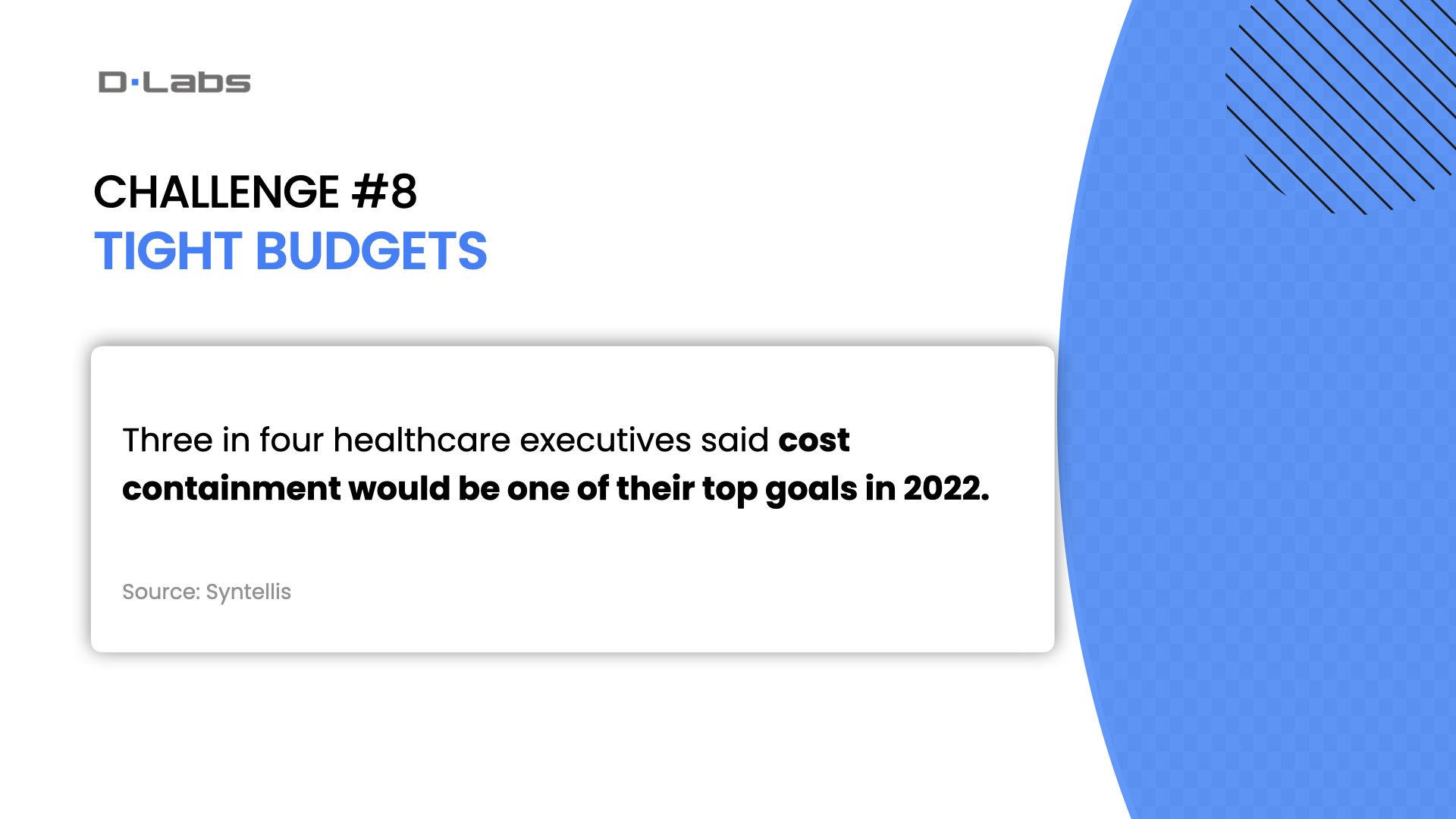
Moreover, three out of four healthcare executives said cost containment would be one of their most important goals in 2022.
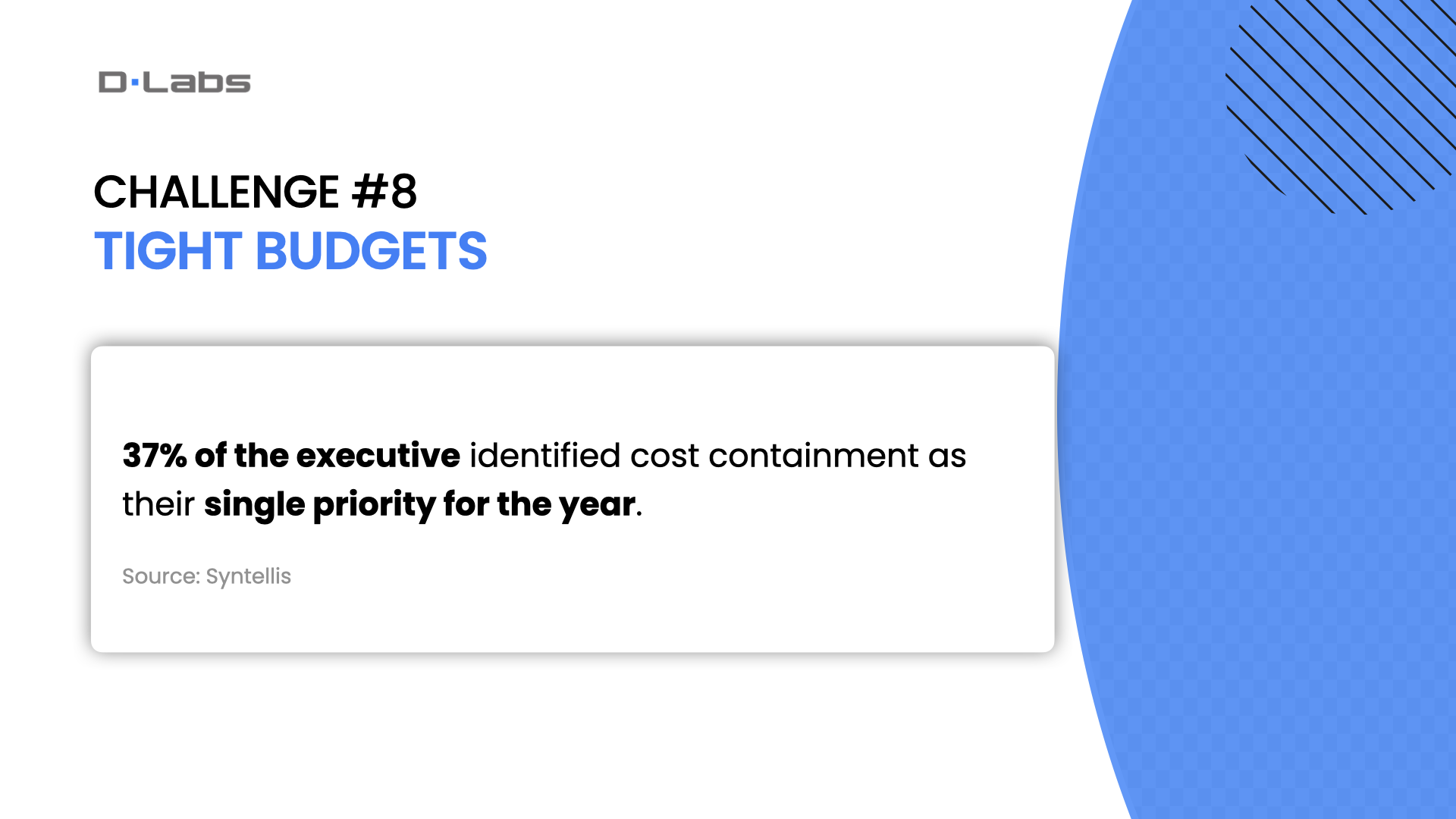
In fact, 37% of the executive surveyed identified cost containment as their single top priority of the year. Additionally, more than half of those surveyed said they were concerned about the cost of inflation (52%).
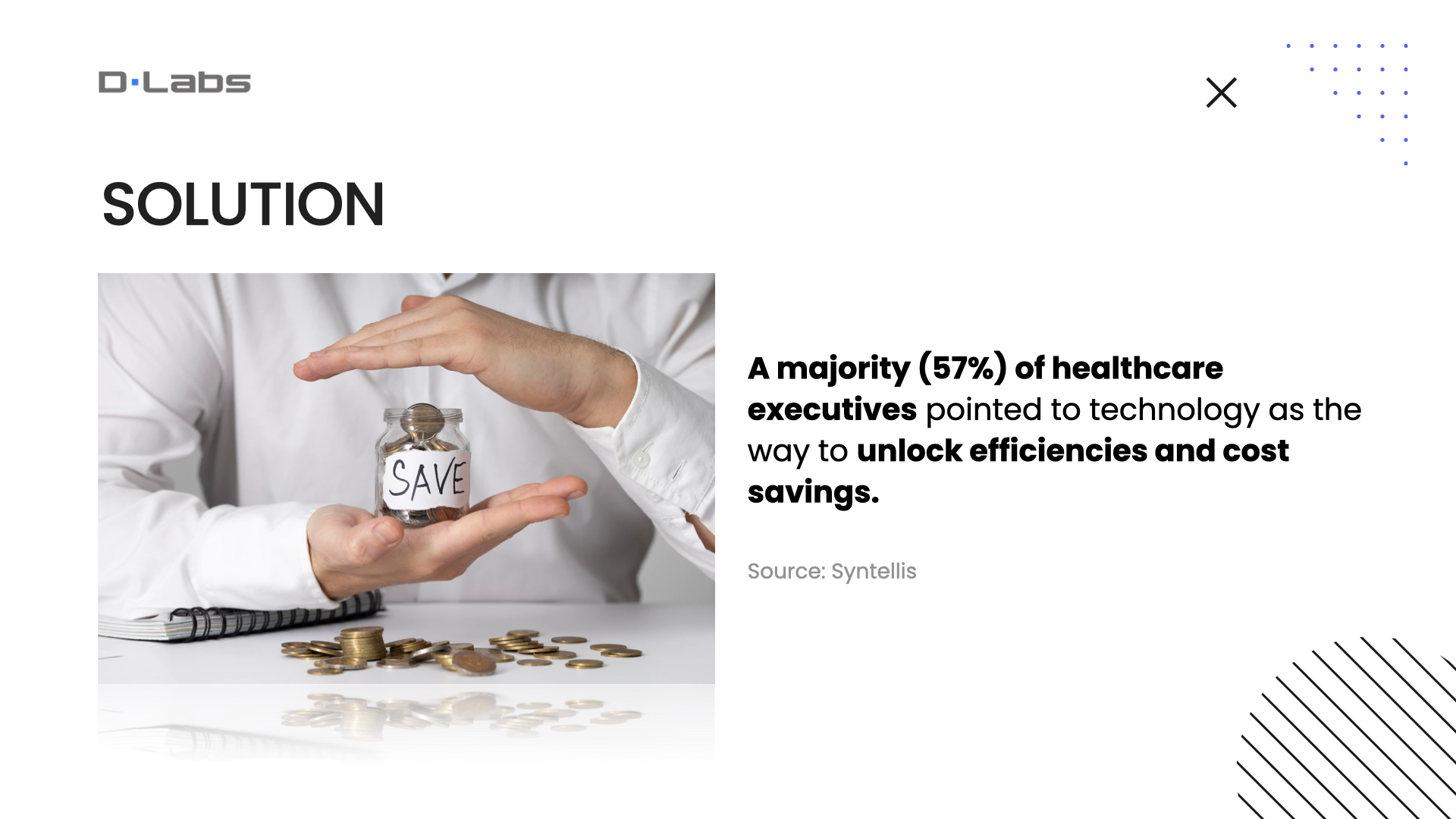
Solution
According to the same source, the executives offered different opinions on the best methods to trim expenses. A majority (57%) pointed to technology solutions as a way to find efficiencies, including using more automation to manage some administrative tasks. Others pointed to other ways to find growth, including workforce productivity (21%), improving processes, and reducing overhead.

How significant can the use of AI be in medical care? Well, Accenture estimates that AI applications in healthcare could save up to $150 billion annually by 2026. In cash-strapped community hospitals, those kinds of savings can help keep the doors open. In addition, AI has the potential to replace many of the menial tasks currently performed by radiologists, as well as integrate data mining into the electronic medical records process.
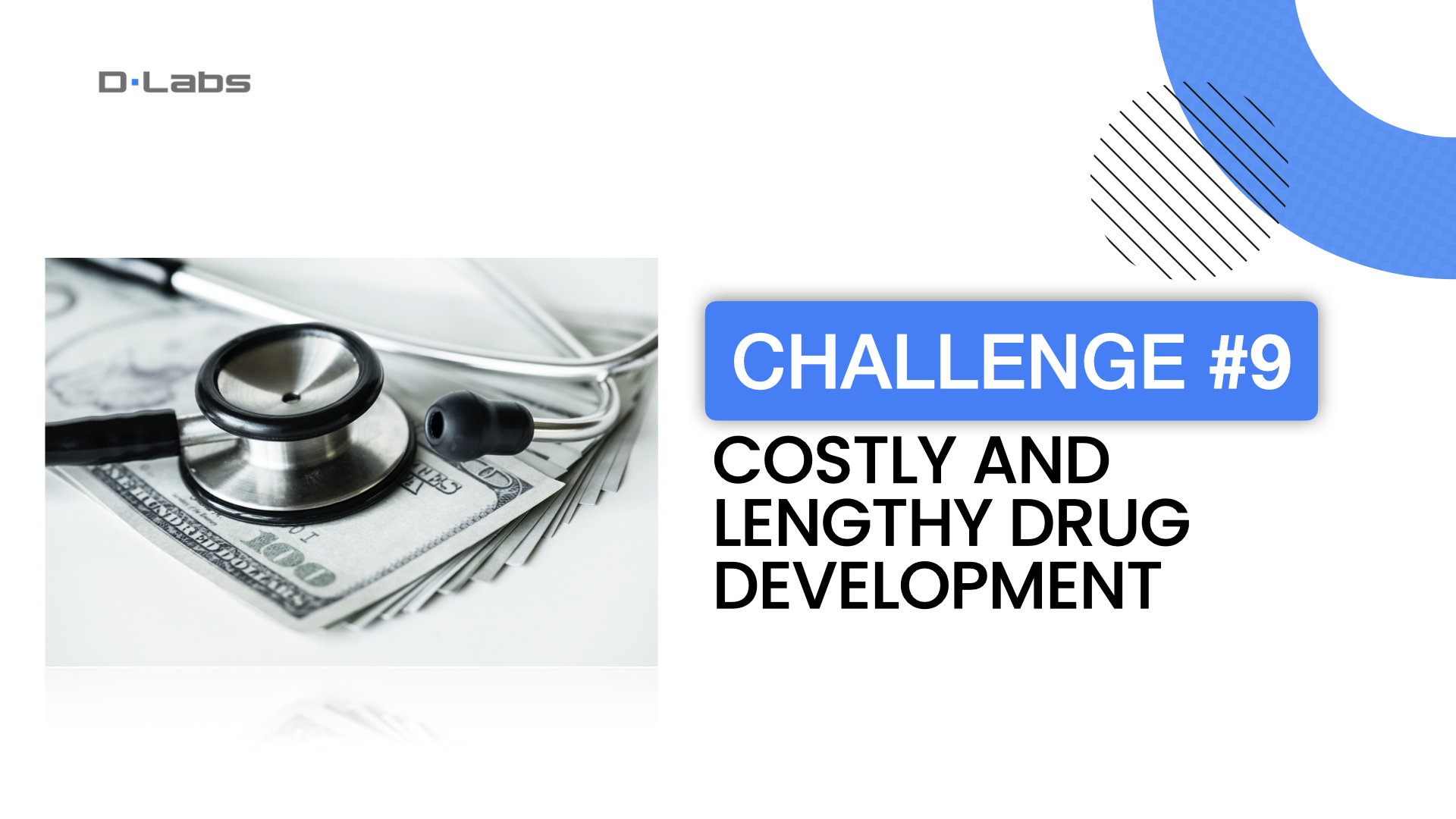
Challenge 9: Costly and lengthy drug development
The next challenge is costly and lengthy drug development. A very popular topic among VC funds and big companies recently like Big 4.

Drug development is an arduous process. The amount spent to develop any individual drug depends mostly on what it costs to conduct studies to prove it is safe, effective and secure regulatory approval. And that can range from $10 million to $2 billion, depending on what the drug is for.
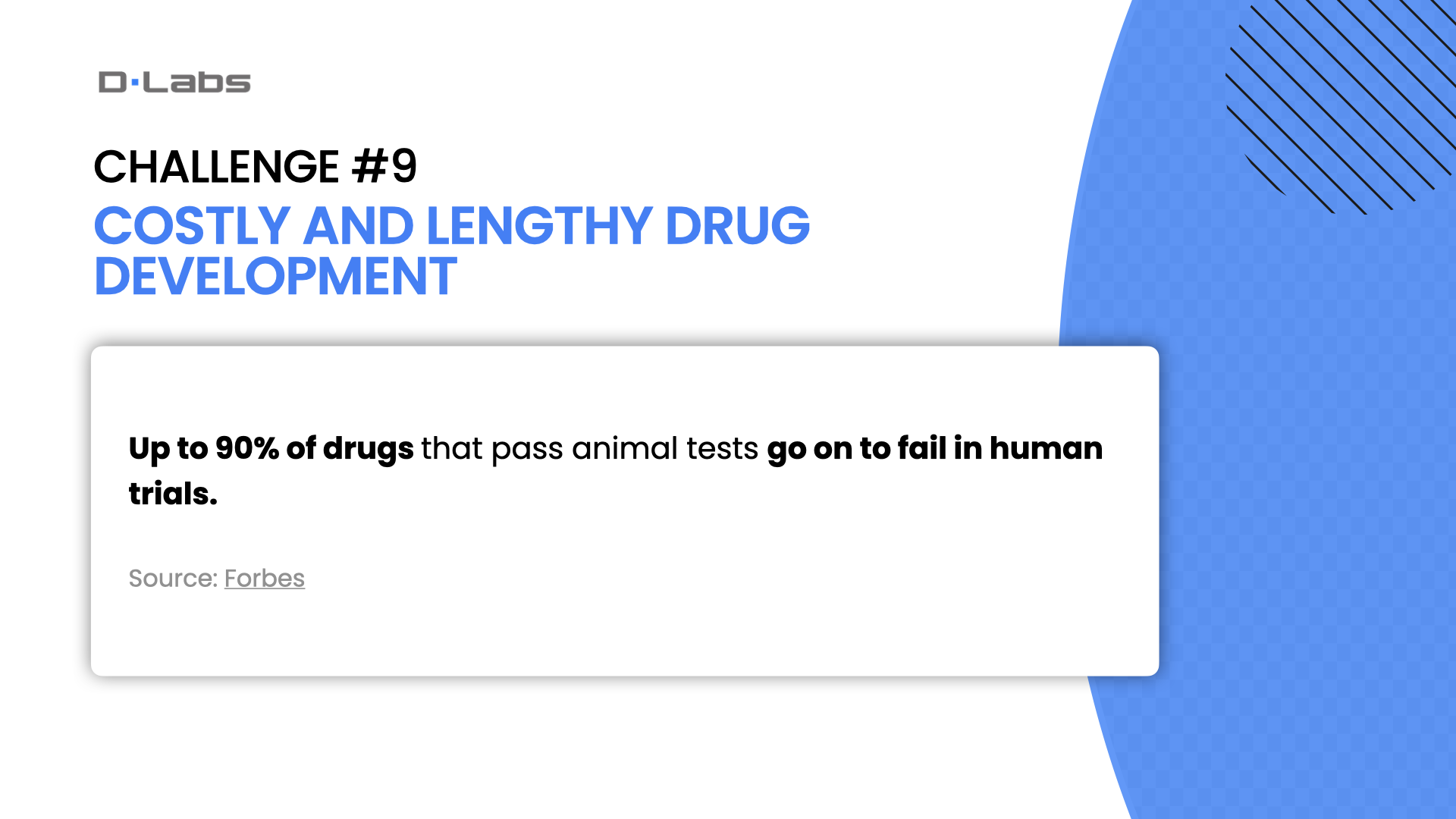
But what really drives that cost is the fact that 90% of medicines that start being tested in people don’t reach the market because they are unsafe or ineffective. And part of the problem is the inefficiency of animal tests that remain the gold standard in pharmaceutical development.
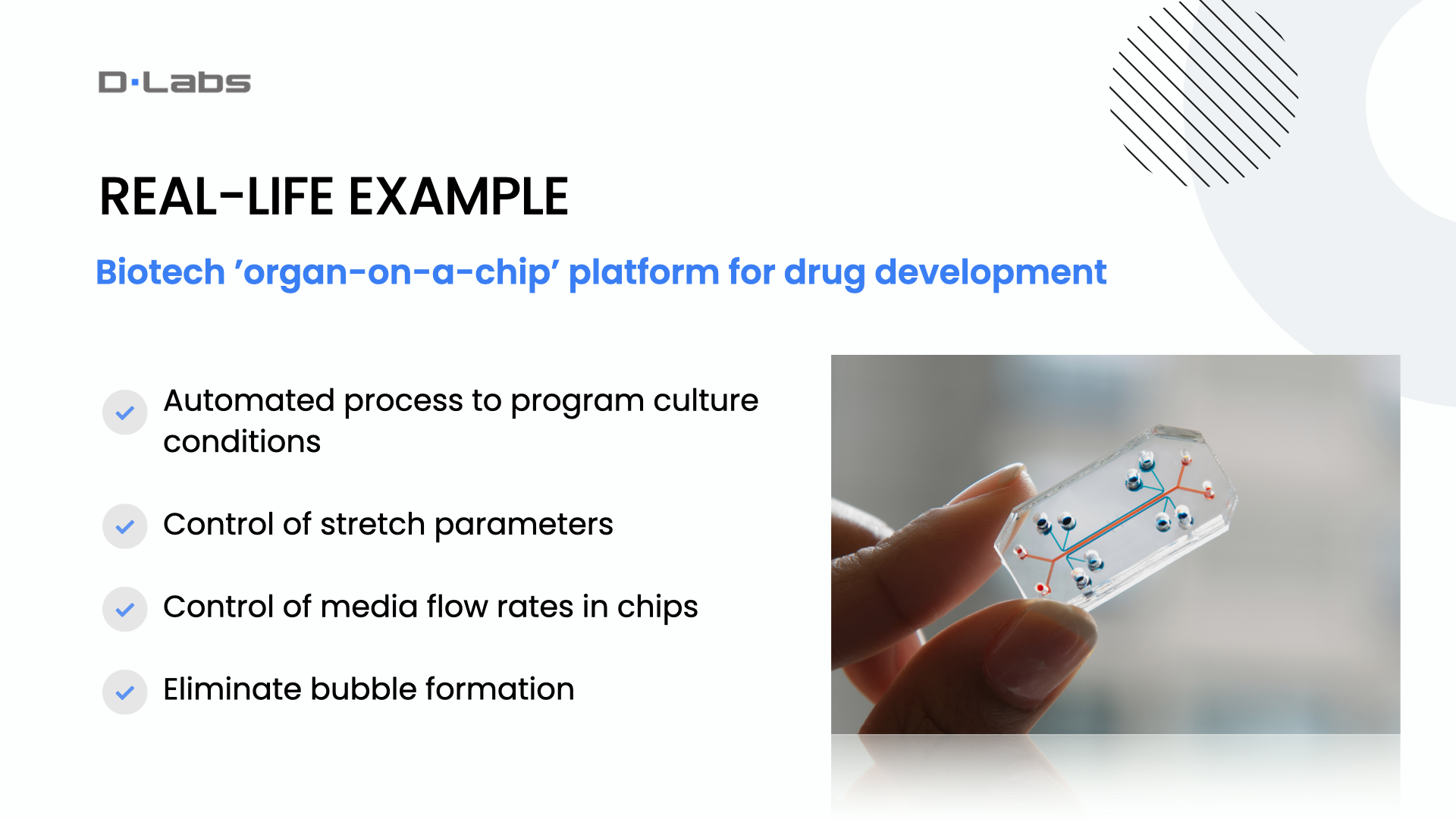
Real-life example: Biotech ‘organ-on-a-chip’ platform for drug development
The needle-in-a-haystack nature of drug discovery has led to staggering and ever-rising R&D costs. AI is resetting the status quo. Machine learning applications slash the time it takes to identify promising molecule candidates, helping researchers focus their efforts where it counts. With faster drug discovery at a lower cost, everyone wins.
An example of this kind of solution is Biotech’s organ-on-a-chip platform for drug development. This embedded IoT system is designed for running, observing, and calibrating studies on the culture module and sending studies and other data to the platform management application via an MQTT protocol for analysis. The system collects various data, such as study status, progress, pressure, and temperature. It has the following key functionality:
- Automated process to program culture conditions
- Control of stretch parameters
- Control of media flow rates in chips
- Functionality to eliminate bubble formation
that can significantly accelerate the time and cost of implementing new drugs.
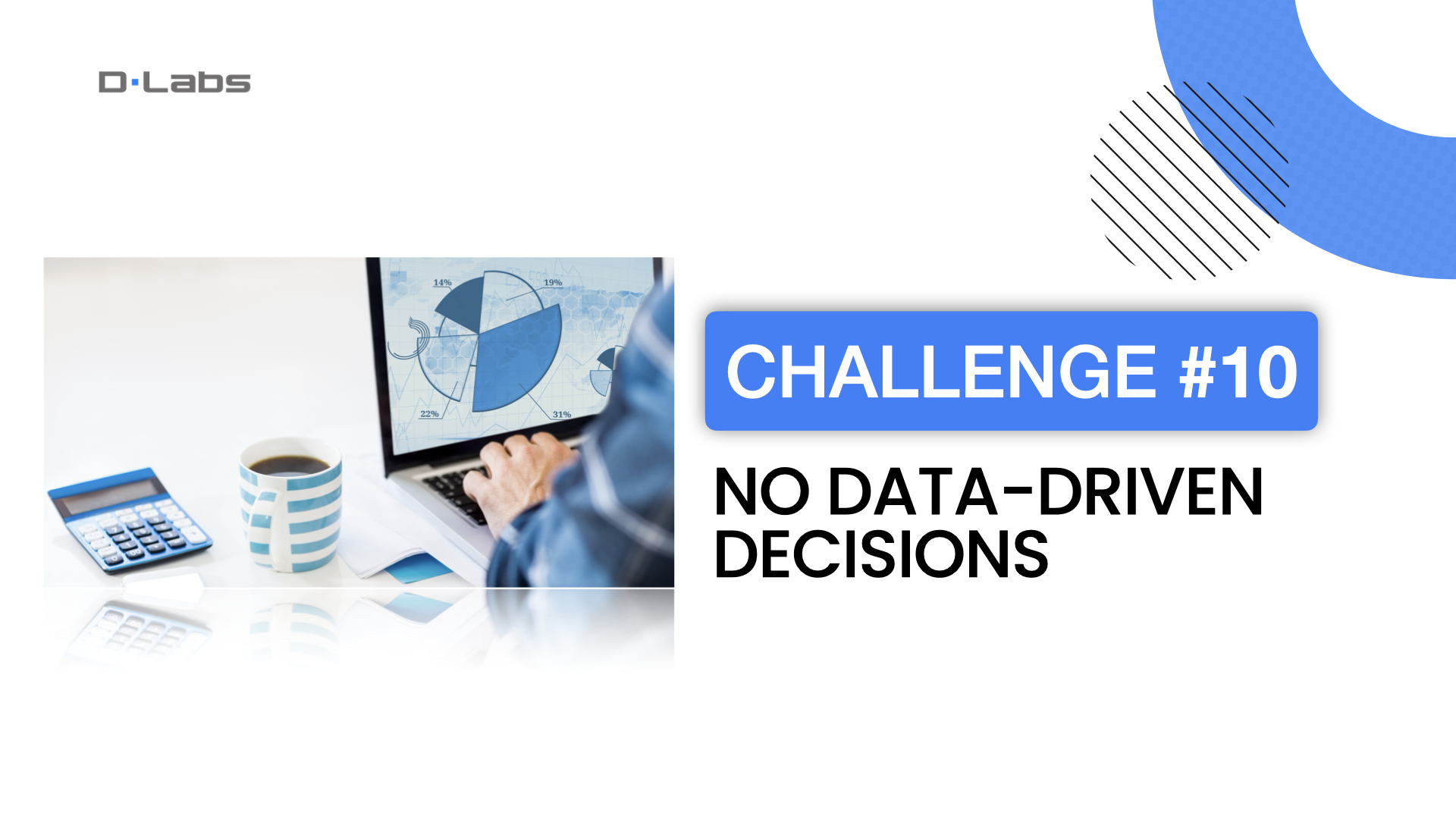
Challenge 10: No data-driven decisions
The last challenge: No data-driven decisions
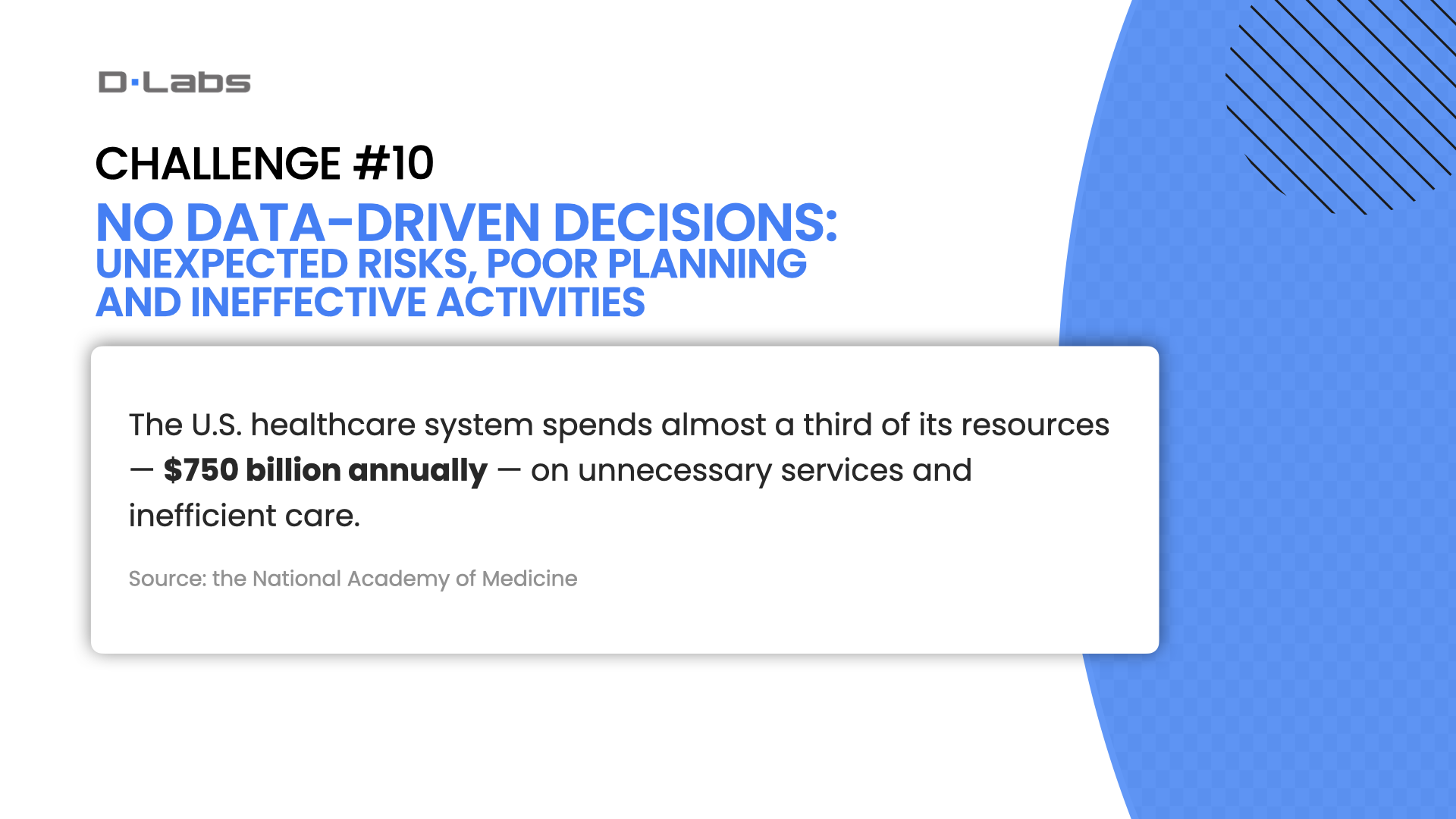
A healthcare industry that found itself fighting in the dark during the opening waves of the pandemic realized that it would need a forecasting system that provides a lens for the uncertainty ahead. Better sightlines can help healthcare companies prepare for shifts in the insurance market, the economy, utilization, consumer behavior, and future waves of infectious disease.
Moreover, better forecasting is also needed in the day-to-day operations of medical facilities. As it turns out, The U.S. healthcare system spends almost a third of its resources — $750 billion annually — on unnecessary services and inefficient care.
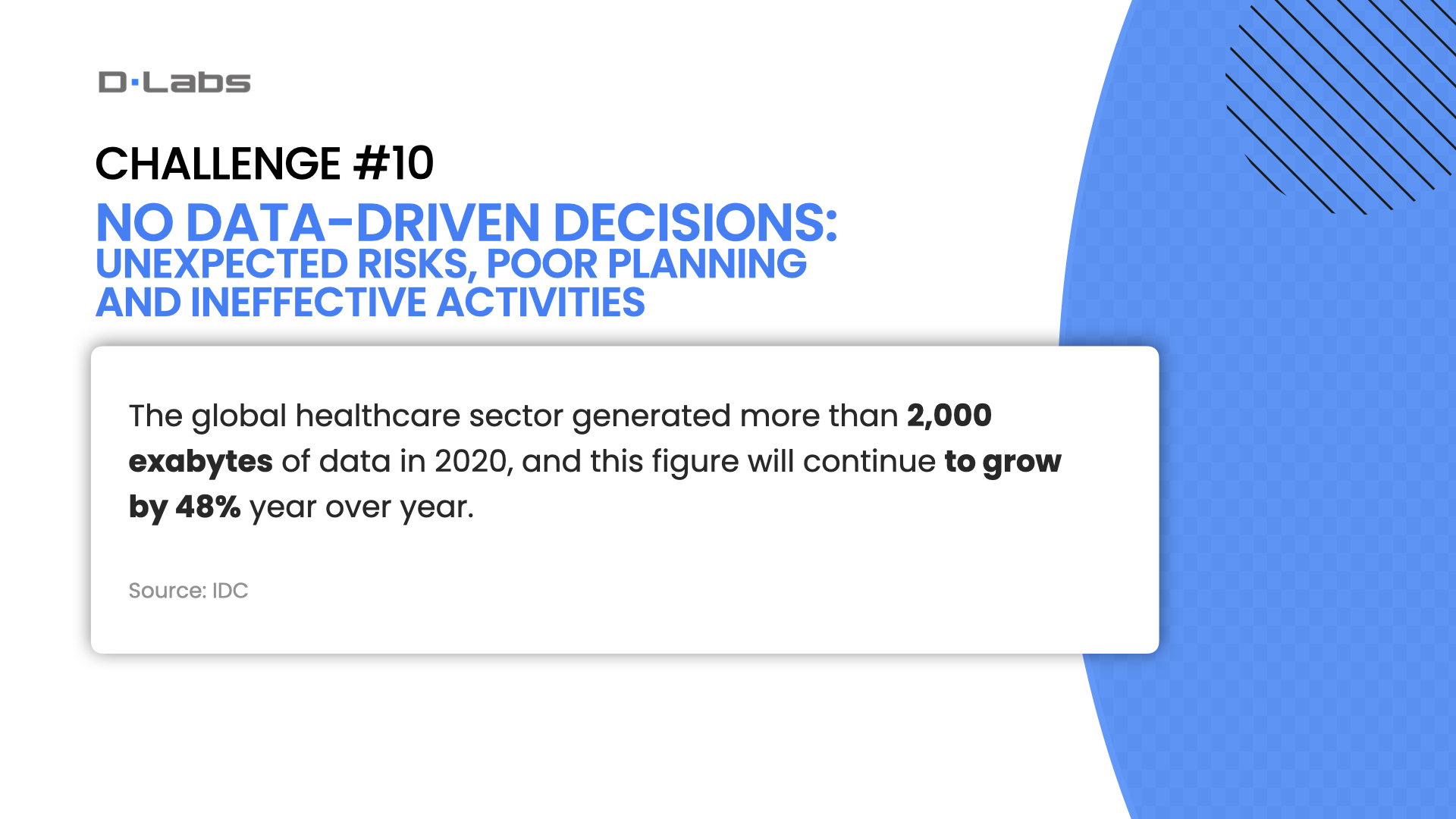
And now, I would like to point out something very important: The healthcare industry produces an enormous amount of data. An IDC study estimates the volume of health data created annually, which hit over 2,000 exabytes in 2020, will continue to grow at a 48% rate year over year. And what exactly is healthcare data? Healthcare data takes many forms. One of the most prominent is electronic health records. EHRs are patient charts that may include various types of both structured and unstructured data, including medical histories, treatment plans, quantifiable lab and test results, and radiology images.
But one of the difficulties with healthcare data is that it includes many other types and sources of data, including paper records and data in legacy systems. There is structured data that relates to health systems’ financial transactions as well as unstructured data such as emails, contracts, call center records, and much more. There is confidential data about employees and benefits as well as patient and employee survey data, disease registries, data about clinical trials and laboratory research, claims for insurance, and many more.
As technology grows, on the market will be more and more data from – for example, wearable devices that generate new health-related data. In addition, as virtual and remote care rise in prominence, these digital services will generate new sources of data that will be stored in new places.
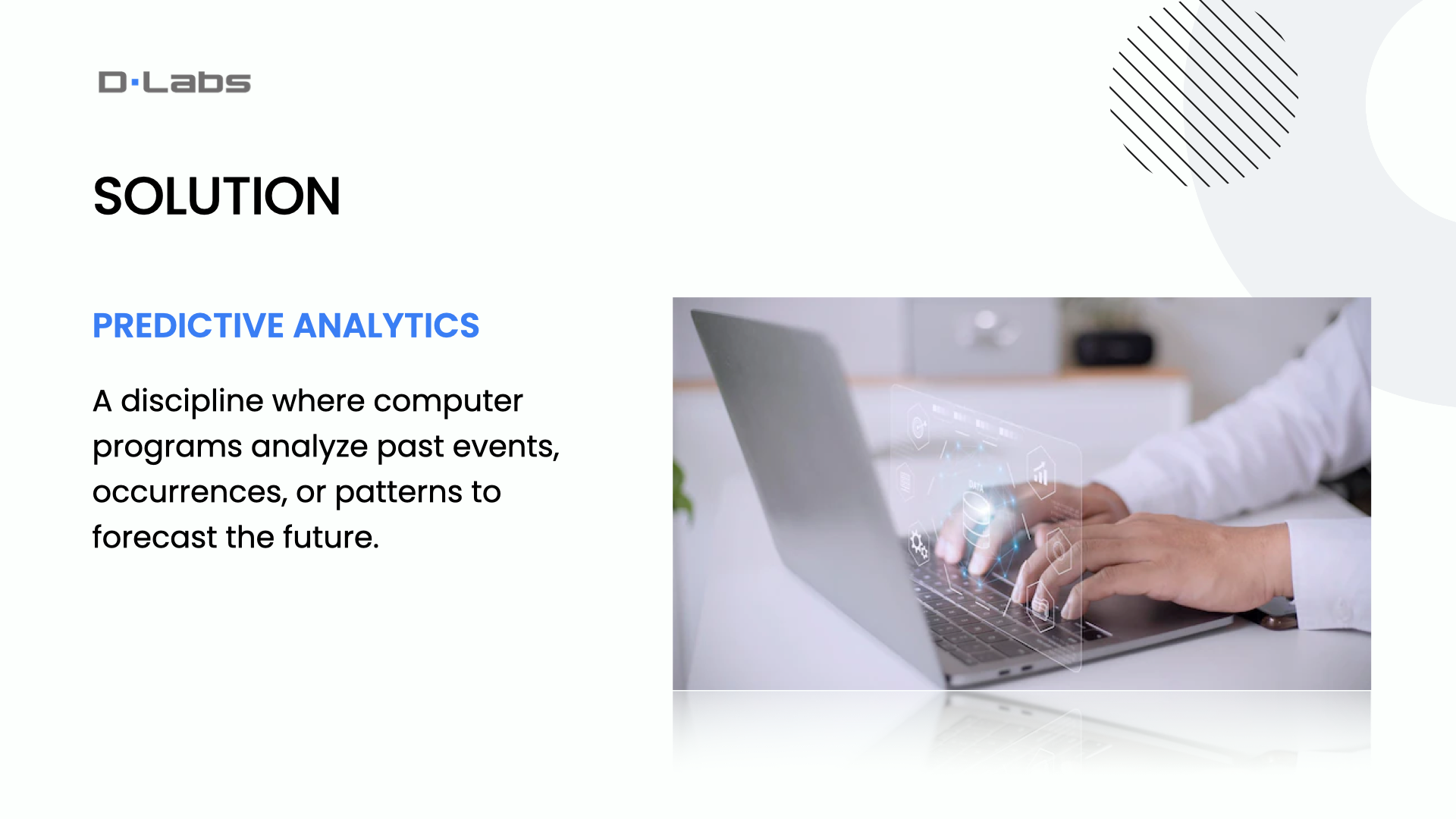
Solution: Predictive analysis
And what relationship does the data have to the aforementioned problem of inappropriate business decisions? So, for most of the problems associated with unpredicted risks, unnecessary services, and inefficient care, data obviously is the key.
First of all, data is helping healthcare providers prevent rapid health deterioration as much as intervening at a time that counts. Thanks to a surge in IoT-powered biomedical sensors, there are as many as 2,314 exabytes of healthcare data available for analysis today.
Predictive analytics is a solution that uses data to analyze past events, occurrences, or patterns to forecast the future in a logical way. And this solution is growing fast in the healthcare industry…

Data shows that healthcare data analytics is on pace to reach a global market value of $78 billion by 2027 and already accounts for 30% of big data by volume.
This solution can help practitioners answer questions like:
- Which diseases are patients likely to develop?
- How will they respond to different treatments?
- Will they be a no-show at their next medical appointment?
- Will they return to the hospital within 30 days of discharge?
- What are the chances this Cancer patient will recover if s/he is subjected to stem cell transplant or hormone therapy?
- What are the chances this newborn baby will develop sepsis?
- Will this general ward patient deteriorate further and need admission to ICU in the next 48 hours?
- How many extra beds will I need to serve a rising number of patients in the second wave of a Coronavirus?
And many more, obviously.
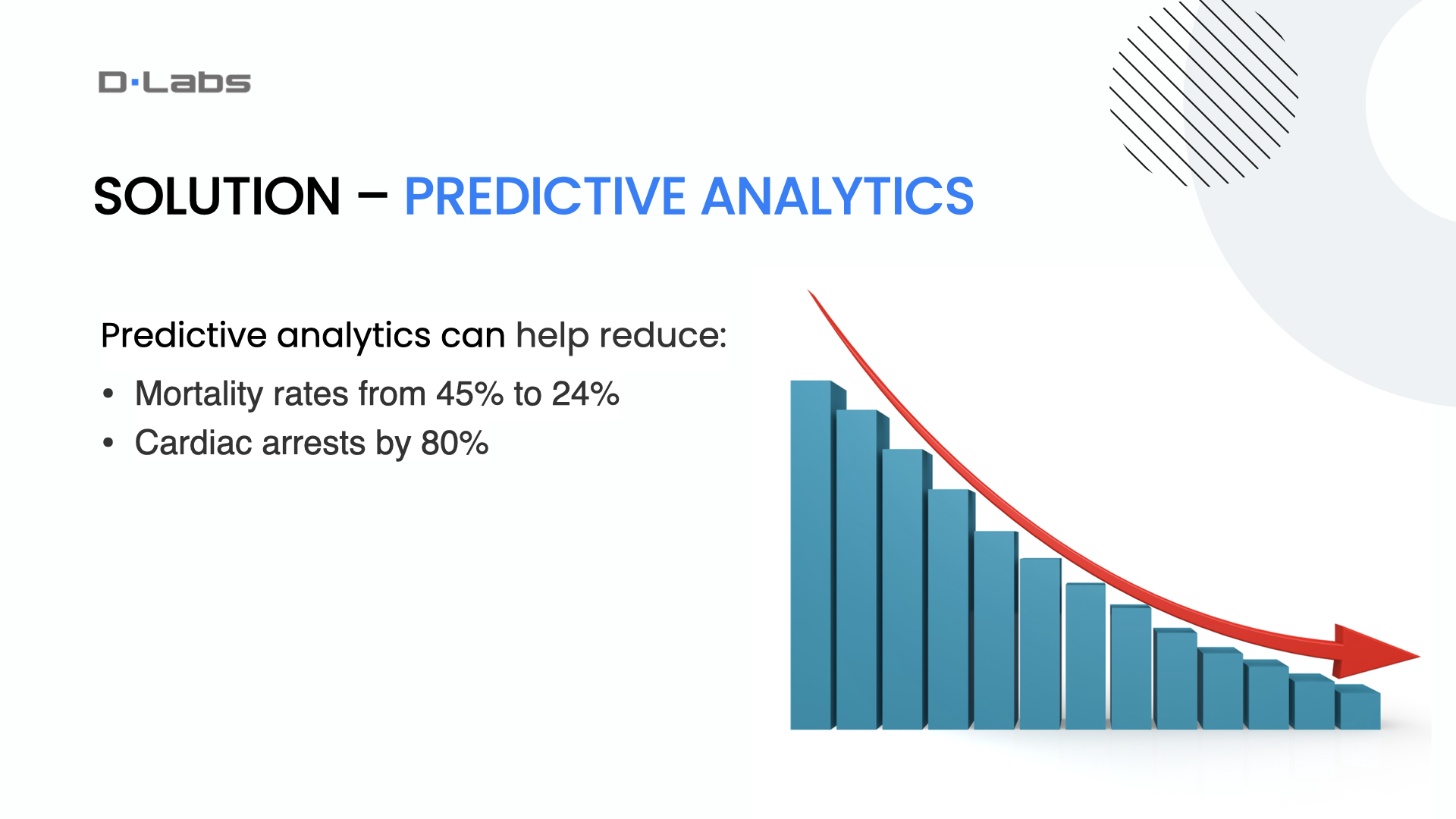
And what about the results? Well, with ready access to data for myriad variables and with predictive analytics, risk prediction has come of age in healthcare. At the patient level, AI-driven risk assessment can help with early interventions against devastating and costly diseases. Data shows that this solution can reduce the mortality rate from 45% to 24% and cardiac arrest counts by 80%. On the macro level, big data and predictive analytics can even forecast epidemics.
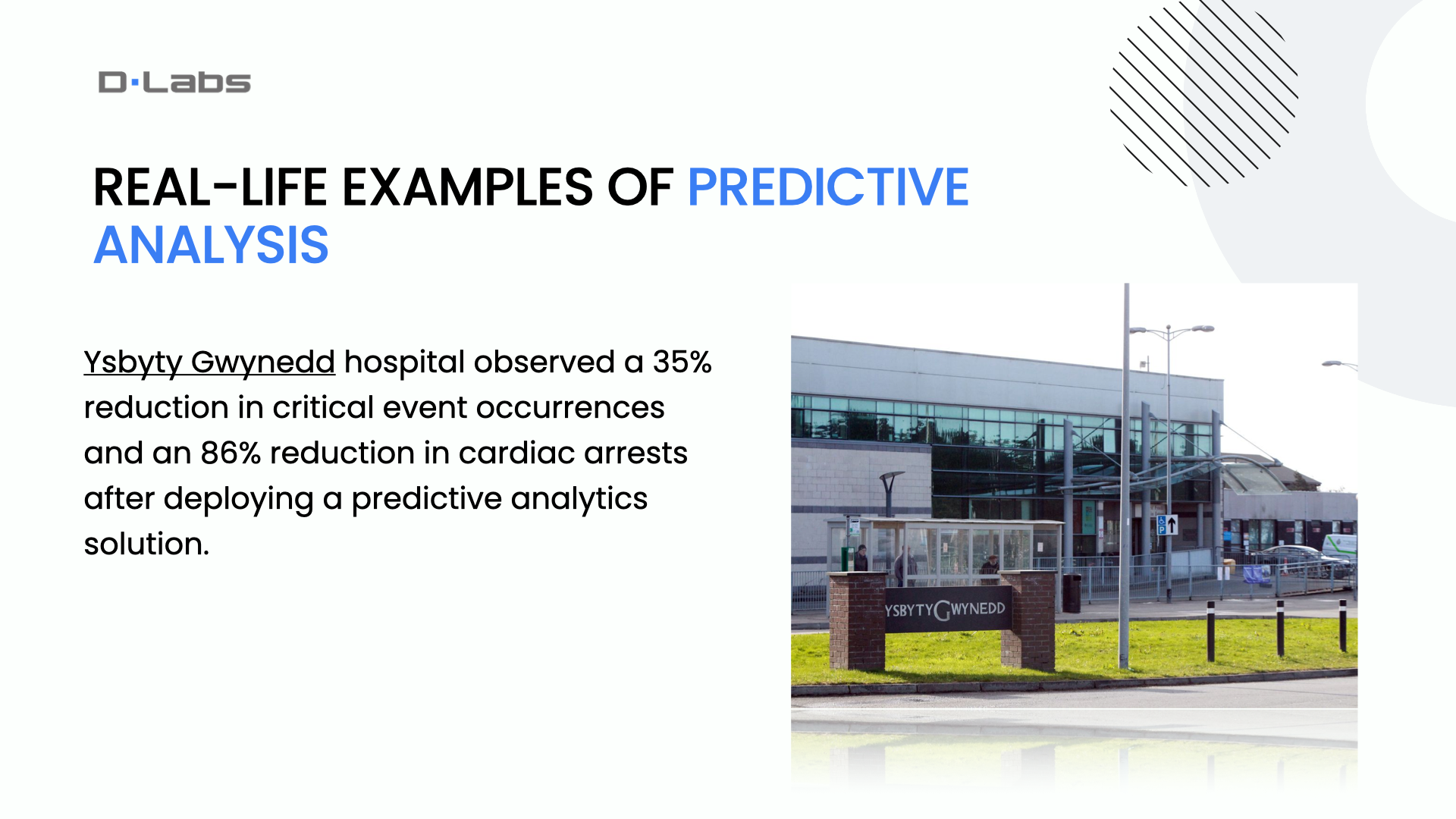
There is a mass of remarkable examples of using predictive analytics. One of them is Ysbyty Gwynedd hospital which observed a 35% reduction in critical event occurrences and an 86% reduction in cardiac arrests after deploying a predictive analytics solution.
But predictive analytics doesn’t just have to be used to predict the risk of a disease or epidemic. From a more business-oriented perspective, it can also be used to predict sales performance, the number of users or the results of a marketing campaign, etc.. You can use it any way you want, depending on your needs and the data you have.
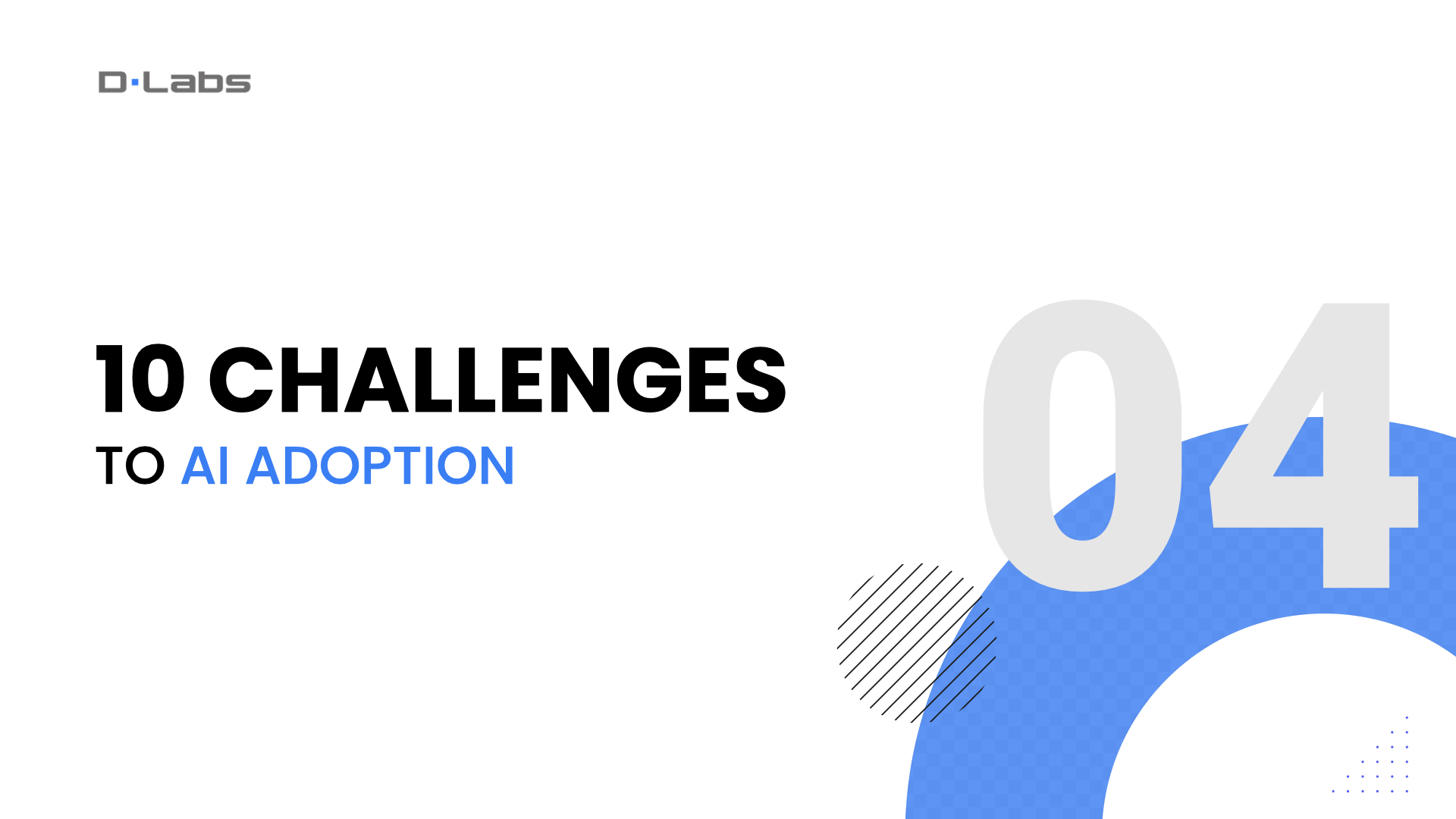
10 challenges to AI adoption
Ok, a short break for coffee. Enough of the statistics. Let’s talk a bit about practical challenges in building AI businesses and solutions.

AI implementation challenges: Your company doesn’t understand the need for AI
Inertia is a powerful force. After all, if a company is doing well, teams often feel reluctant to take a risk by making a significant change. And adopting new technology, like artificial intelligence, will feel like a major shift. Next up, there’s the challenge of convincing stakeholders to invest in a solution for which the returns can be somewhat unclear. Because, where AI is concerned, you won’t always know what you’re building until you’ve made a start, which is another tricky obstacle to overcome.

AI implementation challenges: Your company lack the appropriate data
The only way to build and train effective AI is with a sufficient amount of high-quality data. And the better the data, the better the outcomes. But a lack of stakeholder buy-in can cause companies to underinvest in the data management systems required to enable AI, leaving them unable to train an algorithm on how to solve their business problems accurately.
That said — if your company uses a CRM tool to collect customer demographics, purchase behavior, or on-site interactions, you may have a data set you can use. And where there are gaps, online data libraries, even synthetic data, can often fill them. But if your company isn’t interested in AI in principle, then you won’t know what data you need, let alone how to structure it.
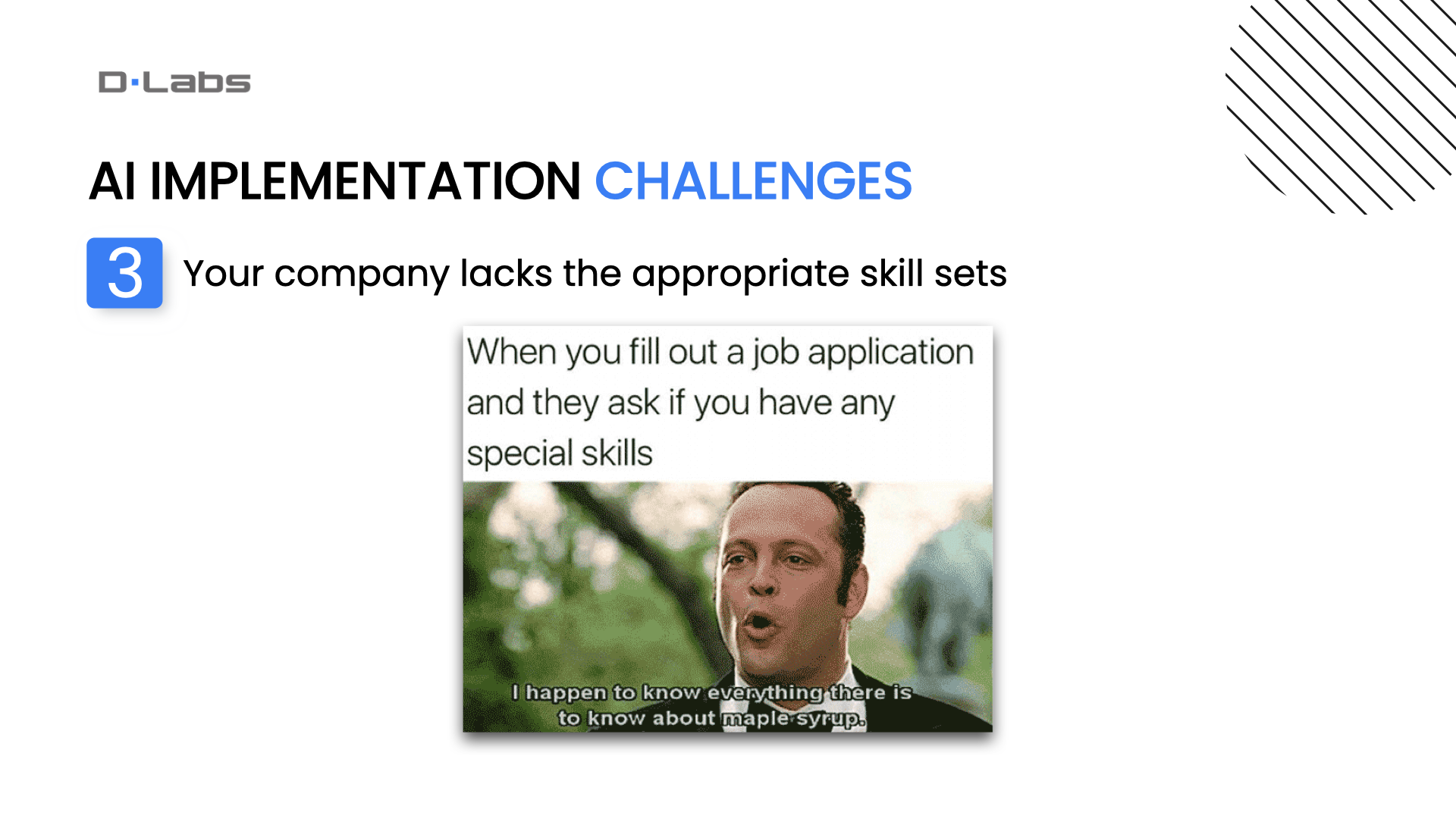
AI implementation challenges: Your company lacks the appropriate skill sets
Data is only half the equation. You need the right skill sets to make AI work. Yet many companies struggle to hire data and machine learning specialists, leaving them unable to take their ambitions further. And even where companies have a degree of in-house expertise, a lack of experience in the right fields can hinder progress; it can even affect hiring, as departments won’t know which roles to fill or how to assess candidates.
In some circumstances, heads of departments are simply underqualified to lead an AI implementation, resulting in inefficient processes, integration issues, or ongoing manual work that undermines the solution’s value.
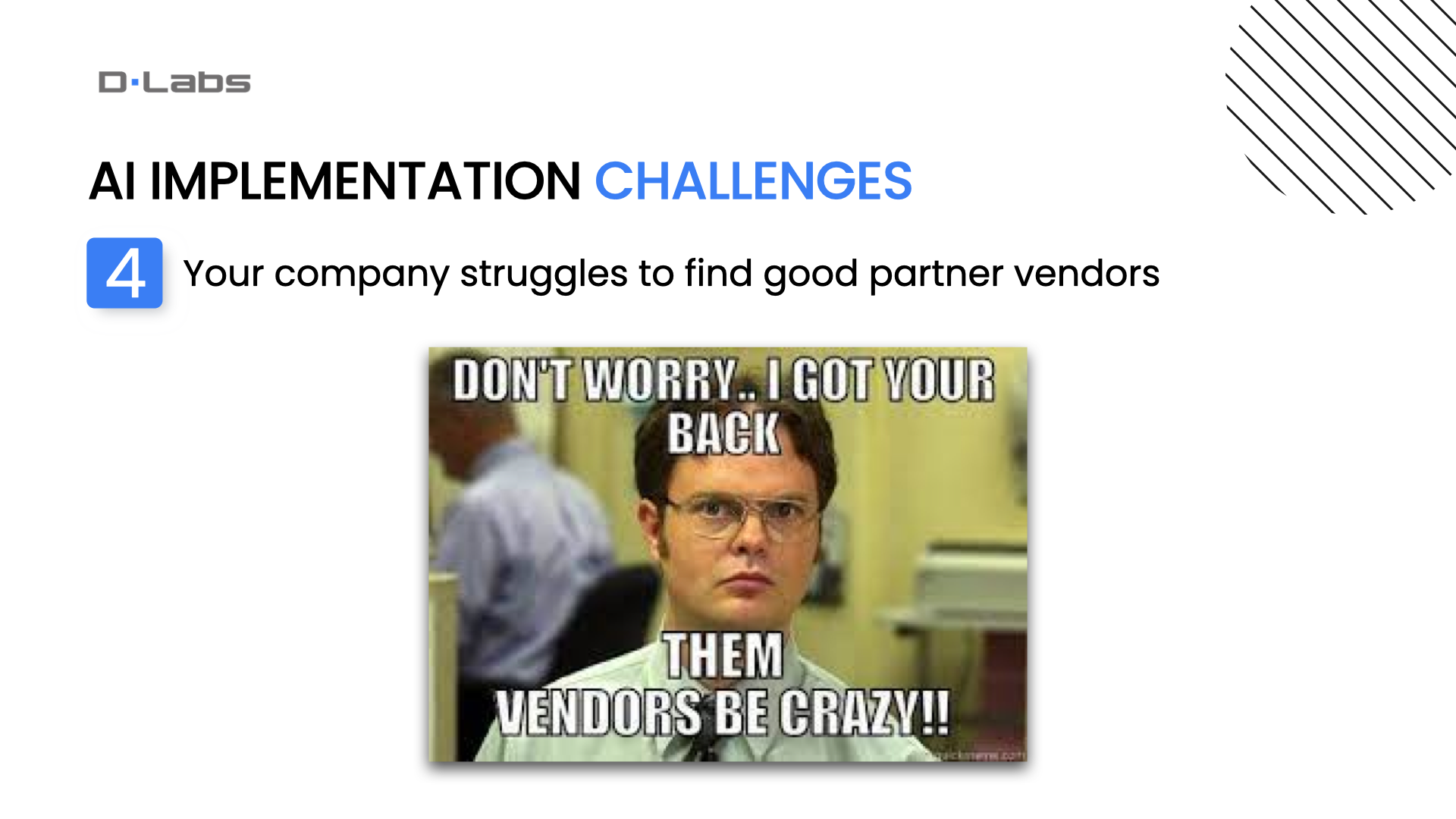
AI implementation challenges: Your company struggles to find good partner vendors
Despite its growth, AI adoption in most businesses remains modest. One reason for this is many organizations have worked with AI agencies that don’t truly understand how to use the technology to deliver business value. As a result, many companies have had negative experiences when dipping their toes in AI development, making them reluctant to dive in. Whereas had they worked with reputable and experienced AI vendors at the outset, the results would speak for themselves. Better still, had the vendors offered to tackle a small business problem first, proving the value of AI, the stakeholders would have found it easier to embrace more ambitious plans later on.

AI implementation challenges: Your company can’t find an appropriate use case
Some organizations think that by implementing AI just for the sake of it, they will encourage company-wide adoption. Sadly, this strategy often has the opposite effect. When a company doesn’t have a solid use case, it’ll struggle to create a solution that delivers business value. As a result, there’ll be no way to prove that artificial intelligence can solve everyday challenges. In all likelihood, the strategy will only reinforce the indifference felt towards the technology, so it’s best to delay adopting AI until you know how you’ll use it.

AI implementation challenges: An AI team fails to explain how a solution works
In our experience, people will only trust a computer model if they understand how it works. This is another very interesting trend nowadays. And if an AI team can’t offer an explanation, implementations can end there. The challenge only grows in situations where a model’s output contradicts a stakeholder’s thinking — because stakeholders always want to know why a decision is wrong and why they should consider changing their mind.
Let’s put this in a medical context for clarity. Suppose a doctor diagnoses a patient, only for an algorithm to disagree. The doctor will need to know the logic behind the machine’s thinking before they can sign off on the alternate diagnosis, say, by seeing that a model used symptoms like sneezing and headaches to diagnose flu, not characteristics like a patient’s age or weight. But offering transparency isn’t always simple as ‘black box’ models often spit out a prediction without a rationale. Leaving stakeholders without a way to validate the output.

AI implementation challenges: Different AI teams fail to work as a unit
In large companies, AI teams often end up working in silos, meaning that while they use the same technologies, they do so in isolation. As a result, they build different infrastructures and adopt different workflows, which only complicates broader AI adoption. You can avoid this by using a ‘hub-and-spoke’ structure, whereby one central unit aligns all teams around a standardized approach. That way, any investment in AI benefits the whole organization and brings economies of scale as you roll solutions out.
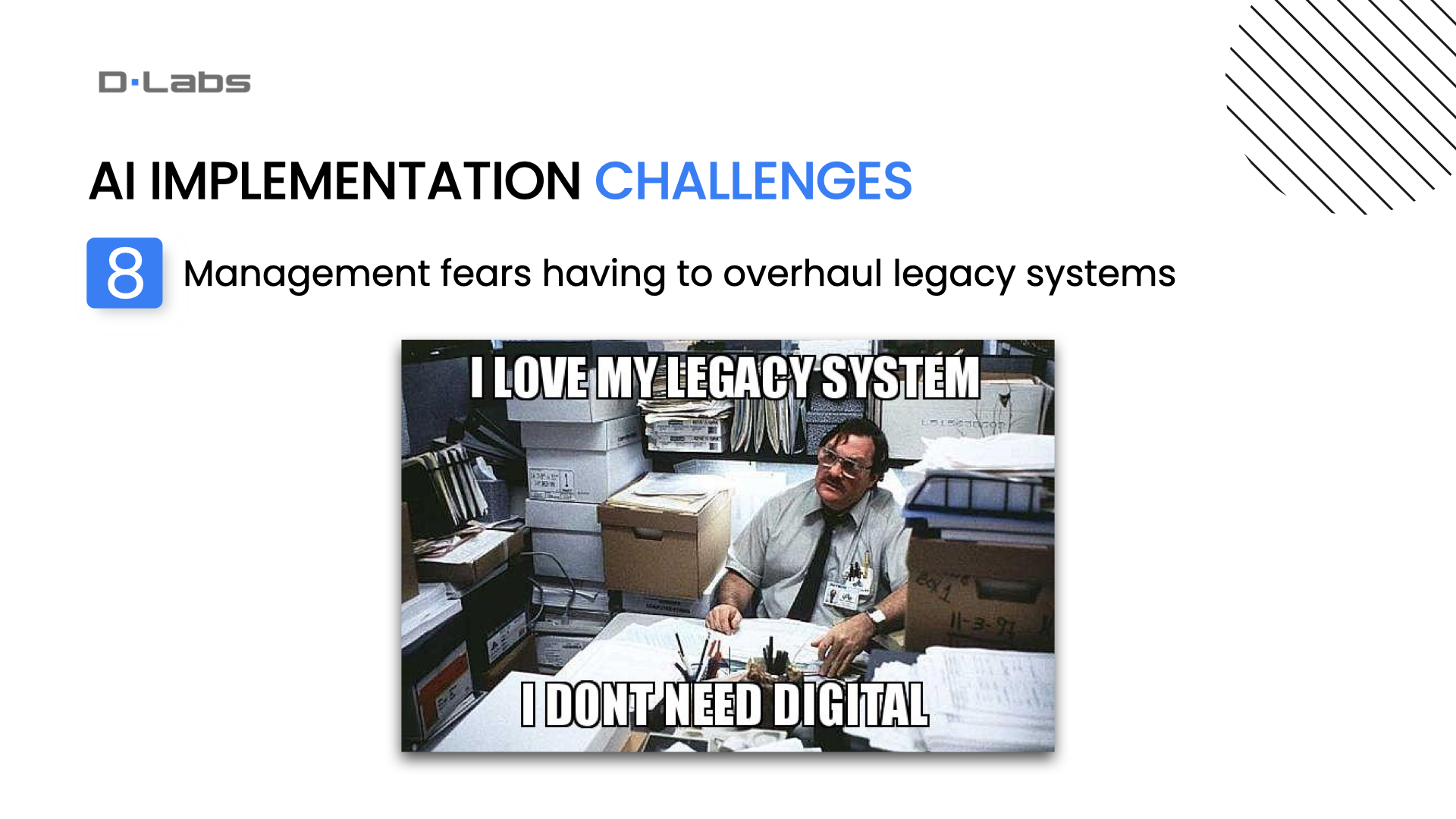
AI implementation challenges: Management fears having to overhaul legacy system
It’s astonishing how many organizations still rely on outdated infrastructure, applications, and devices to power their IT operations. And management often chooses not to adopt AI for fear of the costs of upgrading these systems. But the truth is: cloud computing means you can deploy AI without overhauling an antiquated IT network, using ‘Data Lake’ functions in hybrid environments. Doing so might require your company to have an operational framework on-premises. But you still get to benefit from more effective, AI-driven operations.
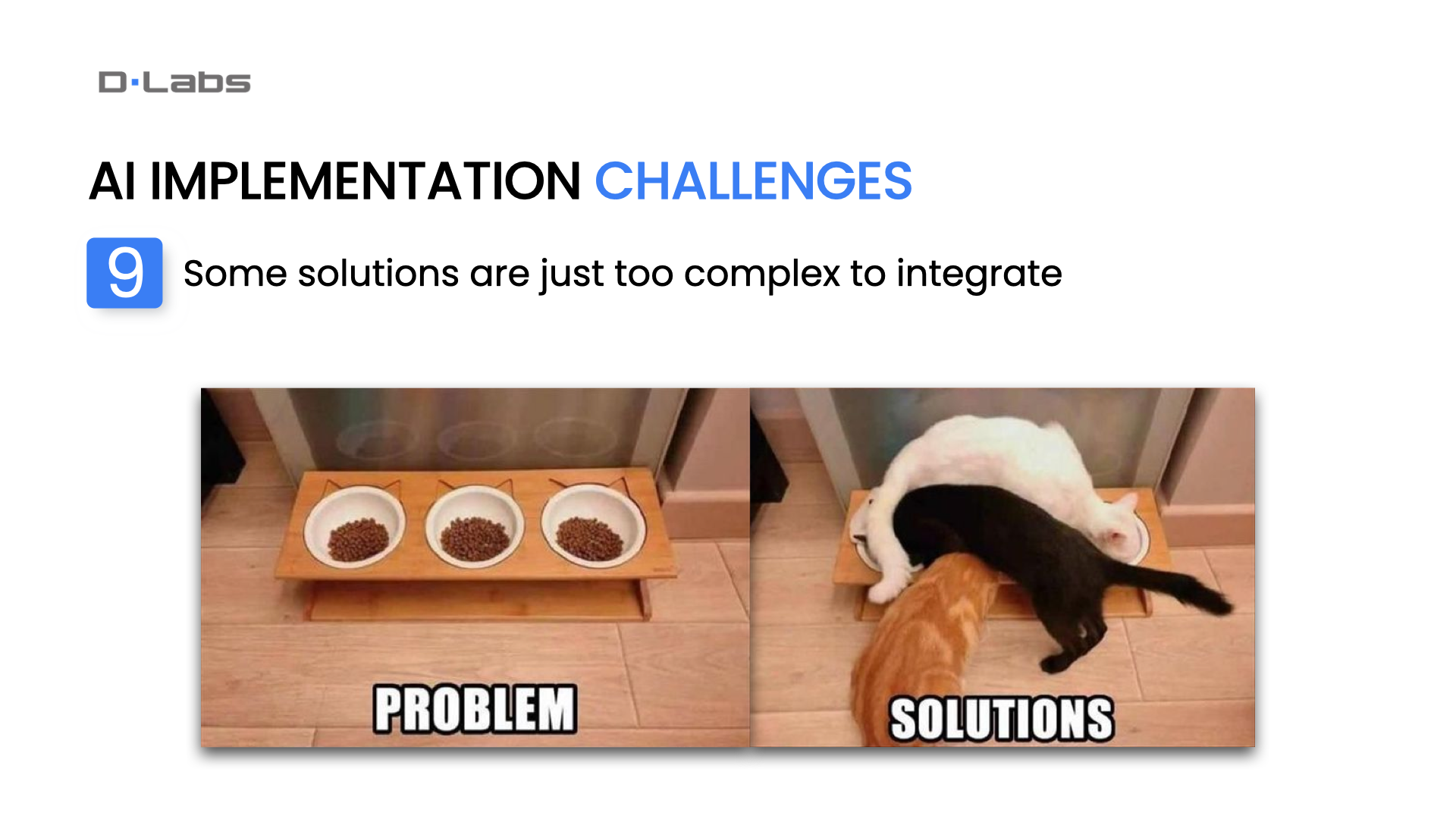
AI implementation challenges: Some solutions are just too complex to integrate
Even if you manage to design a ground-breaking AI solution, there’s no guarantee your company will adopt it. That’s something Netflix discovered, at a great cost, in 2009.
The streaming giant offered a one-million-dollar prize to any developer that could increase the accuracy of its recommendation engine. And while one team managed to optimize it by some 10%, Netflix never integrated the upgrade. Why so? They said it required too much engineering effort, and so: complexity meant the solution never saw the light of day.
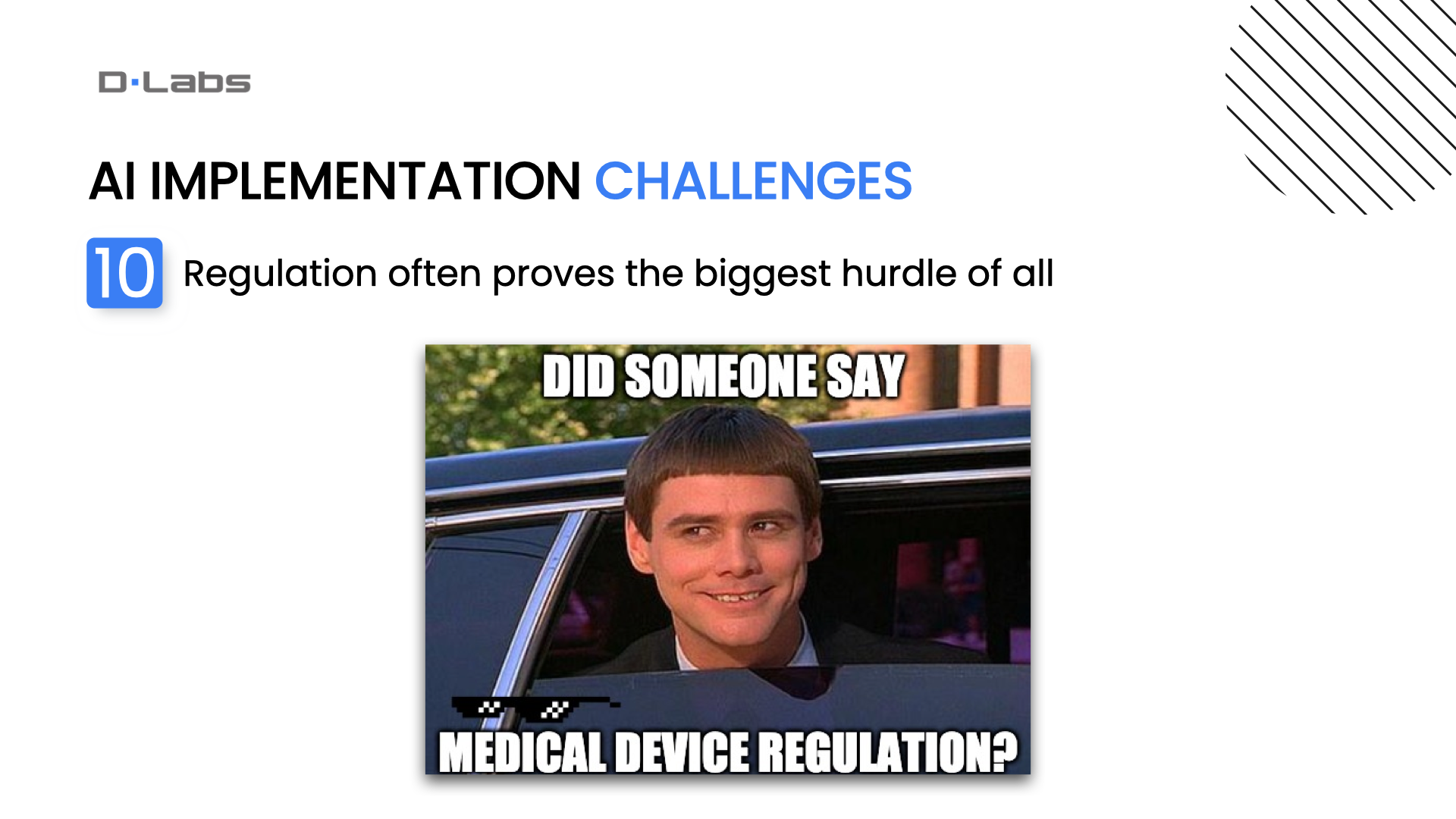
AI implementation challenges: Regulation often proves the biggest hurdle of all
Suppose a doctor changes the diagnosis based on a machine’s recommendation, only for the machine to be wrong. Is the practitioner to blame? Or is it down to the algorithm’s developer? These are ethical questions that regulators are yet to answer. Then, there’s the question of data management. When you build an AI solution, you need to collect vast quantities of data and whether that data is sensitive or not, you need to keep it adequately secure. Failure to do so and regulations mean your company could face a significant fine.
Therein lies a risk that many organizations would rather not take.

Common risks when building a new AI-based business model & how to avoid them
Ok, now let’s review the most common risks when building new business models based on AI and consider how to avoid them.

1. Introducing program bias into decision making
One of the more damaging risks of artificial intelligence is introducing bias into decision-making algorithms. AI systems learn from the dataset on which they were trained, and depending upon how this compilation occurred, there is potential for the dataset to reflect assumptions or biases. These biases could then influence system decision-making.
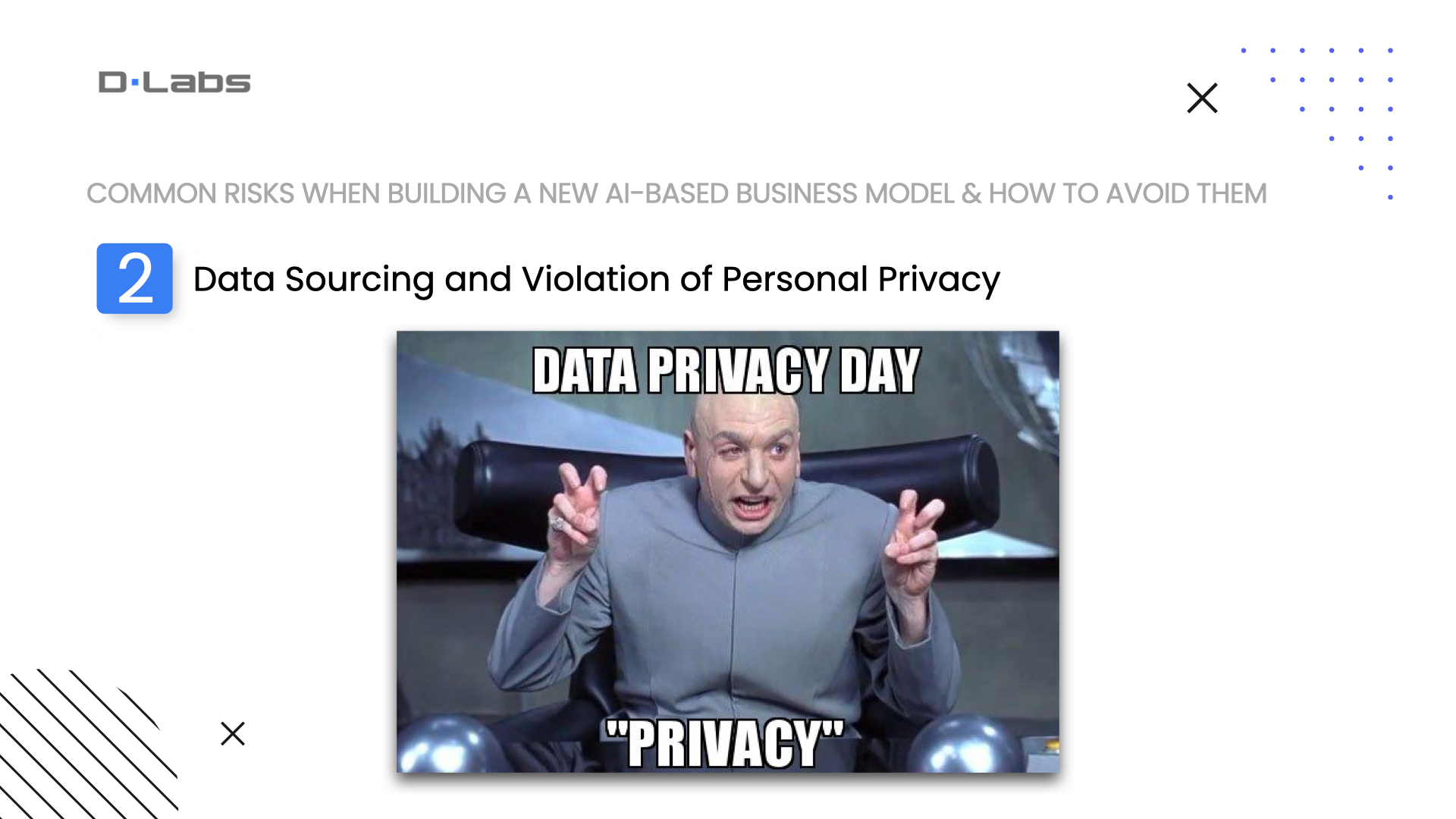
2. Data sourcing and violation of personal privacy
With the International Data Corporation predicting that the global data sphere will grow from 33 zettabytes – it’s 33 trillion gigabytes in 2018 to 175 zettabytes (175 trillion gigabytes) by 2025, vast amounts of structured and unstructured data are available for companies to mine, manipulate, and manage. As this datasphere continues to experience exponential growth, the risks of exposing customer or employee data will only increase, and personal privacy will become harder to protect. When data leaks or breaches occur, the resulting fallout can significantly damage a company’s reputation and represent potential legal violations, with many legislative bodies now passing regulations that restrict how personal data can be processed.
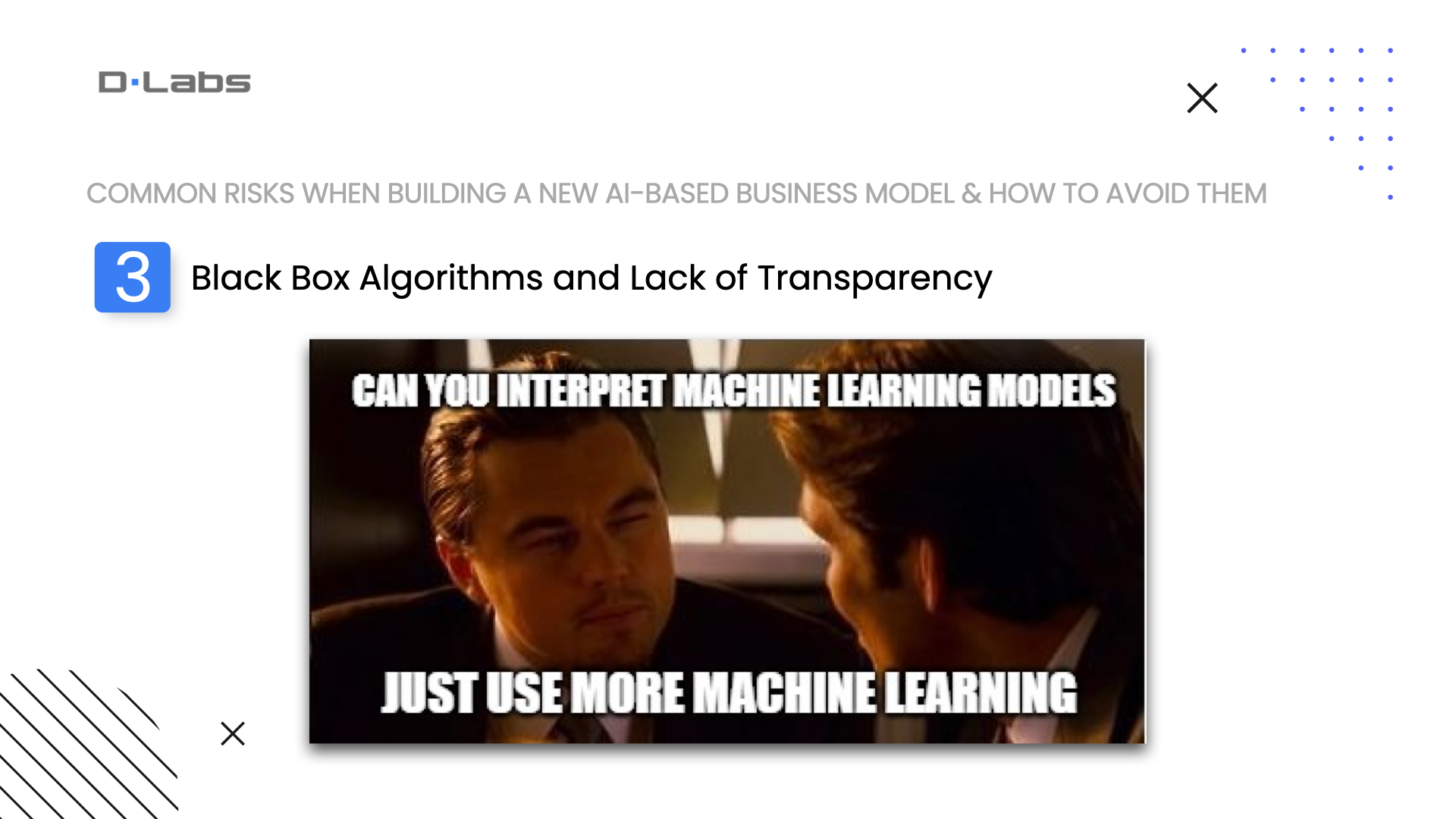
3. Black box algorithms and lack of transparency
The primary purpose of many AI systems is to make predictions, and as such, the algorithms can be so inordinately complex that even those who created the algorithm cannot thoroughly explain how the variables combined together to reach the resulting prediction. This lack of transparency is the reason why some algorithms are referred to as a “black box” and why legislative bodies are now beginning to investigate what checks and balances may need to be put in place. Maybe the explainable AI can help with this.
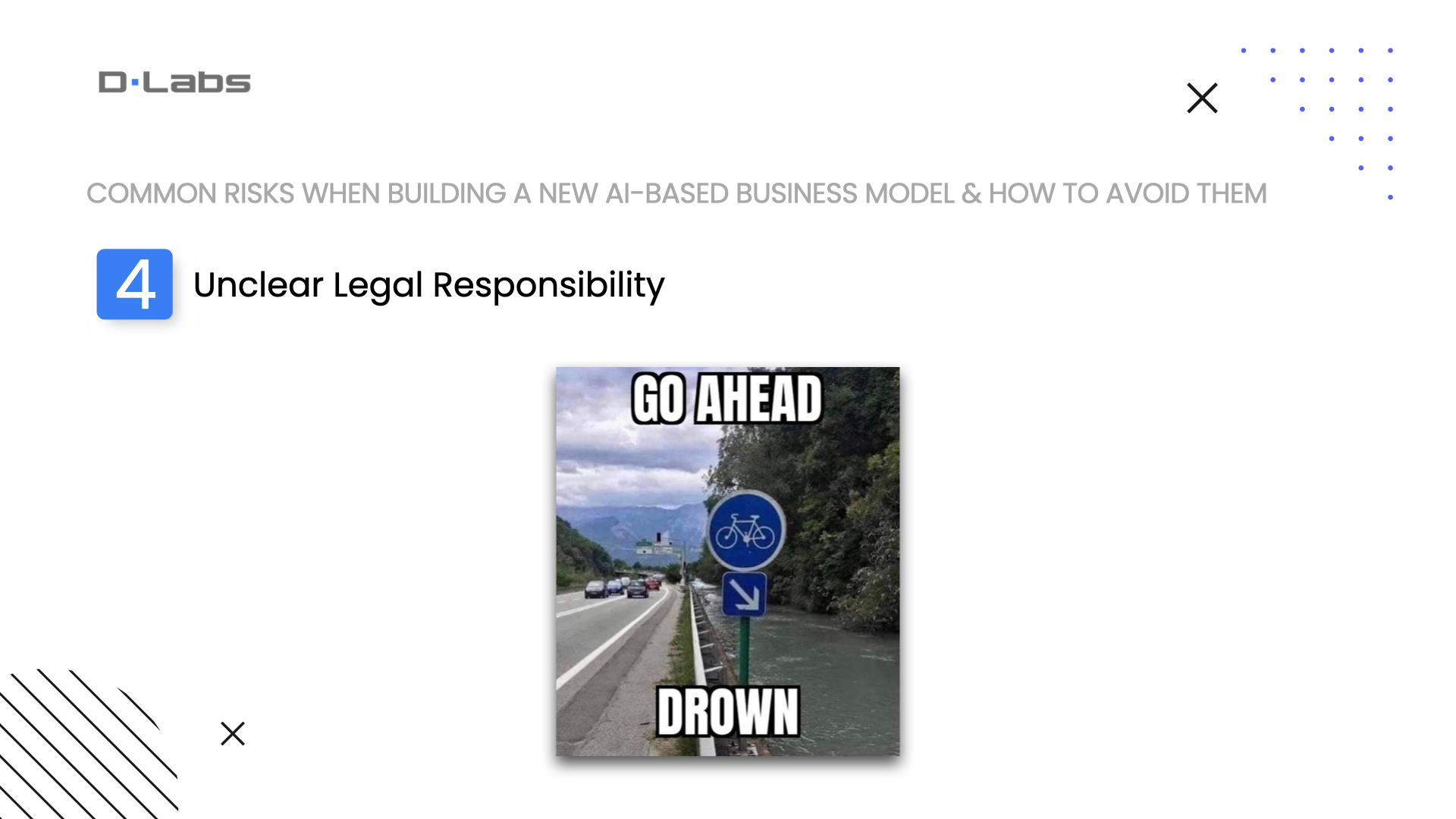
4. Unclear legal responsibility
Considering the potential risks of artificial intelligence discussed so far, these concerns lead to the question of legal responsibility. For instance, if an AI system is designed with fuzzy algorithms, and machine learning allows the decision-making to refine itself, then who is legally responsible for the outcome? Is it the company, the programmer, or the system?
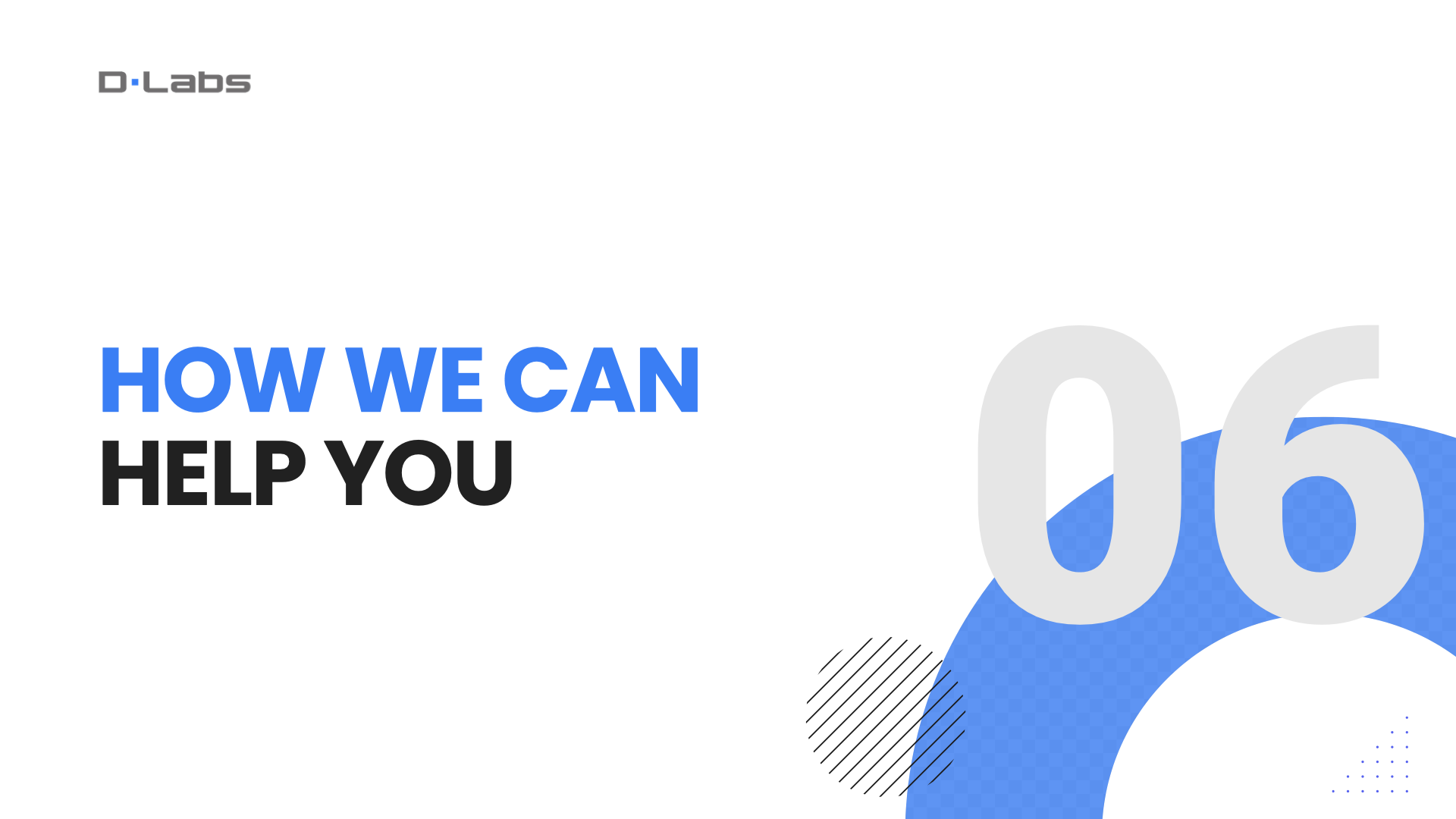
How we can help you
And every problem and challenge is different and must be looked at individually. Fortunately, my team and I know how to avoid all those risks associated with AI implementation, so here’s a bit of how we can help.
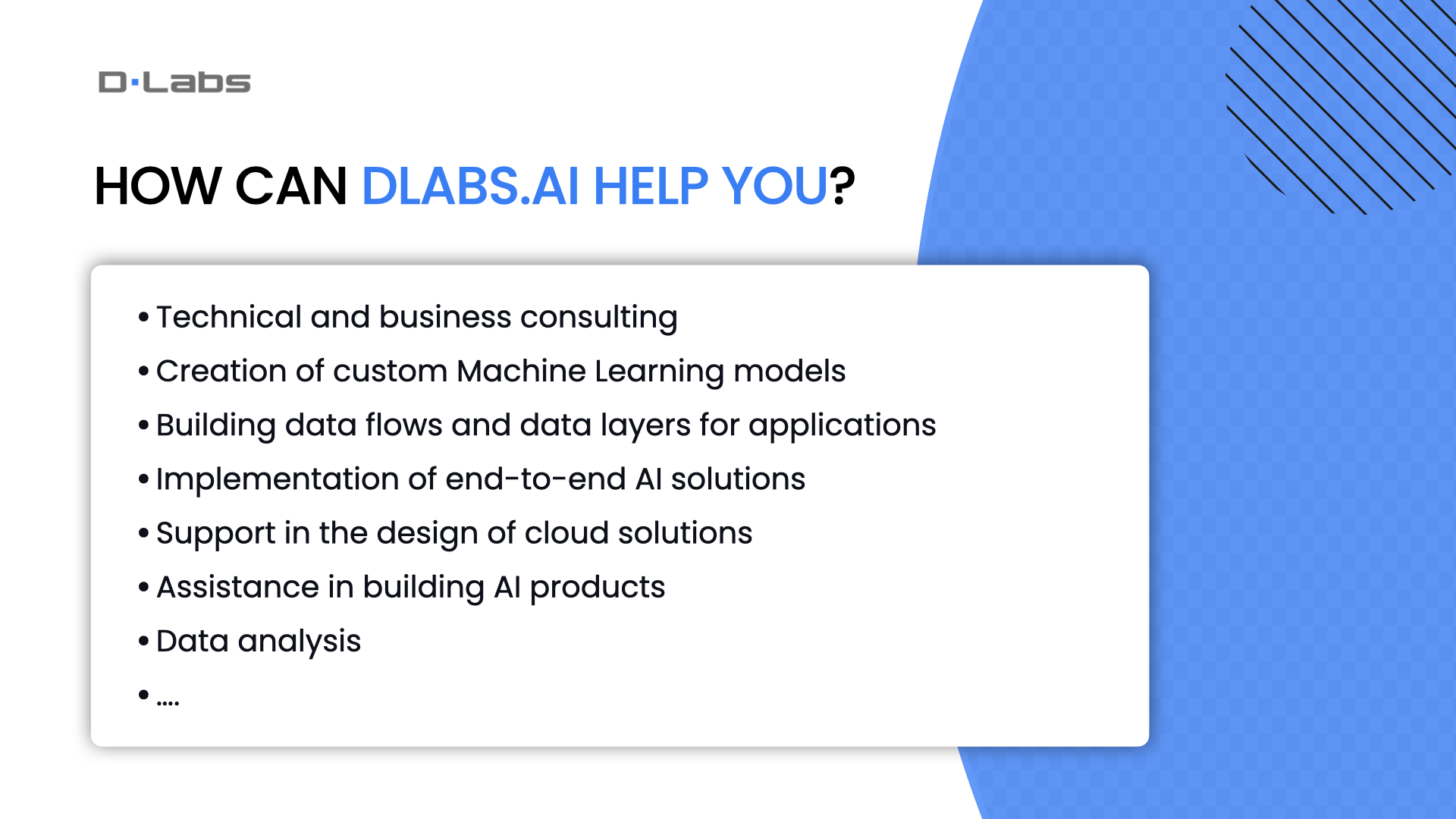
If you are planning to implement AI but don’t know how to get started – I will be more than happy to help you. As I mentioned in the introduction, my company has its roots in creating an AI product for diabetics, and healthcare is the industry closest to my heart.
And exactly what kind of support are we able to offer? As you can see on the slide, we offer consulting, and assistance in building AI products and creating an entire end-to-end AI solution. Our team includes not only AI experts but also Frontend, Backend, or QA specialists, so we are able to build the entire project from scratch. We help you with digital transformation or digital building products.
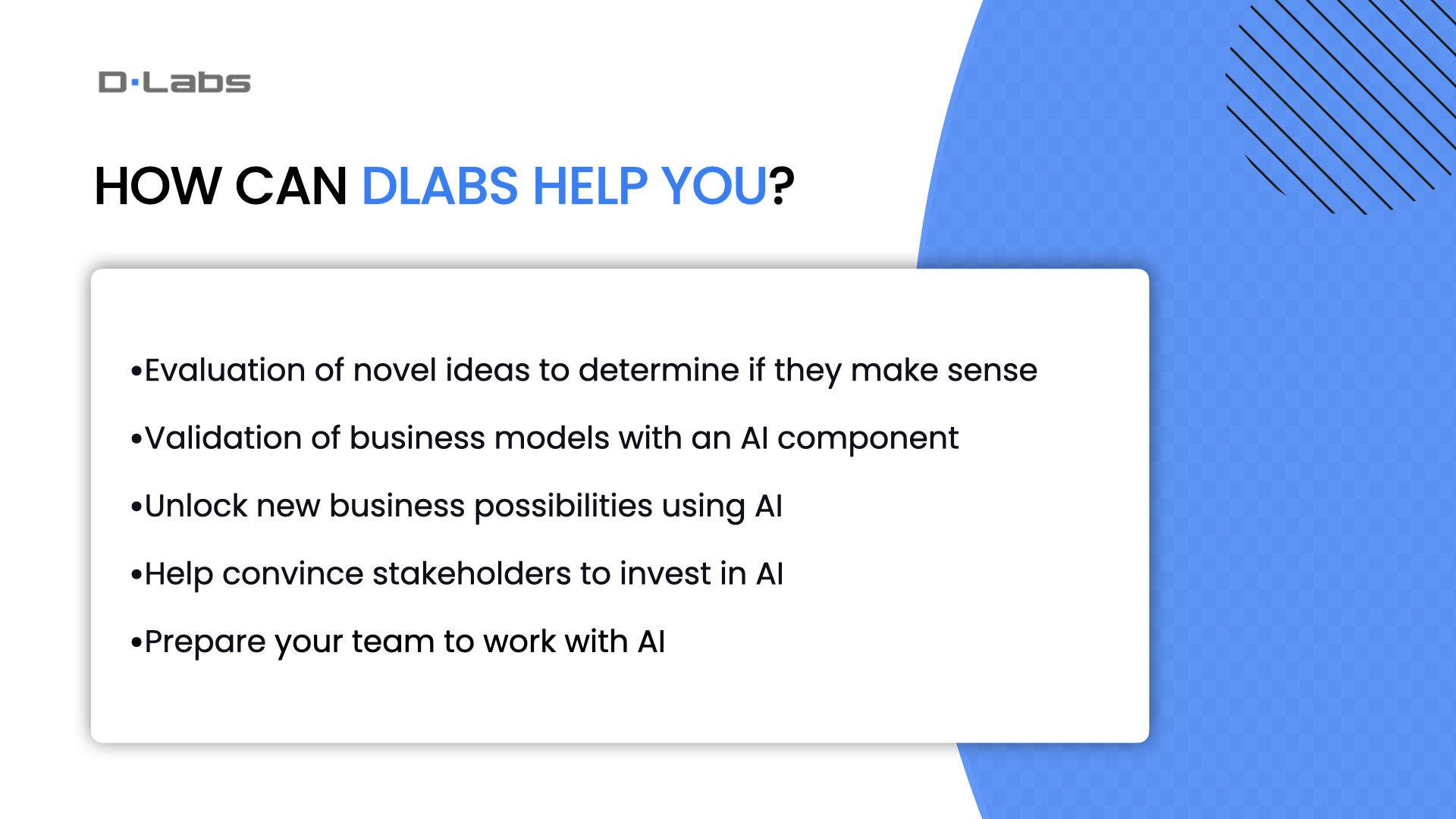
You see, while we’ve helped plenty of companies use AI to get better at what they already do, we’ve seen more radical changes where we’ve helped clients discover an entirely new business model. Because this has enabled them to monetize their brand via new products and services — which shows how alongside offering engineering skills, we also help clients:
Evaluate novel ideas and determine if they make sense or are even achievable, convince stakeholders to invest in AI, unlock new business possibilities using AI and suggest the highest ROI investment, actually implement AI, build the tech as well as prep the people and processes, which ensures the company hits the KPIs it wants.
As with anything — when you find a technology partner that can offer comprehensive support alongside technical skills, success is so much more likely, and nowhere is this more true than with artificial intelligence.
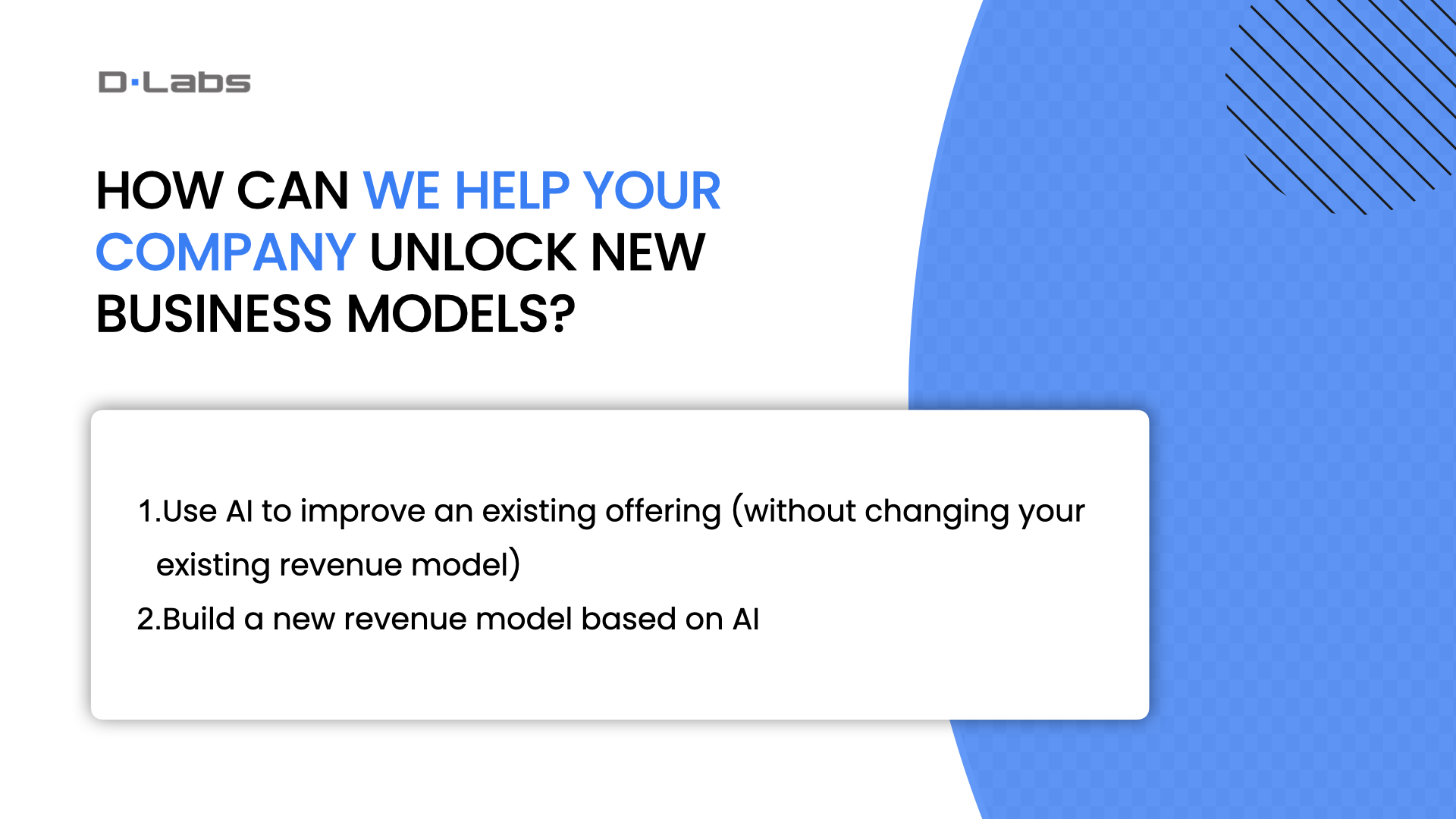
But let’s get back to the topic of this webinar, which is creating AI-based business models.
AI-based business models offer great potential in the healthcare market. The secondary healthcare market is becoming increasingly relevant, which has great potential with meaningful, high-quality AI applications in terms of monetization as well as for personal health and health maintenance. We can offer complex help with expanding your business models by optimizing existing and developing novel offerings with AI. And we can help you with AI-based improvement of an existing offering without changing your existing revenue model: we can help you improve, facilitate, and automate an existing offering with AI and differentiate your products.
And second, we can help you with building new revenue models for your novel AI offerings
The situation is different, for example, in the case of decision support systems, e.g., in the pre-classification of radiological image data: here, the use of AI enables a novel service. To monetize this, different business models can be examined – away from the licensing business with one-off payments to the „software-as-a-service“ business, rental model, or usage-dependent payments. At first glance, this benefits the providers of such solutions because they can forecast revenue much more precisely based on their user numbers over a longer period of time. Users also benefit from such service offerings through reduced costs for the maintenance and configuration of the software, for example, through the automatic provision and updating of the service via the internet or cloud applications.
In addition, the expenses for the services, which replace high one-off financing, are spread over the entire term. Very often, the business models are also supplemented by continuous product maintenance and include services such as protection against cyber-attacks and data loss. Using AI, we will help you identify such areas and choose the best business solutions for your business.
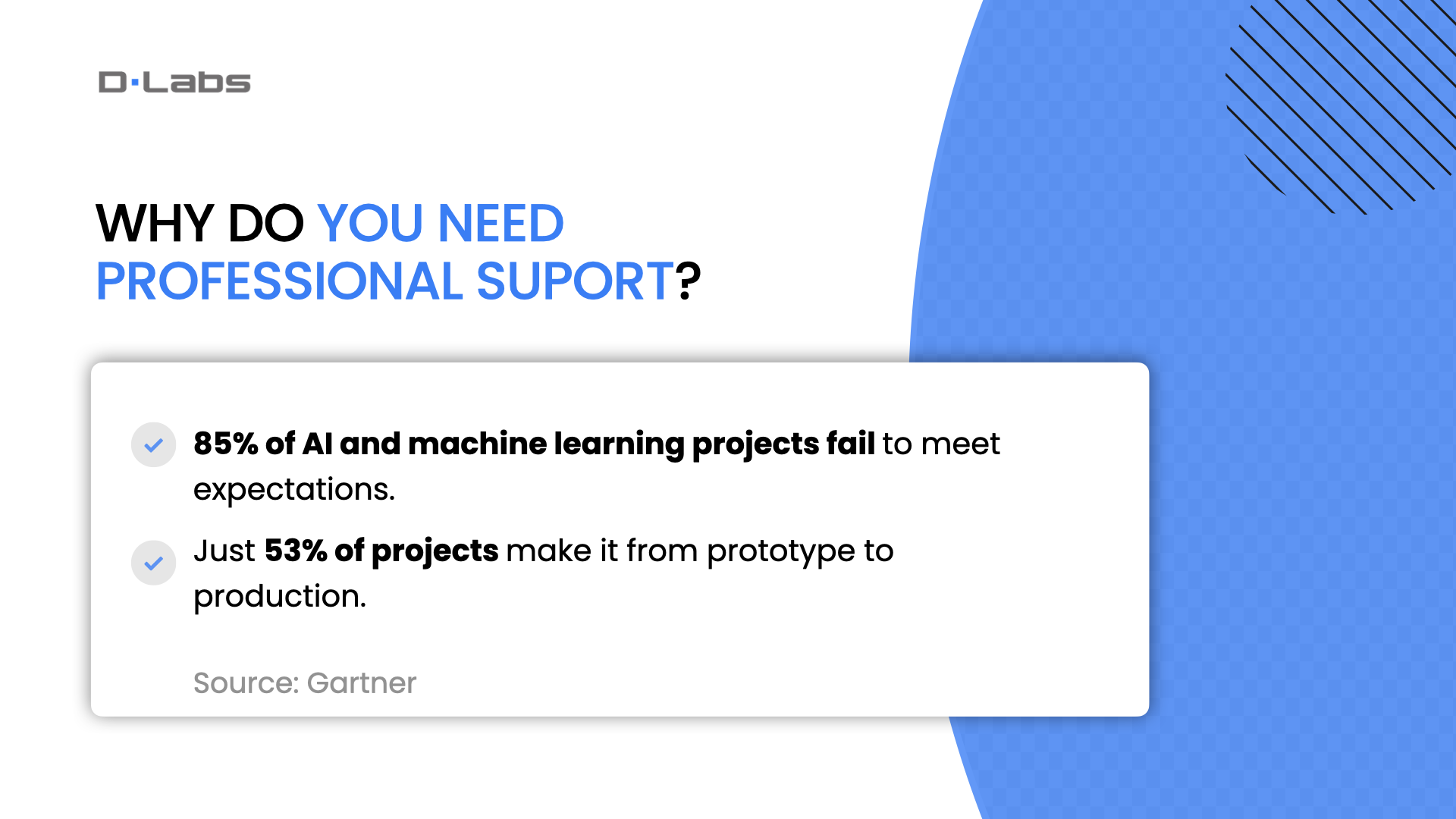
I often hear companies complain that they ‘invested a ton’ in AI but that, in the end, the risk didn’t pay off or worse, it all-out failed. And to be fair, the stats back up the claims as, according to Gartner, 85% of AI and machine learning projects fail to meet expectations. Just 53% of projects make it from prototype to production.
Our analytical and business competencies enable us to help you not only on the technology side but also with business goals. We will try to discover your needs, know your users, and find the best way to achieve the best business outcome for your project.
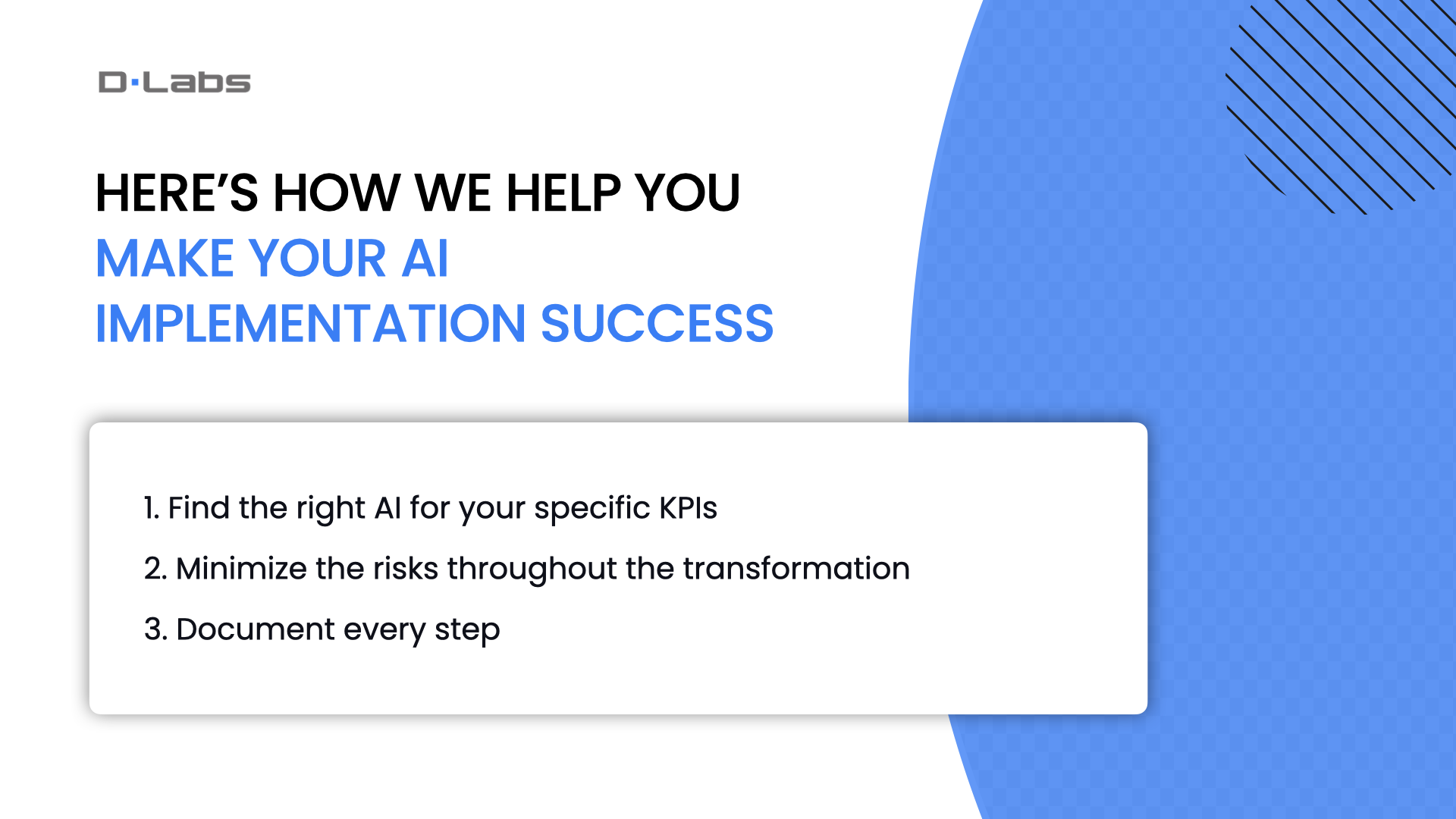
Most of the projects delivered by DLabs.AI were A-Z projects. Our true value is delivering digital transformation within an organization using AI. So here’s how we’ll be tackling projects moving forward:
First, find the right AI for the specific KPI: this allows companies to show employees the uplift they’ll get from the solution. Second, minimize risk throughout the transformation: any integration holds risk, but our experience helps us know when you’re heading down the wrong path. And third, document every step: knowledge-share is crucial to a successful transformation, which is why we work so hard to help employees get comfortable with the new technology.

Ok, thanks a lot for your attention. Let me check if there are any questions.
- Do you have experience with the certification process?
No, we don’t have direct experience with the certification process, meaning we haven’t been involved in the process. We have done some research in the past on what types of certification It would require in terms of our solution. There were 3 types of those as far as I remember FDA approvals/ certifications in terms of the US market. And we found under type 2 or B. I don’t remember the exact naming. But we have some people in the network that are doing this kind of certification, at least here in Poland, so if there is a need, I’m happy to share contacts or ask them to share some relevant info on how to conduct this processed depending of course on what kind of region you are considering or learn more because there is for sure one for European Union and there is for united states. Others I didn’t research.
Take care then, and again thanks for attending the webinar. And hope to stay in touch. I plan to set up a new webinar for the next year with some other topics, and it depends on some research. You can also share some notes or things you would like to hear. I would be happy to share. We also have experience in the educational market working with edtech companies, also with retail companies, also developing new business models when using AI for them, for those sectors, so I am thinking about pouting a webinar on those topics as well. But again, if you have any suggestions, I’m happy to take that into account.

Thank you! Take care, bye-bye.
Biblography
- Accenture
- GlobenewsWire
- Grand View Research
- Harvard Business School
- Health Affairs
- IDC
- McKinsey
- Medscape
- Regenstrief Institute
- Risk Manag Healthc Policy
- The Unmet Challenge of Medication Nonadherence
- U.S. News
- 4th Annual Optum Survey on AI in Health Care






















































































